Early Views of Los Angeles Landmarks
California Historical Landmarks in the County of Los Angeles |
NO. 567 - ST. VINCENT'S PLACE This was the site of Saint Vincent's College from 1868 to 1887. The college, now Loyola University, was founded by the Vincentian Fathers in 1865 and was the first institution of higher learning in Southern California. |
.jpg) |
|
| (ca. 1887)* - View of St. Vincent's College, circa 1887, located at Hill and Broadway, between 6th and 7th streets. It is believed that the left portion of building was erected for St. Vincent's College, and later, was the headquarters to General Miles of the U.S. Military Dept. of Arizona. |
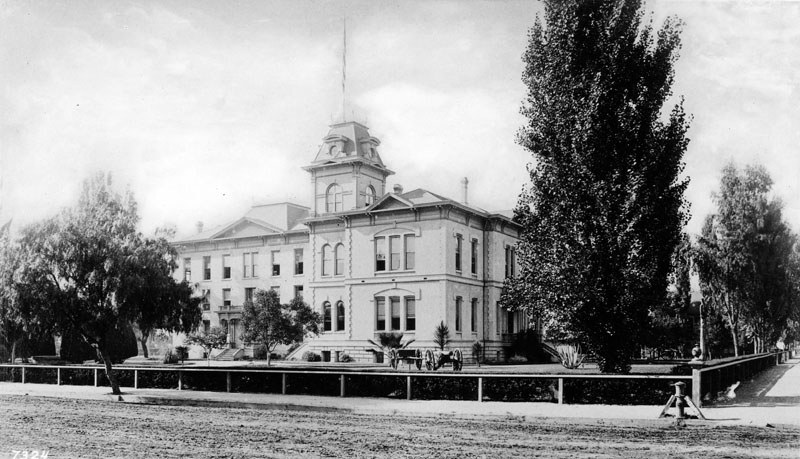 |
|
| (ca. 1887)* - View of St. Vincent's College, circa 1887. Location: St. Vincent Court, in alley between Broadway and Hill, and 6th and 7th Sts, Los Angeles. |
NO. 580 - WELL, ALAMITOS 1 One of the world's most famous wells. Started on March 23,1921, it flowed 590 barrels of oil a day when it was completed June 25, 1921, at a depth of 3,114 feet. This discovery well led to the development of one of the most productive oil fields in the world and helped to establish California as a major oil producing state. |
 |
|
| (1926)* - Two men sit on a car parked next to an oil field full of derricks in Signal Hill. A sign reading, "Pacific Coast Welding" is visible at the roofline of the small structure behind the car. Photo dated: Novermber 11, 1926. Alamitos Well 1 Location: NE corner of Temple Ave and Hill St, Signal Hill. |
Historical Notes Between 1913 and 1923 an early California movie studio, Balboa Amusement Producing Company (also known as Balboa Studios), was located in Long Beach and used 11 acres on Signal Hill for outdoor locations. Buster Keaton and Fatty Arbuckle were two of Balboa Studio actors who had films shot on Signal Hill. Before oil was discovered in Signal Hill, there were large homes built on the hill itself, and in the lower elevations was an agricultural area where fruits, vegetables, and flowers were grown. Many of the truck farmers were Japanese.*^ |
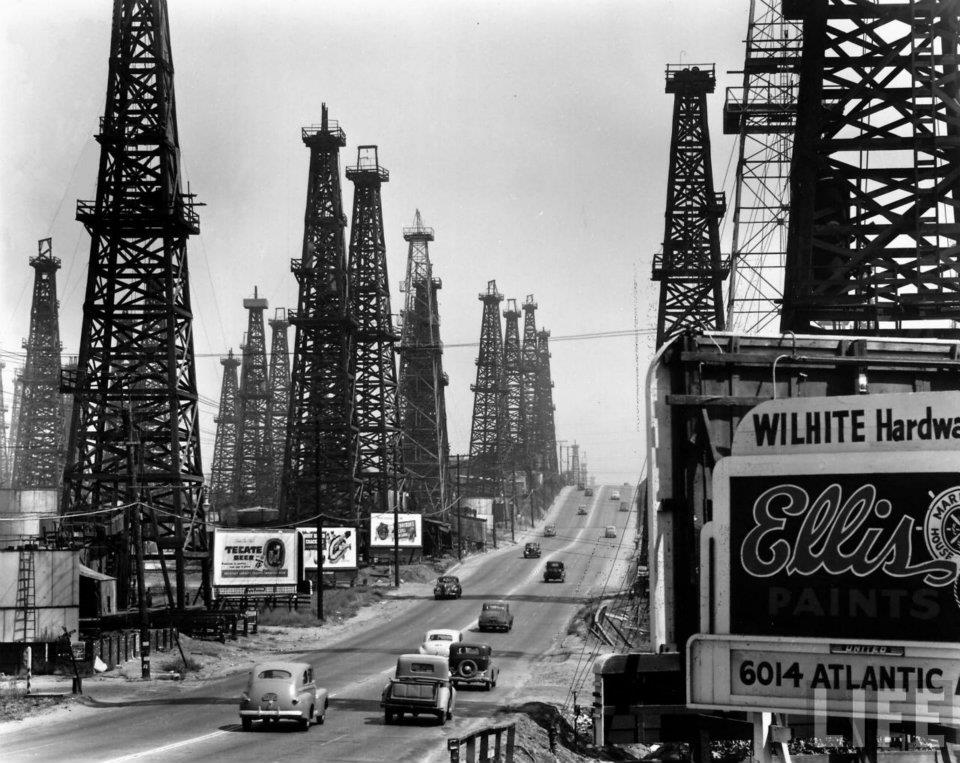 |
|
| (ca. 1940s)*^*^ - Signal Hill in the early 1940s. |
Historical Notes Signal Hill changed forever when oil was discovered. The hill would soon become part of the Long Beach Oil Field, one of the most productive oil fields in the world. On June 23, 1921, Shell Oil Company's Alamitos #1 well erupted. The gas pressure was so great the gusher rose 114 ft. in the air. Soon Signal Hill was covered with over 100 oil derricks, and because of its prickly appearance at a distance became known as "Porcupine Hill". The City of Signal Hill is completely surrounded by the city of Long Beach. It was incorporated on April 22, 1924, roughly three years after oil was discovered there. Among the reasons for incorporating was avoiding annexation by Long Beach with its zoning restrictions and per-barrel oil tax. Signal Hill's first mayor, Jessie Nelson, was California's first female mayor. As of the 2010 census, the city population was 11,465.*^ |
NO. 590 - LANG On September 5, 1876, Charles Crocker, President of the Southern Pacific Company, drove a gold spike here to complete his company's San Joaquin Valley line, the first rail connection of Los Angeles with San Francisco and transcontinental lines. |
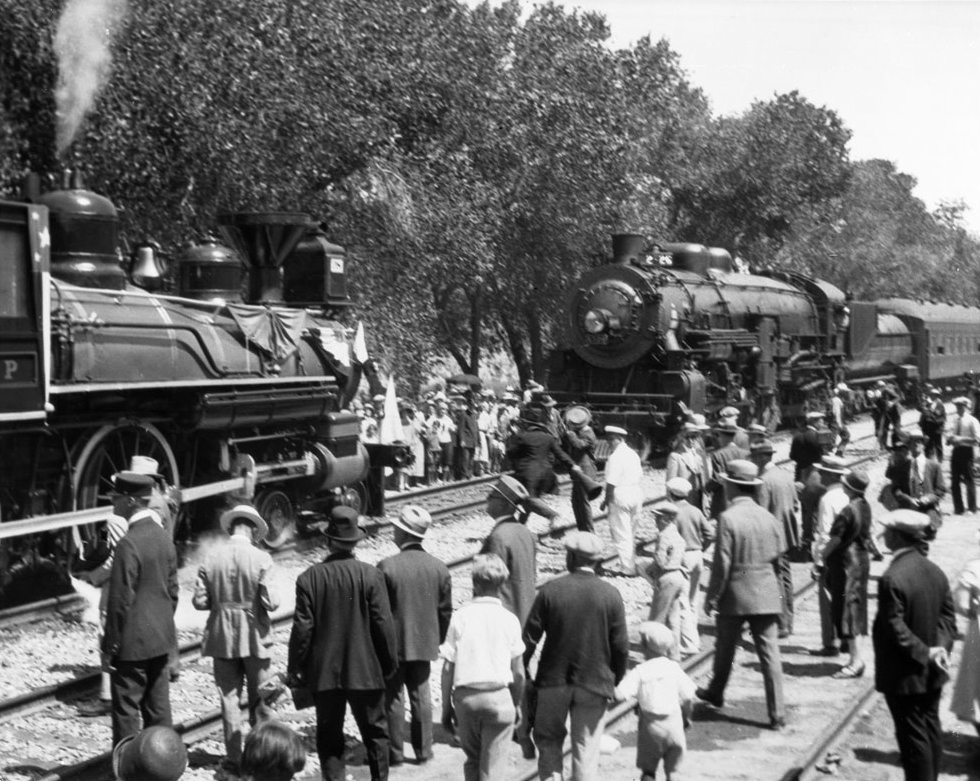 |
|
| (1926)^^ - Crowd of onlookers on the tracks in front of two engines at the recreation of the Southern Pacific Line's completion, September 5, 1926. |
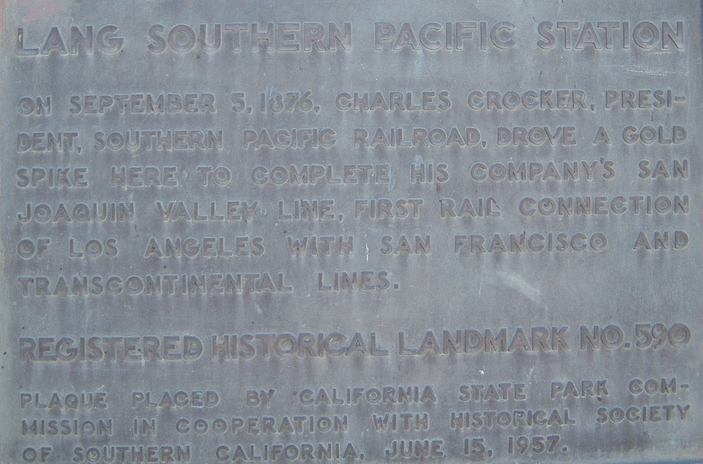 |
|
| (2008)*^^ - Lang Southern Pacific Station Marker. Location: Soledad Canyon, Lang Station Rd, 0.4 mi S of State Hwy 14 (P.M. 35.6), Shadow Pines Blvd, 4. 7 mi E of Canyon Country. |
* * * * * |
NO. 632 - OLD SHORT CUT This is California's first ranger station, built in 1900 by Louie Newcomb and Phillip Begue, early Forest Service men. The cabin took its name from the 'Short Cut Canyon Trail,' as the cabin was one of the main stopping points on this trail. |
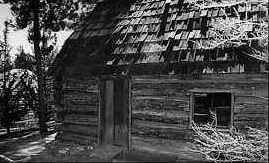 |
This cabin was built in 1900 by Ranger Louie Newcomb, and was the first Forest Service ranger station in the San Gabriel Mountains - the second in the United States. The cabin was originally located where Shortcut Canyon joins the West Fork, and was moved here (Chilao Visitor's Center) and restored in the early 1980's. It stands as a memorial to the pioneers whose job it was to manage and protect the San Gabriel Timberland Reserve (renamed the San Gabriel National Forest in 1907, and the Angeles National Forest in 1908).**^ |
| Location: Angeles National Forest, Chilao Visitor's Center, Angeles Crest Hwy (State Hwy 2), 27 mi E of La Canada. |
NO. 637 - CATALINA ADOBE San Rafael was granted to José María Verdugo on October 20, 1784. Don José died April 12, 1831, leaving his estate to his son Julio and his blind daughter Catalina. This adobe was built for Dona Catalina in the 1830s; she lived here until her death in 1861. Still in excellent condition, the Catalina, or Original Mud Block, Adobe is now in private ownership. |
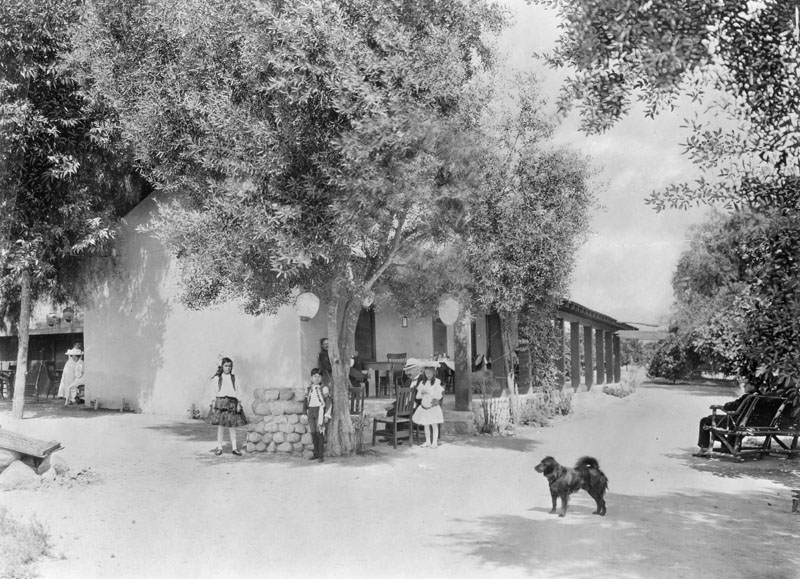 |
|
| (1895)* - Children, adults and a dog outside the Catalina Verdugo adobe in Glendale in 1895, under the old olive trees. It was at the time the Casa Verdugo Restaurant. Location: 2211 Bonita Dr, Glendale |
Historical Notes Jesus Pico, representing Lieutenant Colonel Fremont and the United States met with his brother, General Andres Pico, commander of the Mexican army on the Verdugo Adobe property in January 1847, and recommended that they surrender to the United States due to the size and strength of Fremont's Army. Terms of the surrender were discussed and agreed upon under the large oak (“Oak of Peace”) located 30 yards from the Catalina Adobe. The actual signing of the treaty came two days later, near what is now the Hollywood Bowl. Many consider the "Oak of Peace" to be the birthplace of California.+# |
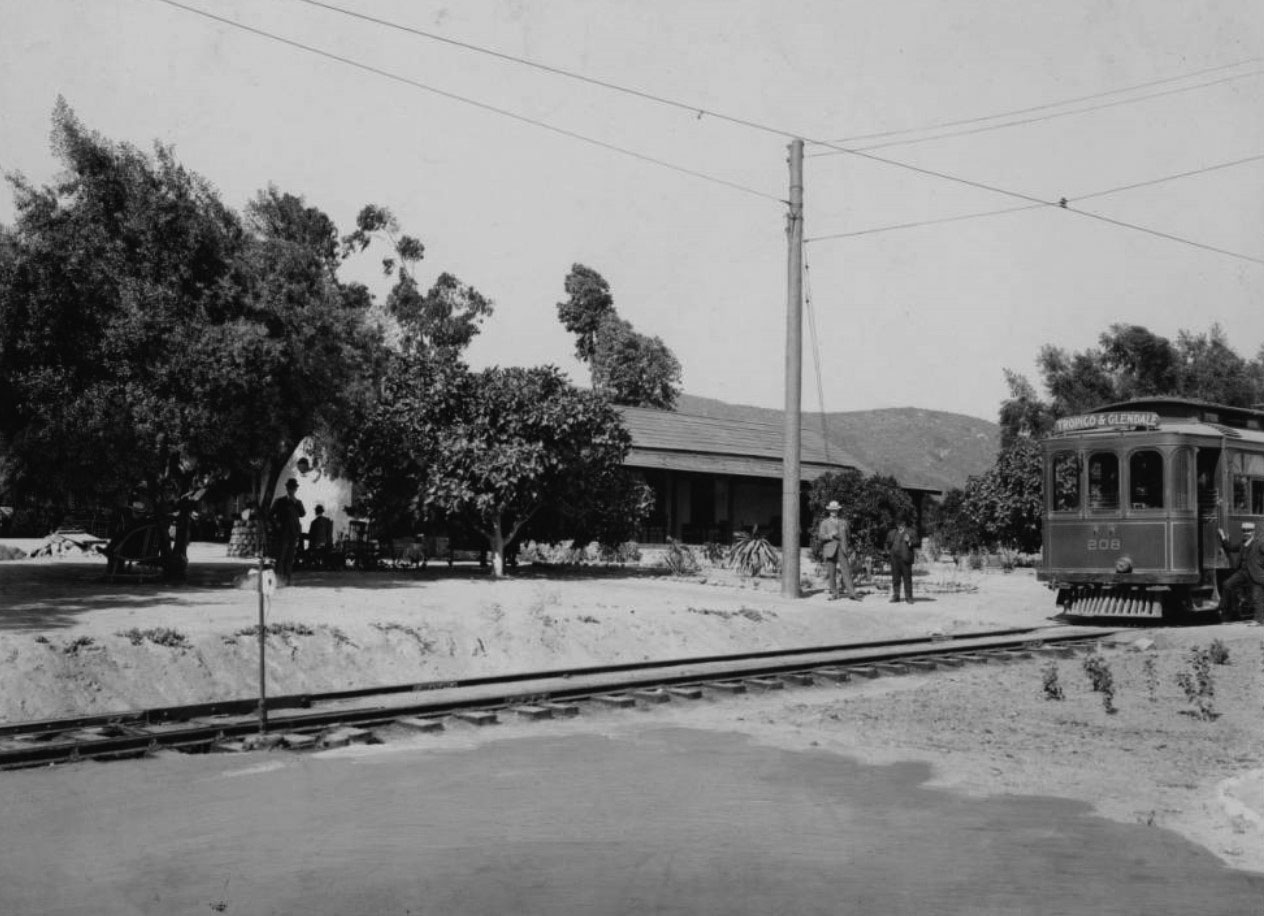 |
|
| (ca. 1900)^^ – View showing a "Tropico & Glendale" electric car outside Casa Verdugo adobe (Catalina Verdugo Adobe) in Glendale. The conductor stands outside of his electric car on the right with the tracks in front of him leading to the left foreground. Two more men stand next to an electrical pole at center while others sit under the shade of trees at left. The adobe can barely be seen through the trees. |
Historical Notes After a series of ownership changes, the property was sold to land developer, F.P. Newport. Newport knew of the historical value of the adobe and was careful to preserve it. The property was later sold to Dr. Ernest Bashor and remained in the Bashor family until it was sold to the City of Glendale in 1989.+# |
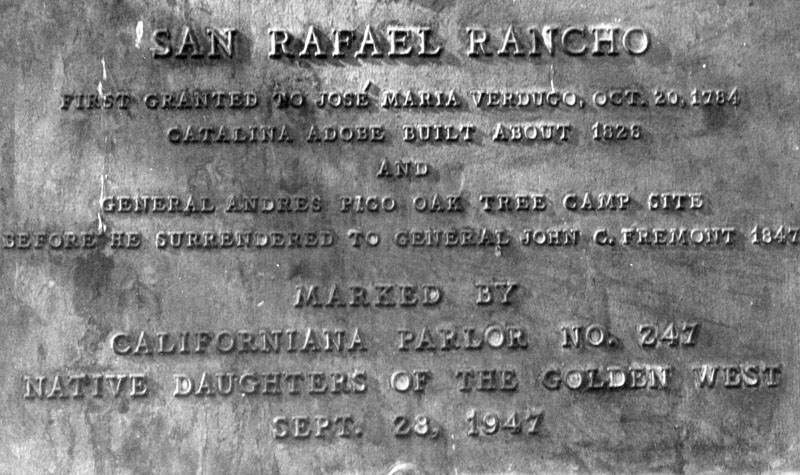 |
|
| (1947)* - A plaque mounted at the Catalina Verdugo adobe in Glendale states that the San Rafael Rancho was first granted to Jose Maria Verdugo on October 20, 1784. The Catalina adobe was built about 1825, and the oak tree was General Andres Pico's camp site before he surrendered to General John C. Fremont in 1847. Marked by California Parlor No. 247, Native Daughters of the Golden West, September 28, 1947. |
NO. 646 - GRAVE OF GEORGE CARALAMBO, (GREEK GEORGE) This is the grave of 'Greek George,' a camel driver from Asia Minor who came to the United States with the second load of camels purchased by the War Department as an experiment to open a wagon road to Fort Tejón from Fort Defiance, New Mexico. Because of the Civil War, the experiment was abandoned. 'Greek George' became a naturalized citizen in 1867 under the name of George Allen. He built an adobe home on Santa Monica Boulevard. |
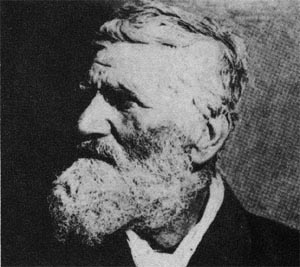 |
||
(? - September 2, 1913)*^ - Yiorgos (or George) Caralambo was a camel driver hired by US Army in 1856 for the Camel Corps experiment in the Southwest. The camels were to be tested for use in transportation across the "Great American Desert." Location: Founders' Memorial Park, Broadway at Gregory Ave, Whittier (gravestone in storage, 1993). |
* * * * * |
NO. 653 - THE CASCADES This is the terminus of the Los Angeles-Owens River Aqueduct, which brings water 338 miles from the eastern slopes of the Sierra Nevada to the City of Los Angeles. Begun in 1905, the great aqueduct was completed November 5, 1913. The Mono Craters Tunnel project, completed in 1940, extended the system 27 miles to its present northernmost intake near Tioga Pass. |
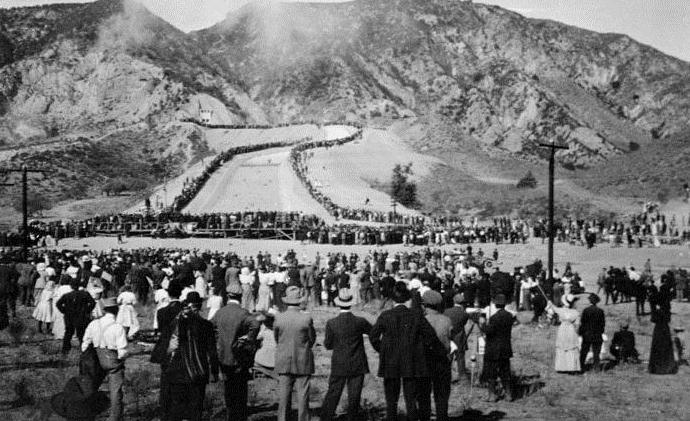 |
|
| (1913)** - Crowds watch as the water gates are opened and the Los Angeles Aqueduct water starts to flow down into the San Fernando Valley. William Mulholland, builder of the aqueduct and H. A. Van Norman, Chief Engineer and General Manager, Water Bureau. |
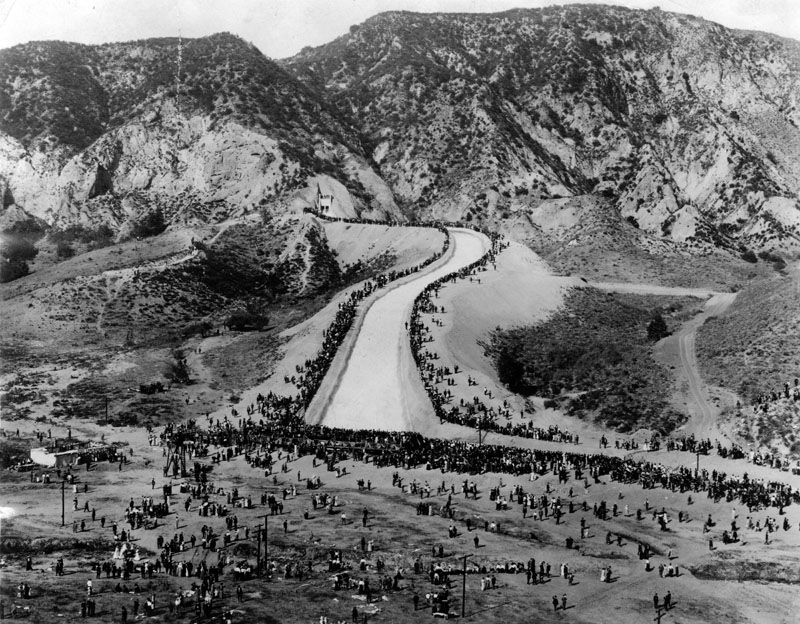 |
|
| (1913)** - Photograph caption reads: "Southern California's tremendous growth necessitated the building of the great Owens Valley aqueduct. This photo shows a crowd at its dedication, Nov. 5, 1913. "To care for future water needs of this area citizens of 13 cities prepare to vote on the bonds to build the world's greatest aqueduct to carry Owens River river water 226 miles across desert and mountains". Location: 0.1 mi N of intersection of Foothill Blvd and Balboa Blvd, 4 mi NW of San Fernando. |
Click HERE to see more in Construction of the LA Aqueduct |
NO. 655 - PORTOLÁ TRAIL CAMPSITE (I) Spanish colonization of California began in 1769 with the expedition of Don Gaspar de Portolá from Mexico. With Captain Don Fernando Rivera v Moncada, Lieutenant Don Pedro Fages, Sgt. José Francisco Ortega, and Fathers Juan Crespí and Francisco Gómez, he and his party camped near this spot on August 2, 1769, en route to Monterey. Location: Elysian Park entrance, NW corner of N Broadway and Elysian Park Dr, Los Angeles. |
| Oil painting of Gaspar of Portolá. He was painted about 1770.*^ |
* * * * * |
NO. 656 - BELLA UNION HOTEL SITE Near this spot stood the Bella Union Hotel, long a social and political center. Here, on October 7, 1858, the first Butterfield Overland Mail stage from the east arrived 21 days after leaving St. Louis. Warren Hall was the driver, and Waterman Ormsby, a reporter, the only through passenger. |
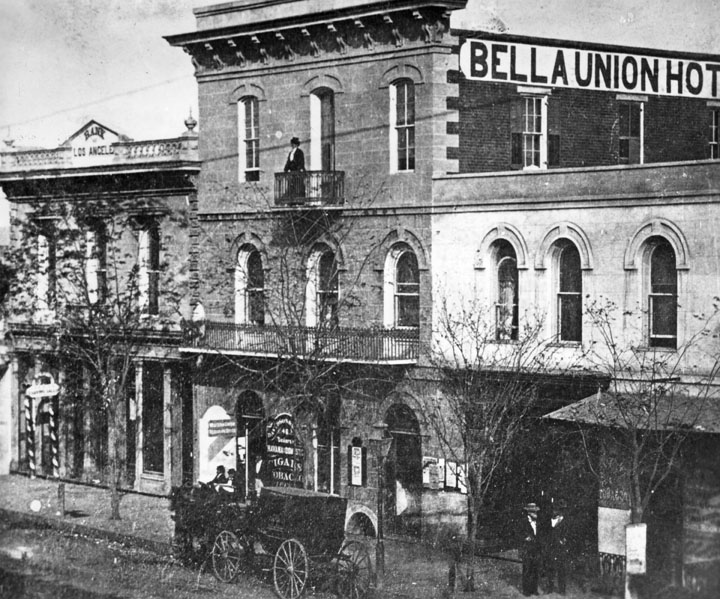 |
|
| (ca. 1867)* - The Bella Union at 314 N. Main St. later became the St. Charles Hotel. To the left is the original home of Farmers and Merchants Bank, later merged into Security Pacific Bank. Standing on the balcony is Mrs. Margarita Bandini Winston, owner of the hotel. |
Historical Notes In the 1840s, a one-story adobe owned by Benjamin Davis Wilson stood here. It later became the last capitol of Mexican Alta California. The building served as quarters for American troops in the late 1840s, a saloon, a courthouse (LA's 1st Courthouse), and a commercial coach hub operated by Phineas Banning. In 1851, a second story was added, and a third in 1869.* |
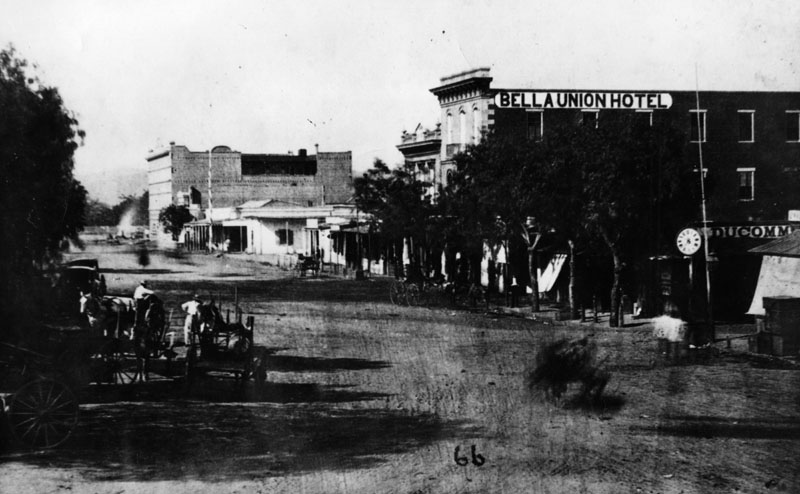 |
|
| (ca. 1870)* - View of North Main Street taken after erecting Pico House, but before completion of Merced Theater. The Bella Union Hotel can be seen at right-center of photo. |
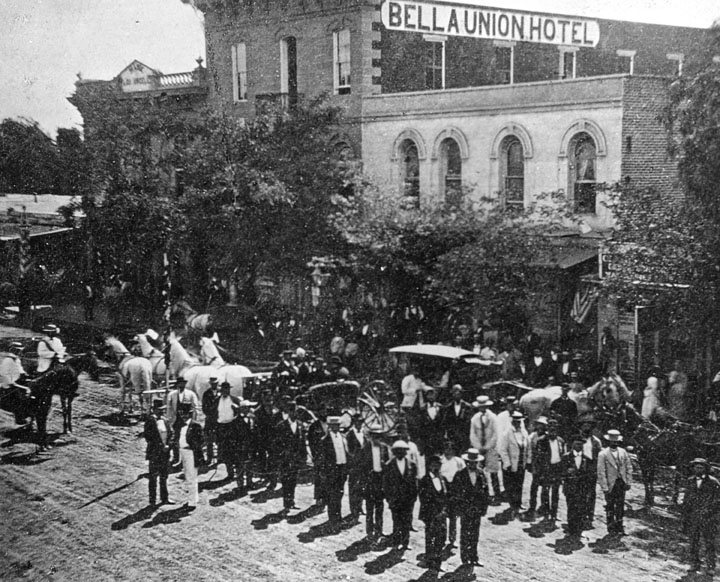 |
|
| (1871)* - A 4th of July parade on North Main Street of the Veterans of the War of 1812. Men are seen in two lines standing in the street, horses and carriages waiting and people on the sidelines. The Bella Union Hotel in the background is partially obscured by trees. |
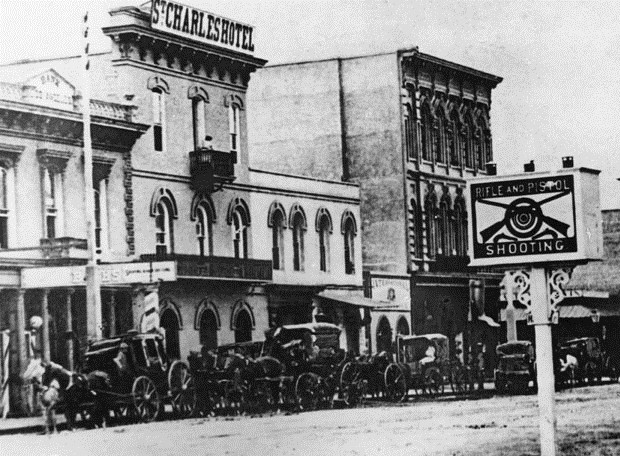 |
|
| (ca. 1875)* - Exterior view of the St. Charles Hotel, originally the Bella Union Hotel. Horses and buggies are lined up along the street. In the foreground a sign reads, “Rifle and Pistol Shooting,” a reminder that Los Angeles was a Western frontier town. |
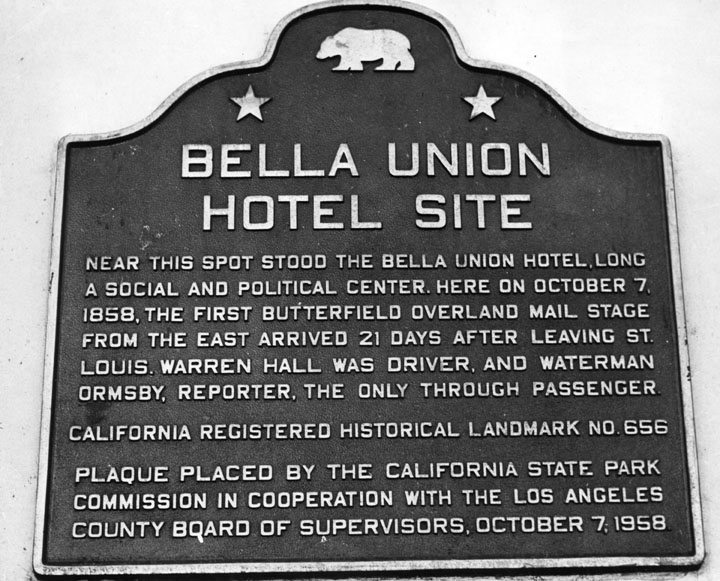 |
|
| (1958)* - Location: Fletcher Bowron Square, 300 block of N Main, between Temple and Aliso Sts, Los Angeles. |
* * * * * |
N0. 658 - WESTERN HOTEL Erected by the Gilroy family in 1876, this building was purchased in 1902 by George T. Webber, who operated it as the Western Hotel. The Lancaster Chamber of Commerce was organized in its dining room. Between 1905 and 1913, construction crews of the Los Angeles-Owens River Aqueduct were housed here, and it became a center of commercial and social activity in the early life of the community. |
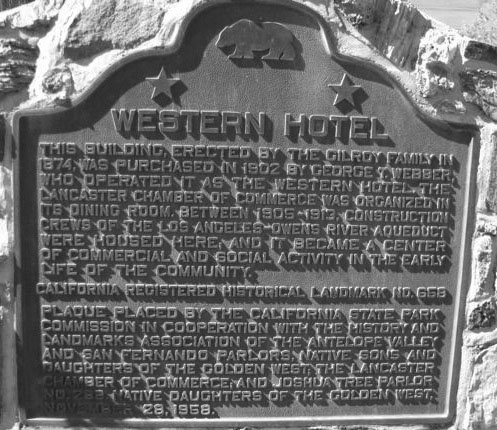 |
|
| (2012)*^^ - Western Hotel Marker. Location: 557 W Lancaster Blvd, Lancaster |
* * * * * |
NO. 664 - HERITAGE HOUSE As originally built in 1869 by A. R. Loomis, the house had only two rooms, but other rooms were added by subsequent occupants. It was marked as the 'Oldest House in Compton' in 1955 - in 1957, it was purchased by the city and moved from 209 South Acacia Street to its present site. It has been restored, refurnished, and renamed by the citizens of Compton as a tribute to early settlers of the community.
Location: NW corner of Willowbrook Ave and Myrrh St, Compton |
NO. 665 - PORTOLÁ TRAIL CAMPSITE, 2 The expedition of Don Gaspar de Portolá from Mexico passed this way en route to Monterey to begin the Spanish colonization of California. With Captain Don Fernando Rivera y Moncada, Lieutenant Don Pedro Fages, Sergeant José Francisco Ortega, and Fathers Juan Crespí and Francisco Gómez, Portolá and his party camped near this spot on August 3, 1769. |
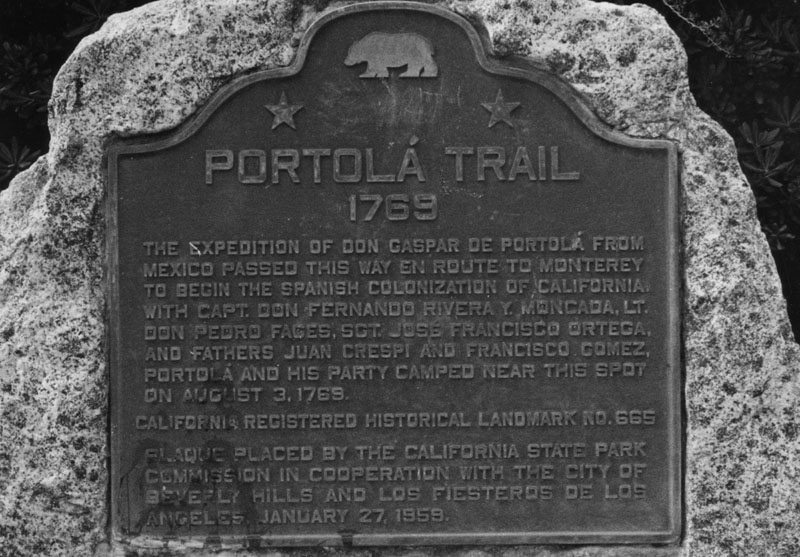 |
|
| (n.d.)* - Plaque commemorating the Portolá Trail, where an expedition from Mexico passed on their way north to Monterey. Location: 325 South La Cienega Blvd between Olympic and Gregory, Beverly Hills. |
 |
|
| Map of Gaspar de Portola's route from San Diego to San Luis Obispo in 1769, projected on a modern map.^^ |
NO. 669- GOVERNOR STONEMAN ADOBE, LOS ROBLES This was the site of 'Los Robles,' the 400-acre estate of Governor George Stoneman. President Rutherford B. Hayes was entertained here in 1880. The first schoolhouse in the San Gabriel Valley, California's first tennis club, and the first municipal Christmas tree of San Marino were located here.
|
 |
|
| (1863)*^ - Union General George Stoneman (center) & staff, 1863. George Stoneman, Jr. was a career United States Army officer, a Union cavalry general in the American Civil War, and the 15th governor of California between 1883 and 1887. |
* * * * * |
NO. 681 - PARADOX HYBRID WALNUT TREE Planted in 1907 by George Weinshank and assistants under the direction of Professor Ralph Smith as part of an experimental planting for the University of California Experiment Station, this tree stands as a monument to the early cooperation of state educational system with local walnut industry. |
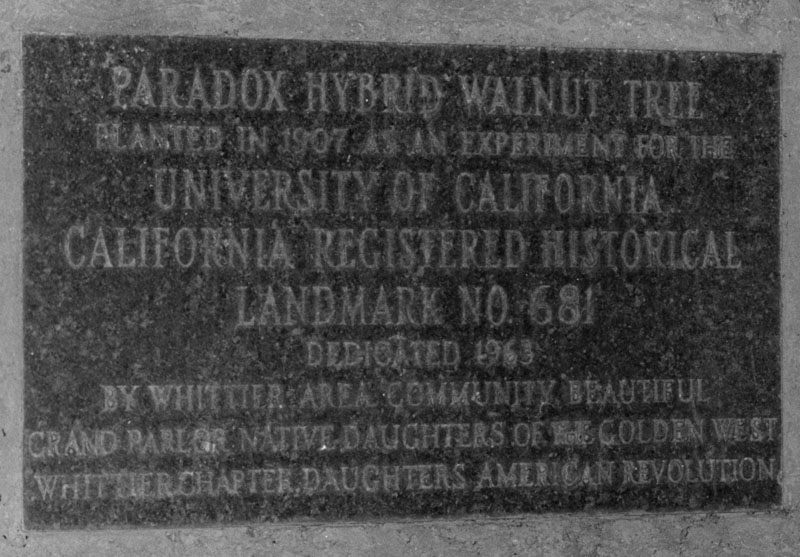 |
|
| (n.d.)* - Plaque commemorating a Paradox hybrid walnut tree planted in 1907 as an experiment for the University of California. It was dedicated in 1963 as California Registered Historical Landmark No. 681 by Whittier Area Community Beautiful; Grand Parlor, Native Daughters of the Golden West; and Whittier Chapter, Daughters of the American Revolution. Location: 12300 Whittier Blvd at Mar Vista, Whittier USGS Quadrangle Sheet Name: VENICE. |
* * * * * |
NO. 688 - LYONS STATION STAGECOACH STOP This site was the location of a combination store, post office, telegraph office, tavern, and stage depot accommodating travelers during the Kern River gold rush in the early 1850s. A regular stop for Butterfield and other early California stage lines, it was purchased by Sanford and Cyrus Lyons in 1855, and by 1868 at least twenty families lived here. Eternal Valley Memorial Park has called their final resting place "The Garden of the Pioneers."
|
NO. 689 - LOS ENCINOS STATE HISTORIC PARK The Franciscan padres used Encino as their headquarters while exploring the valley before establishing Mission San Fernando in 1797. In 1849 Vincente de la Osa built an adobe with nine rooms. The next owner of El Encino Rancho was Eugene Garnier, who built the existing two-story limestone house in 1872. In December 1891 Domingo Amestoy acquired the property. |
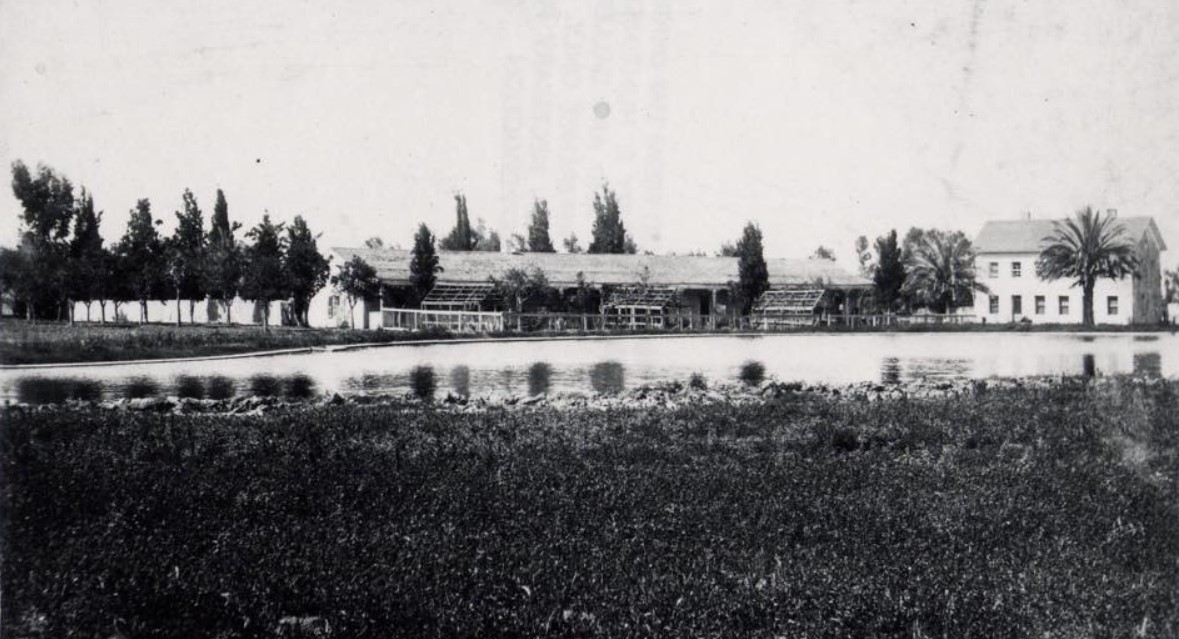 |
|
| (1880s)*^*^* - Panoramic view showing Rancho Los Encinos. This is the best surviving photograph of Rancho Los Encinos during its time of greatest prosperity. All the key elements of the current park are visible, as well as some interesting frame structures (probably used for grapevines) and a fence or structure running West from the South end of the De La Ossa adobe. |
Historical Notes Because of its water supply from a natural spring, the Franciscan padres used Encino as their headquarters while exploring the valley before establishing Mission San Fernando in 1797. In 1849 Vincente de la Osa built an adobe with nine rooms on Rancho Los Encinos. Twenty years later (1869), Eugene Garnier bought Rancho Los Encinos and, in 1872, built a French Provincial two-story limestone house adjacent to the existing adobe. He was a French Basque and the house was similar to those in his homeland.#^ The Garniers were energetic builders, and added much to the Rancho. They built a stone-lined pond, in the shape of a Spanish guitar at the site of the spring; they built a two story limestone building to serve as a bunkhouse and they built a roadhouse across the road (Ventura Blvd.) which became the focal point of the local Basque community.*^*^* |
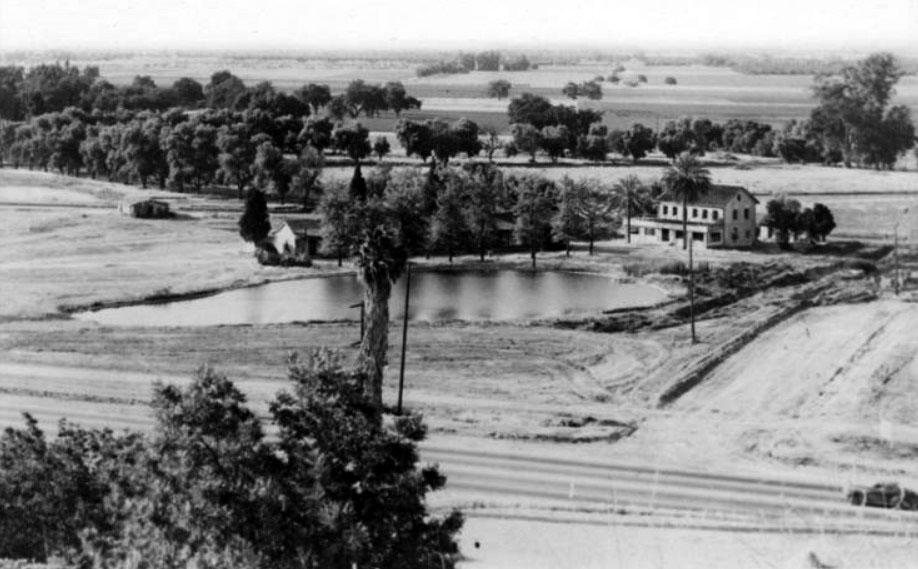 |
|
| (ca. 1945)#^ - View looking north of the Garnier House at Rancho Los Encinos. |
Historical Notes The name of the rancho comes from the original designation of the San Fernando Valley by the Portola expedition of 1769: "El Valle de Santa Catalina de Bononia de los Encinos", with "encino" being the Spanish word for oak, referring to the many oak trees in this area, to include a fair number which still exist on the site.*^*^* |
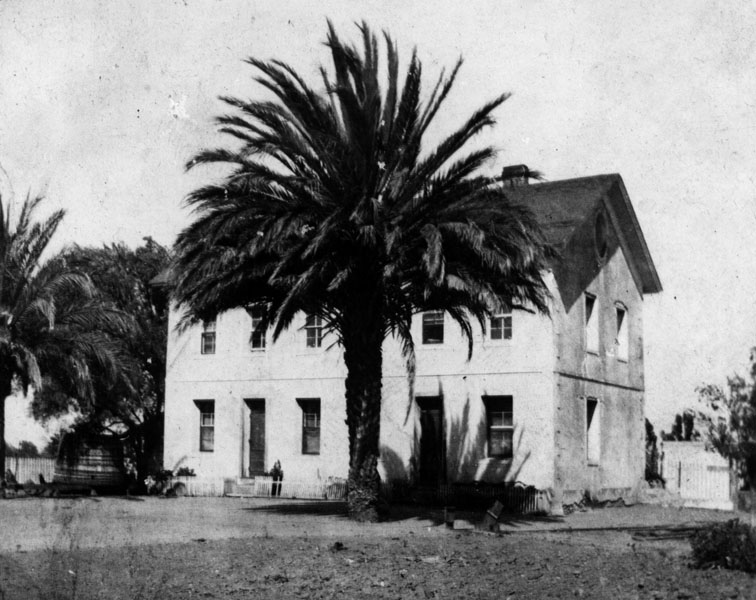 |
|
| (1900)* - Exterior view of Rancho Encino's Garnier House, built in 1872 by French Basque sheepman, Eugene Garnier. The home is a replica of his French home. |
Historical Notes In 1889 Domingo Amestoy acquired all 4,500 acres of Rancho Los Encinos. After his death in 1892, his sons, John and Peter Amestoy, assumed ranch operations and changed the name to Amestoy ranch. Like other ranches in the San Fernando Valley at the time, the Amestoys cultivated wheat and barley. The Amestoy family held title to rancho for fifty-five years.*^ Amestoy Avenue in the San Fernando Valley was named in honor of Domingo Amestoy. Louise Avenue was named after Louise Amestoy, a daughter of Domningo and Marie Amestoy.*^*^* |
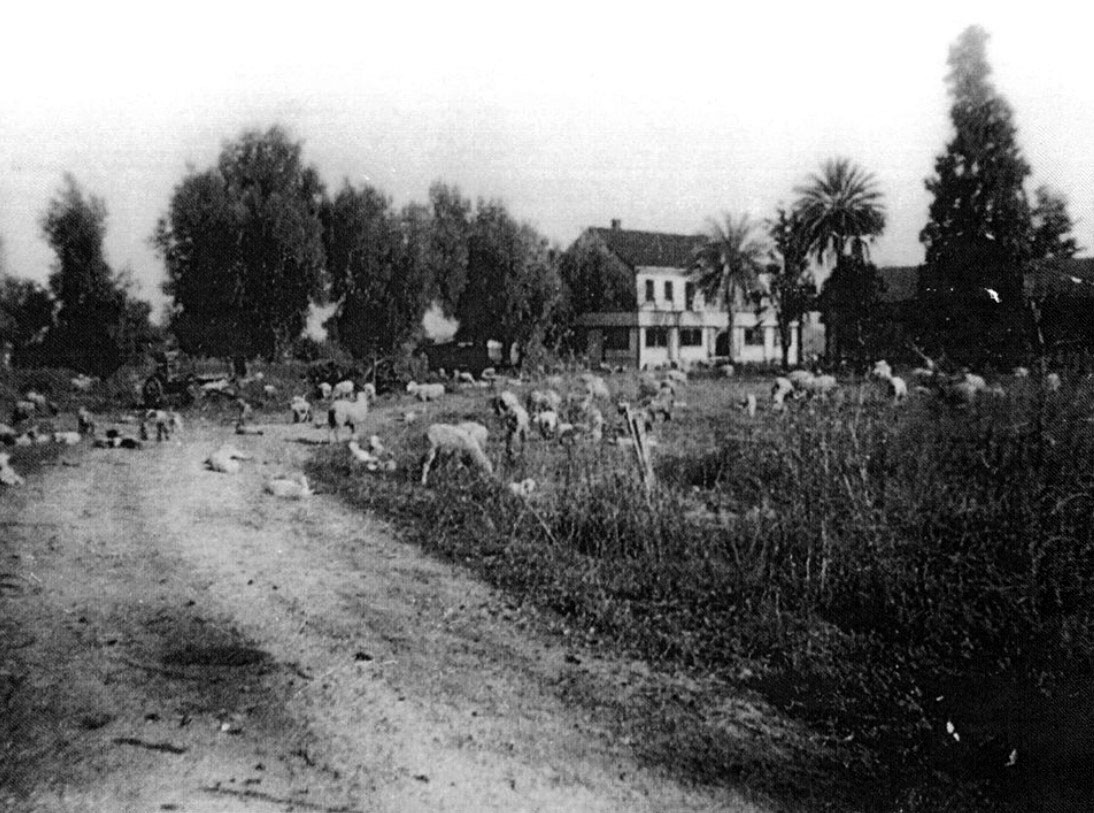 |
|
| (1920s)#^*^ - View showing sheep grazing near the Garnier House. |
Historical Notes In 1916, 1,170 acres of land were sold from Rancho Los Encinos. This parcel was subdivided and became the city of Encino.* The Amestoys held on to 100 acres, which included the old adobe until selling the property in 1944.*^ |
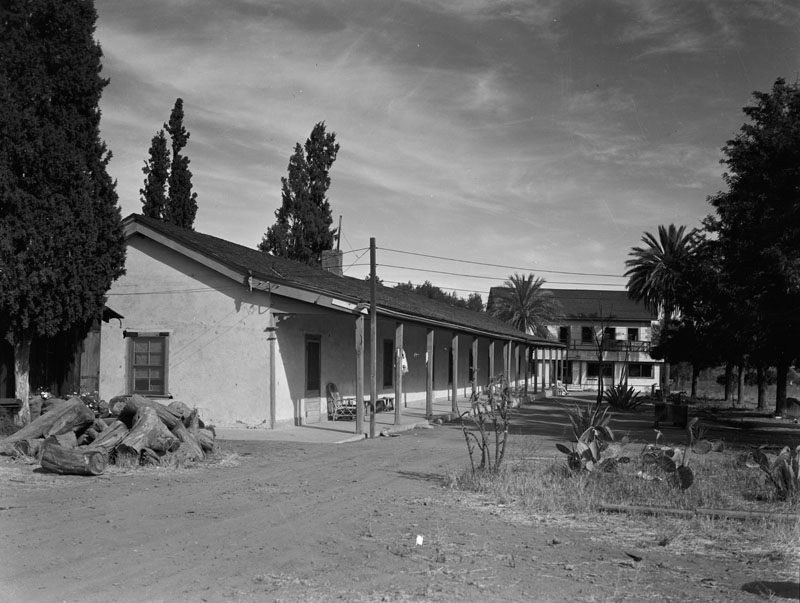 |
|
| (ca. 1935)* - Exterior view of Rancho Encino adobe, built in 1849 by Don Vicente de la Osa on land under the jurisidiction of Mission San Fernando Rey, founded in 1797. The Garnier House is seen in the distance behind the adobe. |
Historical Notes In 1949, through the efforts of Mary Stuart in mobilizing the local community to save the buildings from developers, the last remaining parcel of land, containing the De La Osa adobe, Garnier House and spring were purchased by the State of California, and the Los Encinos State Historic Park was created. *^*^* |
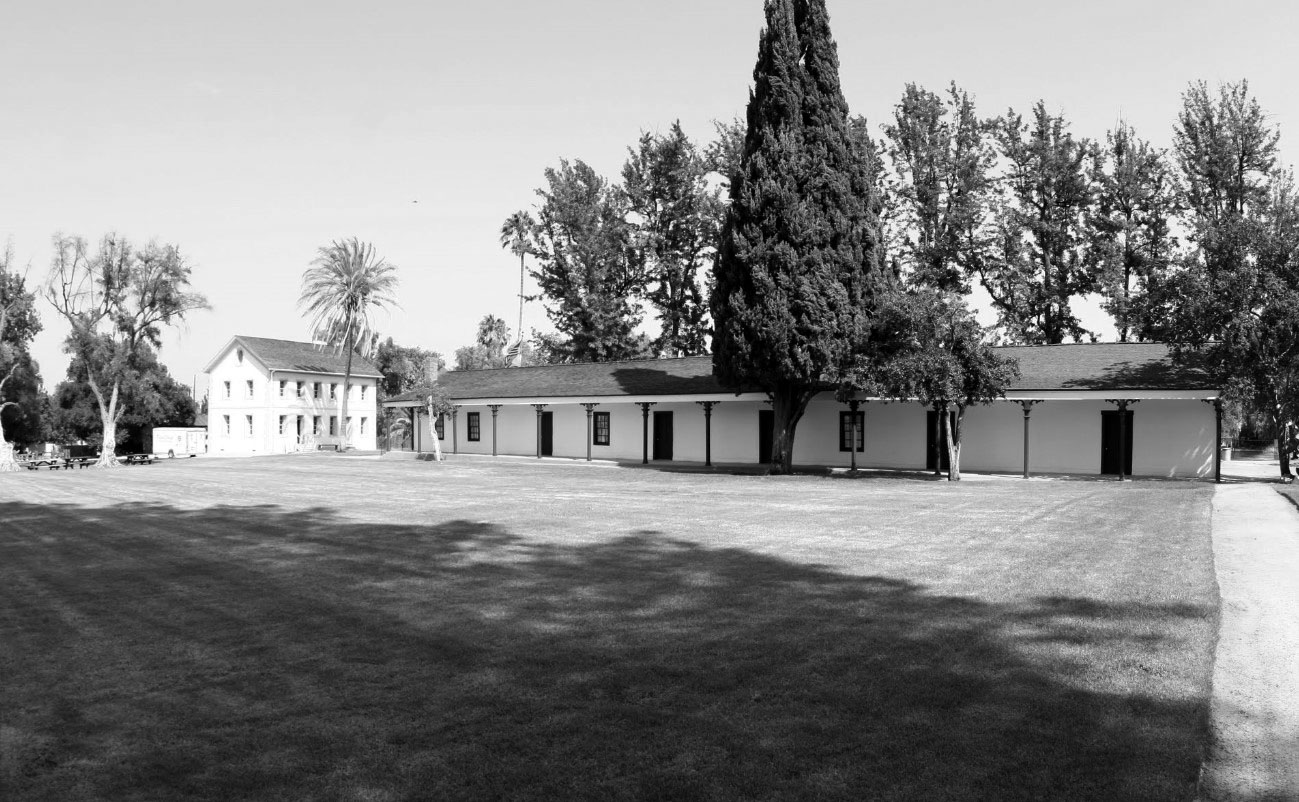 |
|
| (2014)#*^# – View of Los Encinos State Park with the Garnier Building on the left and the Rancho Encino adobe at center. Location: 16756 Moorpark Street, Encino. |
Historical Notes The Visitors' Center in the Garnier Building is open for self-guided tours during regular park hours. The park is opened Wednesday through Sunday between 10 AM and 5 PM. Admission is free, but donations are encouraged. Click HERE to see more. |
NO. 716 - GRIFFITH RANCH Originally part of the San Fernando Mission lands, this ranch was purchased by David Wark Griffith, revered pioneer of silent motion pictures, in 1912. It provided the locale for many western thrillers, including Custer's Last Stand, and was the inspiration for the immortal production, Birth of a Nation. In 1948 it was acquired by Fritz B. Burns, who has perpetuated the Griffith name in memory of the great film pioneer. |
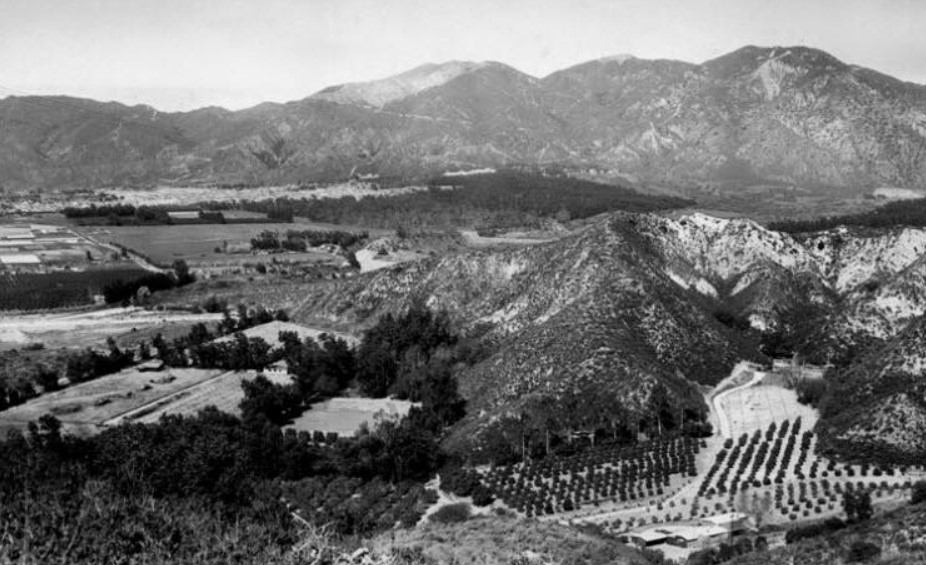 |
|
| (1957)* – Panoramic view from a spot near today's 210/118 Freeways. The photo was taken from the ridge flanking Lopez Canyon and shows the large ranch of Fritz Burns (previously the Griffith Ranch) with a new subdivision in the far background sweeping in from the San Gabriel Mountains. The charred area on the mountain top is above Olive View Sanitarium in Sylmar. |
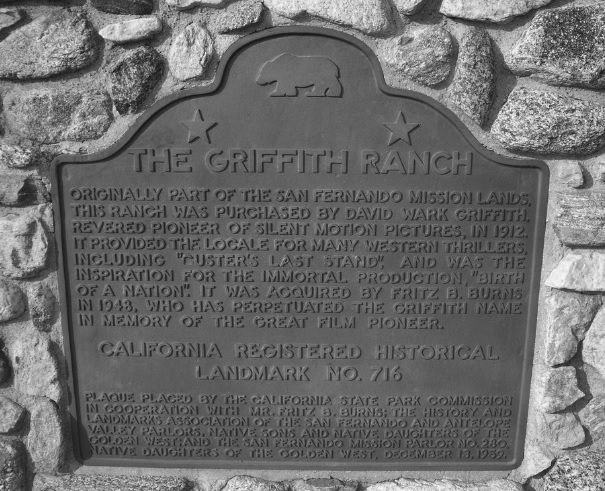 |
|
| (2007)^^#^ - California Historical Marker #716 marking the site of D.W. Griffth's movie ranch. Location: 12685 Foothill Blvd at Vaughn St, San Fernando. |
* * * * * |
NO. 717 - THE ANGELES NATIONAL FOREST The first national forest in the State of California and second in the United States, Angeles National Forest was created by proclamation of President Benjamin Harrison on December 20, 1892. The first name given to the forest, "'San Gabriel Timberland Reserve," was changed to "San Gabriel National Forest" March 4, 1907 and then to "Angeles National Forest" on July 1, 1908. |
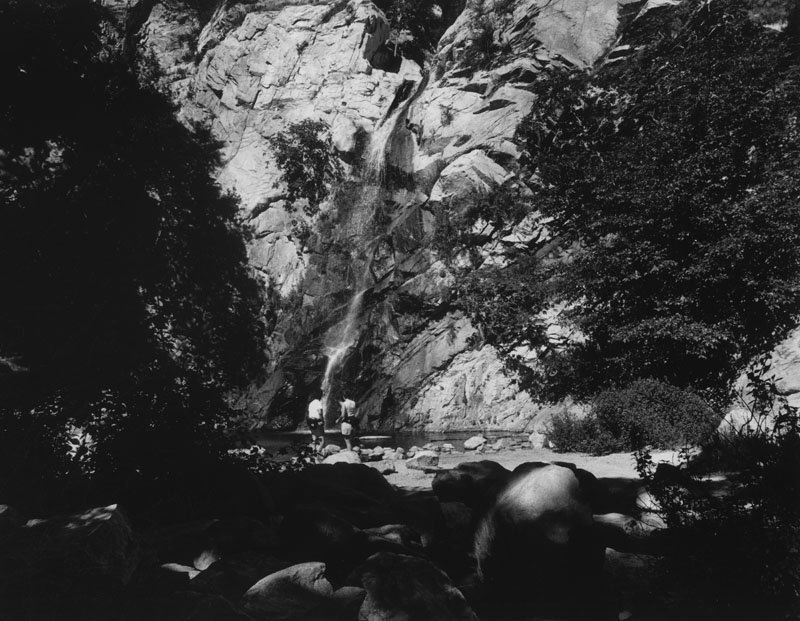 |
|
| (ca. 1988)* - Two hikers are seen enjoying the beauty of Sturtevant Falls in Big Santa Anita Canyon of the Angeles National Forest. Location: San Gabriel Mtns, Santa Anita Ave/Chantry Flats Rd, 4.9 mi N of I-210, Arcadia. |
* * * * * |
NO. 718 - SITE OF THE INITIAL UNITED STATES AIR MEET About a half mile southeast of this spot, on Dominquez Hill in historic Rancho San Pedro, the first air meet in the United States was held during January 10-20, 1910. This area has evolved into one of the world's leading aviation-industrial centers. |
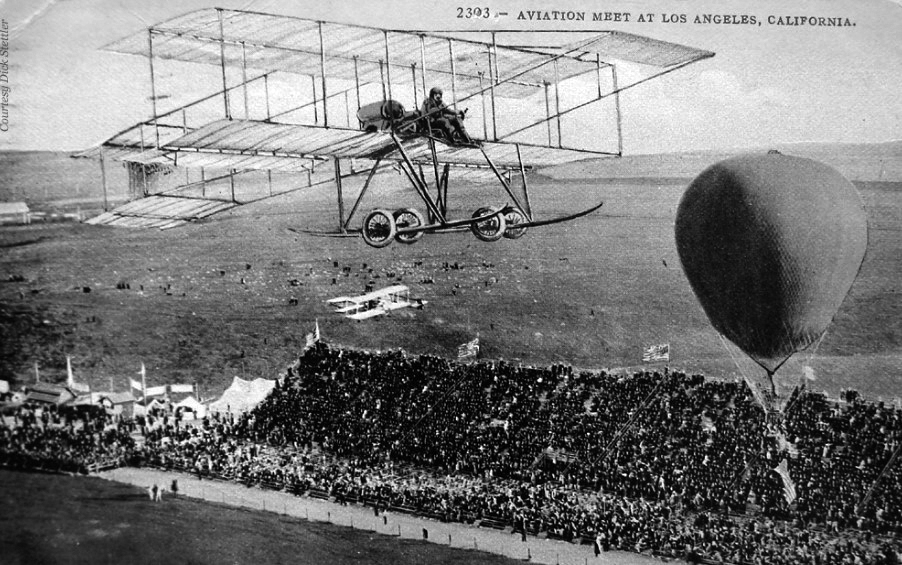 |
|
| (1910)*##^ – Postcard view of the Los Angeles International Air Meet in Dominguez Hills. |
Historical Notes The Los Angeles International Air Meet (January 10 to January 20, 1910) was among the earliest airshows in the world and the first major airshow in the United States. It was held in Los Angeles County, California at Dominguez Field in present day Carson, California. Spectator turnout numbered approximately 254,000 over 11 days of ticket sales. The Los Angeles Times called it "one of the greatest public events in the history of the West”.*^ |
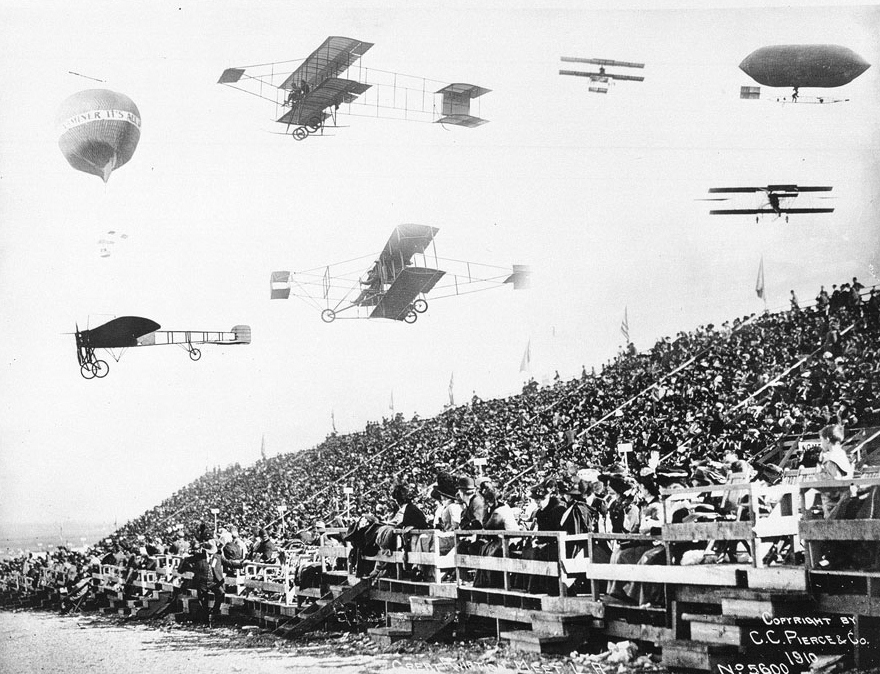 |
|
| (1910)* - Composite photograph of early-model biplanes, a monoplane, a dirigible, and a gas-filled balloon passing by bleachers filled with spectators at the 1910 Dominguez Field Air Meet. |
Historical Notes Following the Reims International Air Meet of 1909 (France) enthusiasm for aviation began to increase in the United States. At an aviation meet in St. Louis fellow enthusiasts discussed the possibility of holding an air meet in Los Angeles. This group, which included Charles Willard, Roy Knabenshue, and Glenn Curtiss, followed through on the proposed project and sent Dick Ferris to Los Angeles to make the preliminary contacts and finalize the plans for the proposed Air Meet. After arriving in Los Angeles Ferris met with various contacts and an International Air Meet was proposed which would include Louis Paulhan-a renowned French aviator. The location was selected, Dominguez Field, which was part of one of the original Spanish land grants-The Rancho San Pedro. - Peter Bergen^^ |
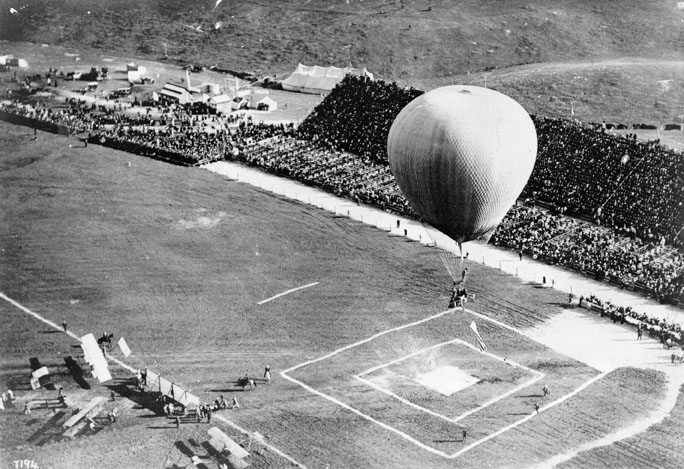 |
|
| (1910)* - A balloon in front of the grand stand of the 1st Aviation Meet. On the ground are three concentric rectangles serving as take-off and landing area. Location: 18501 S Wilmington Ave, Carson. |
Historical Notes There were two International Aviation Meets held at Dominguez Field, Los Angeles. The first ran from Jan. 10-20, 1910; the second from Dec. 24-30, 1910-Jan. 1 and 3, 1911.* |
Click HERE to see more in Aviation in Early Los Angeles |
NO. 730 - OLD PLAZA FIREHOUSE Dedicated to the firemen of the Los Angeles Fire Department-past, present, and future-who, by their courage and faithful devotion to duty, have protected the lives and property of the citizens of Los Angeles from the ravages of fire since 1871. This was the first building constructed as a fire station in Los Angeles. Built in 1884, it served as a firehouse until 1897. After this it was used for various purposes until restored in 1960 and opened as a museum of fire-fighting equipment of the late 19th century. |
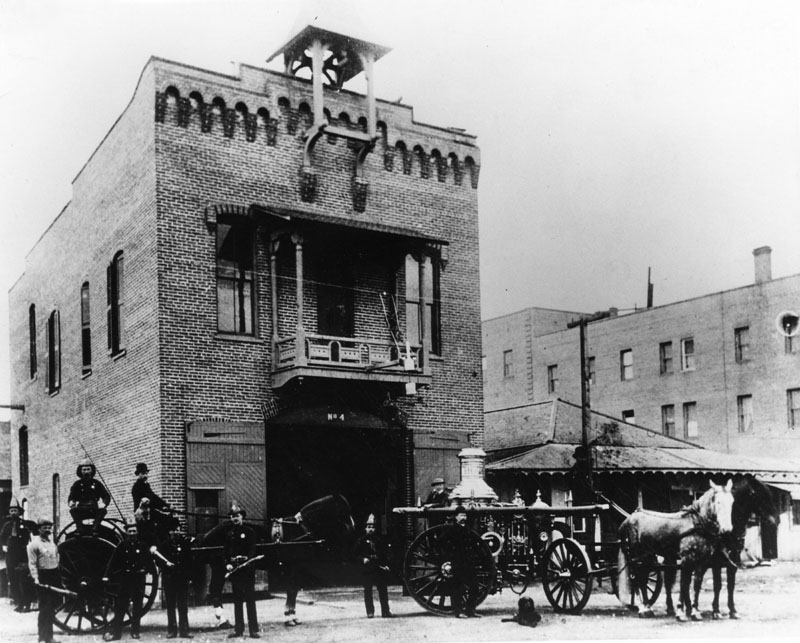 |
|
| (ca. 1884)** - Photograph showing Los Angeles' first fire staion, near the Los Angeles Plaza, with a horse and buggy firefighting team (The First Volunteer Company), located at 26 Plaza Street. |
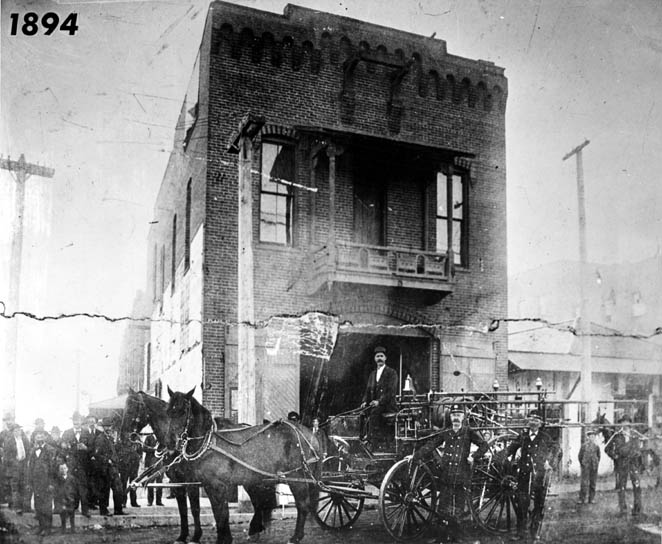 |
|
| (1894)*#^ - Firetruck, men and horses in front of the Plaza Firehouse. |
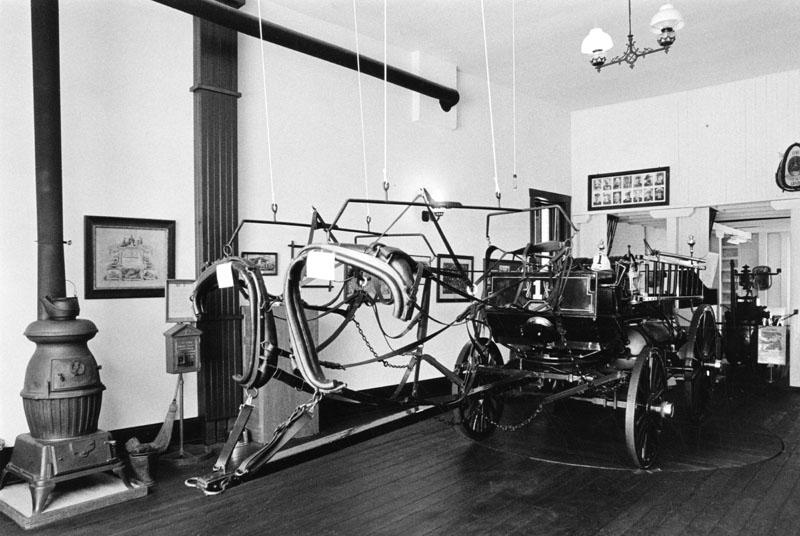 |
|
| (n.d.)* - Ready for the horses to be hitched up, the old Los Angeles fire wagon is waiting to roll down Sunset to right any conflagration. The firehouse with its wagon, equipment, and the only firehouse turntable in the country faces the Plaza. Firemen have dubbed the old vehicle "Firetruck No. 1". The last fire horse ran in 1929. Location: El Pueblo de Los Angeles Historic Monument, 501 N Los Angeles St. |
Click HERE to see more in Early Los Angeles Plaza |
NO. 744 - THE MIRROR BUILDING (SITE OF BUTTERFIELD STAGE STATION) The Butterfield Overland Mail Company took an option on this piece of property in August 1858 and acquired it on December 7, 1859. A large brick building containing offices and living quarters, with shops and stables in the rear, was completed in 1860. With the exception of the station at El Paso, Texas, this was the largest and best equipped station on the entire route. |
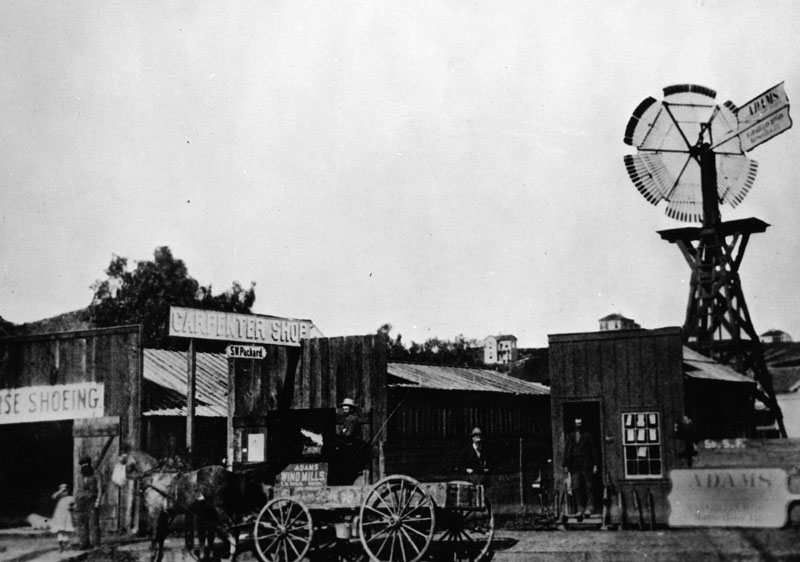 |
|
| (1876)* - On Spring near First Street in 1876. Stage depot/livery stable at left offering horse shoeing had once served as headquarters for the Butterfield Overland Stage, which arrived in Los Angeles for the first time in 1858. Location: 145 S Spring St, Los Angeles. |
NO. 753 - SAN FERNANDO CEMETERY Earlier known as Morningside Cemetery, this is the oldest nonsectarian cemetery in San Fernando Valley. It was used from the early 1800s until 1939, it was legally abandoned in 1959, when Mrs. Nellis S. Noble donated the site in memory of the pioneers of San Fernando. |
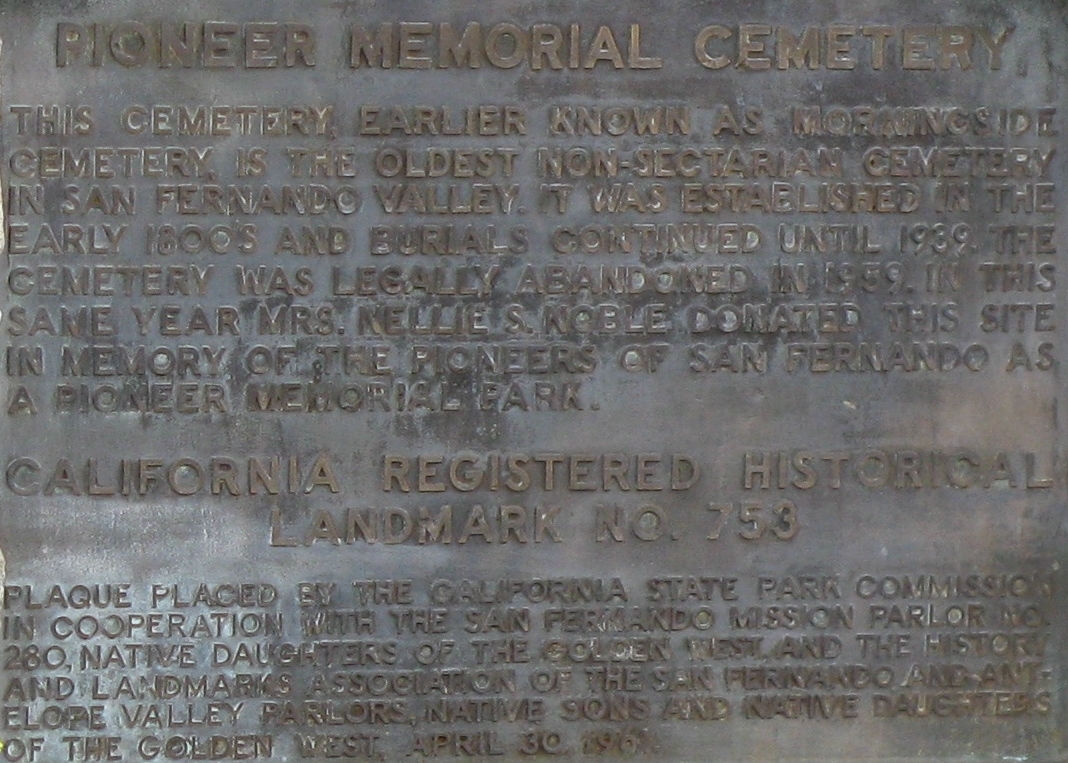 |
|
| (2010)*^^ - The San Fernando Pioneer Memorial Cemetery Marker. Location: SW corner of Bledsoe and Foothill, Sylmar . |
NO. 789 - SITE OF THE LOS ANGELES STAR Southern California's first newspaper, The Los Angeles Star, was founded in this block on May 17, 1851 and for many years exerted a major influence upon this part of the state. Suspended temporarily from 1864 to 1868, it continued later as an effective voice of the people until its final termination date in 1879.
Aliso Street: 1854 - When early settlers arrived at the Los Angeles River (El Rio de Nuestra Senora de Los Angeles de Porcinucula) by way of Mission Road, they picked as a nearby gathering point a huge sycamore that gave them shelter and became a landmark, "El Aliso." That Spanish word for sycamore was later used to name the road carved out near the river, which then was not a concrete channel.^*^ |
NO. 822 - FIRST JEWISH SITE IN LOS ANGELES The Hebrew Benevolent Society of Los Angeles (1854), first charitable organization in the city, acquired this site from the city council by deed of April 9, 1855. This purchase of a sacred burial ground represented the first organized community effort by the pioneer Jewish settlers. |
 |
|
| (1885)^^^ - This photograph, showing the Hebrew Cemetery in Chavez Ravine at the upper left, was taken from the northeast slope of Fort Moore Hill, a few hundred feet north of the present intersection of Hill and Temple Streets, a distance of about a half mile. |
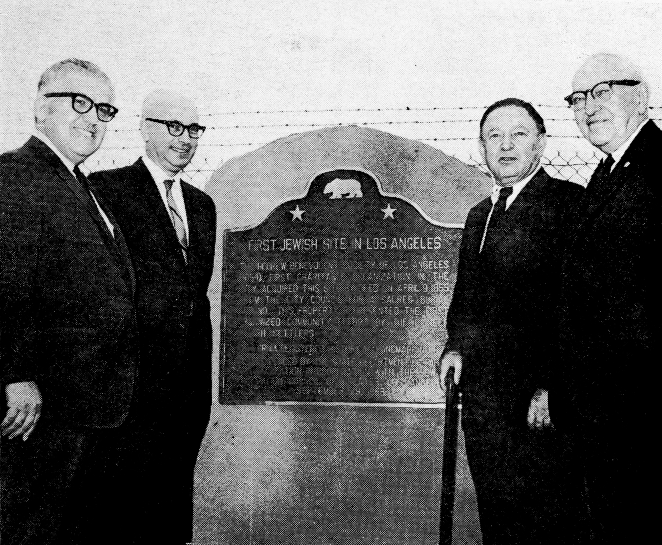 |
|
(1968)^^^ - Community leaders present at the dedication of the historical marker (left to right): Victor M. Carter, then president of the Jewish Federation Council of Greater Los Angeles; Dr. Norton B. Stern, originator of the site research; Dr. Justin G. turner, honorary president of the Southern California Historical Society; and William R. Blumenthal, president of the historical society. Location: Chavez Ravine, behind US Naval and Marine Corps Reserve Center, 800 W Lilac Terrace near Lookout Dr, Los Angeles. |
NO. 840 - OLD SANTA MONICA FORESTRY STATION In 1887, the State Board of Forestry established the nation's first experimental forestry station. Located in Rustic Canyon, the station tested exotic trees for planting in California, established plantations for management studies, and produced planting stock for scientific and conservation purposes. The station was operated by the Board of Forestry until 1893 and by the University of California until 1923. |
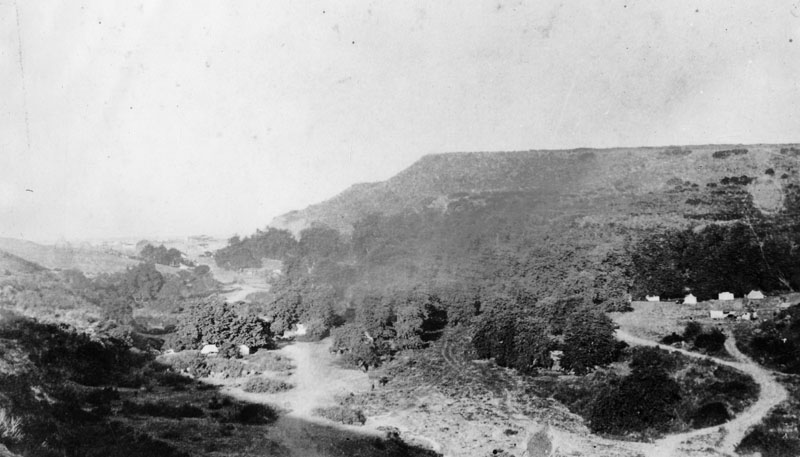 |
|
| (ca. 1890s)* - View of a campground located on the Rancho Boca de Santa Monica in Santa Monica Canyon (near Rustic Canyon), which once belonged to the Marquez Family. The family allowed visitors throughout the Los Angeles area to camp there and enjoy the scenery and the cool ocean breezes. |
Historical Notes The Santa Monica Canyon area was experiencing a land boom during the late 1880’s attracting tycoons (either actual or potential) of every industry. One such industrious man was Abbot Kinney who opened the first forestry station in the adjacent Rustic Canyon in 1887. One of his objectives was to test trees, primarily eucalyptus, as cash crops. On 247 acres of land Kinney began planting trees. Despite the success of the trees, it was clear they were not an effective cash crop and Kinney soon sold the property. Notwithstanding a devastating fire in 1904, many of the trees survived creating the plentiful and beautiful eucalyptus groves in Rustic Canyon today. A plaque was dedicated on August 18, 1971, officially designating the eucalyptus groves as a California State Historical Landmark.^##* |
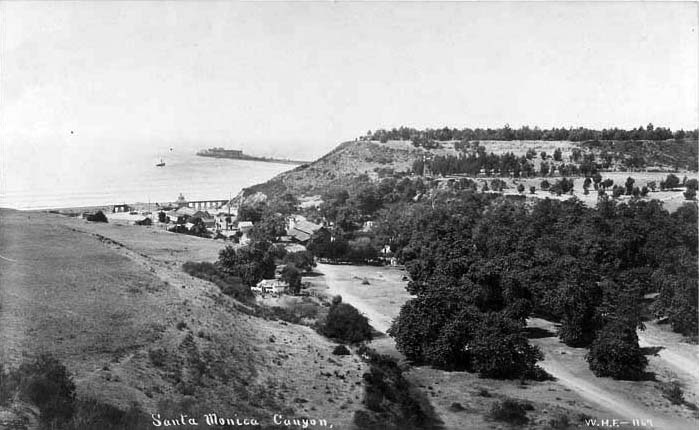 |
|
| (1890s)^*# - View from the hills looking toward the mouth of the Santa Monica Canyon. The Long Wharf can be seen in the distance. Location: Rustic Canyon Recreation Center, NW corner of Latimer and Hilltree Rds, Los Angeles. |
NO. 871 - THE GAMBLE HOUSE Built in 1908, the David B. Gamble House is a tribute to the genius of architects Charles Sumner Greene and Henry Mather Greene. Its design represents a unique California lifestyle and is a masterpiece of American craftsmanship. In 1966 it was made a gift by the Gamble family to the City of Pasadena in a joint agreement with the University of Southern California. |
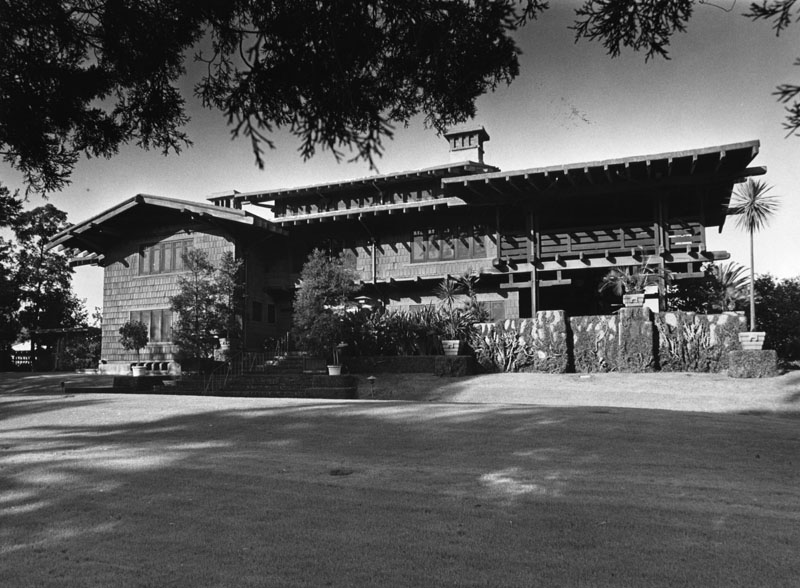 |
|
| (ca. 1975)* - Exterior view of the Gamble House in Pasadena. Built in 1908 and designed by brothers Charles and Henry Greene. Location: 4 Westmoreland Place, Pasadena. |
NO. 874 - WORKMAN HOME AND FAMILY CEMETERY William Workman and John Rowland organized the first wagon train of permanent eastern settlers, which arrived in Southern California on November 5, 1841. Together they owned and developed the 48,790-acre La Puente Rancho. Workman began this adobe home in 1842 and remodeled it in 1872 to resemble a manor house in his native England. He also established 'El Campo Santo,' this region's earliest known private family cemetery, in 1850, the miniature Classic Grecian mausoleum was built in 1919 by grandson Walter P. Temple. |
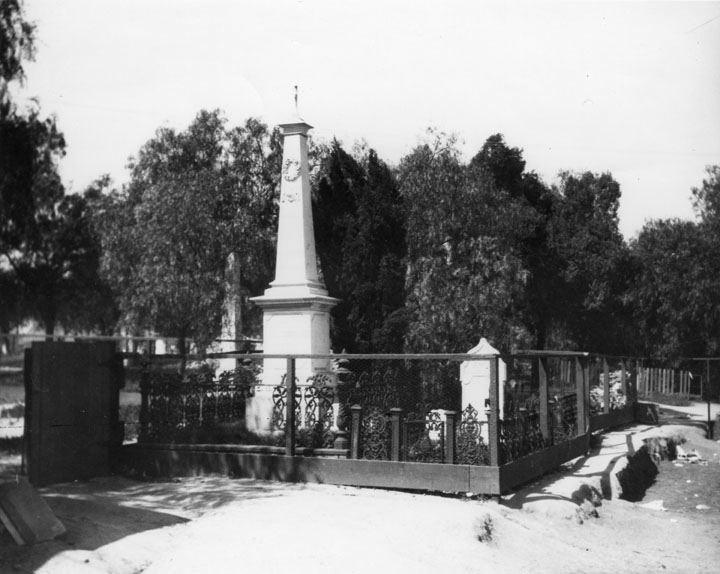 |
|
| (n.d.)* - View of the Workman family plot at El Campo Santo Cemetery, located in the City of Industry. William Workman was one of the first overland settlers to come to Southern California, and along with John Rowland was owner of Rancho La Puente, a 49,000-acre land grant. The Workman family established the cemetery in the early 1850's with David Workman, William's older brother as the first family member to be buried there in November 1855. Location: 15415 E Don Julian Rd, City of Industry. |
NO. 881 - SITE OF PORT LOS ANGELES LONG WHARF In 1893 the Southern Pacific Railroad Company completed its 4,720-foot wharf, which served as a deep water port for the Los Angeles area. But after San Pedro became Los Angeles's official harbor in 1897, shipping activity at Port Los Angeles declined and the wharf was finally dismantled. Today, no trace remains of what was once the longest wooden pier in the world. |
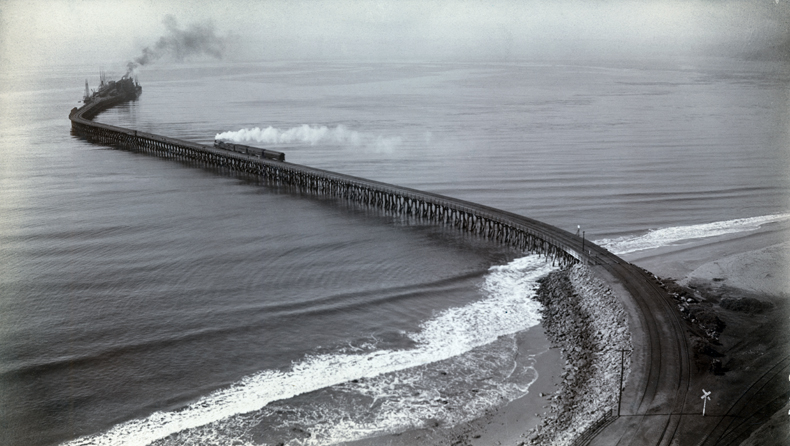 |
|
| (ca. 1893) - Aerial view of the Southern Pacific Mammoth Wharf, Port Los Angeles, Calif. The wharf was also known as the old Santa Monica Long Wharf, north of Canyon. A white cloud of smoke can be seen from a train travelling on the tracks to the business end, at the end of the wharf. |
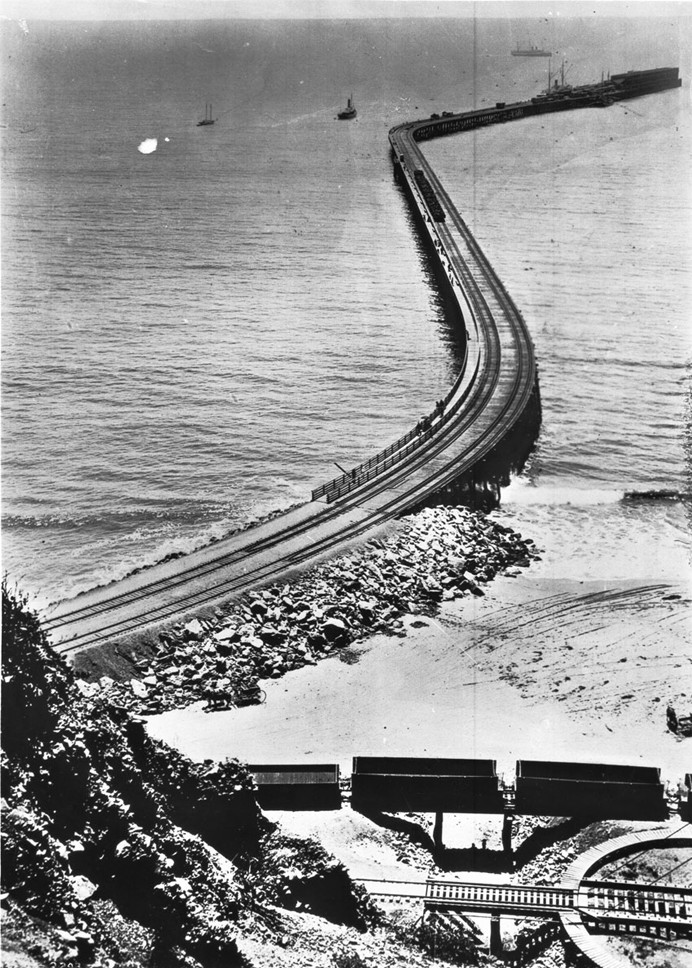 |
|
| (1893)^^ - View of the entire length of the Long Wharf from the beach all the way to its extremity almost a mile away. Note the RR turntable in the lower right corner. A horse-drawn carriage can be seen on the beach between the rail cars and the wharf. Empty railcars sit on a bridge over a gully. |
 |
|
| (1916)^^ - Birdseye view of the Southern Pacific Long Wharf in Santa Monica, September, 1916. |
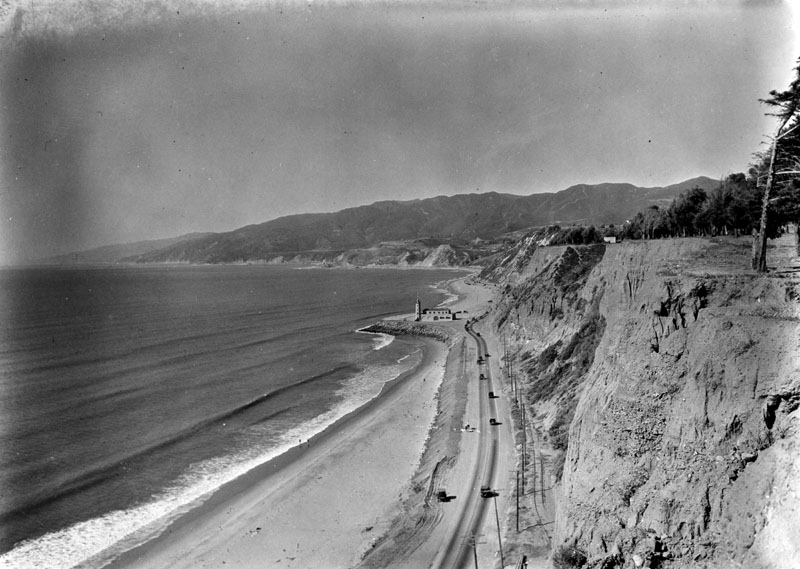 |
|
| (1927)* - A view of the palisades of Santa Monica, looking north along Roosevelt Highway next to an unbuilt beach (today's Will Rogers Beach). |
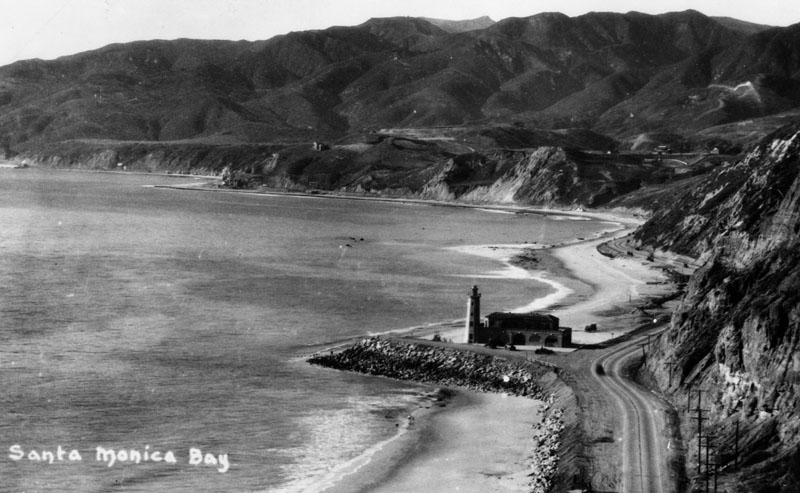 |
|
| (ca. 1927)* - View of the Santa Monica Bay coastline, showing a lighthouse and bathhouse near the Pacific Palisades. The lighthouse stands at the spot where the Long Wharf used to extend out into the ocean. Location: Will Rogers State Beach lifeguard hdqtrs, 15100 W Pacific Coast Hwy 1 (P.M. 375), Pacific Palisades. Click HERE to see more in Early Views of Santa Monica. |
NO. 887 - PASADENA PLAYHOUSE Founded in 1917 by Gilmor Brown, the Pasadena Playhouse was designed by architect Elmer Grey and the cornerstone laid May 31, 1924. In 1928 the College of Theatre Arts was incorporated with the Pasadena Playhouse Association as a non-profit institution. In 1937, the Playhouse received the honorary title 'State Theatre of California' from the California Legislature. |
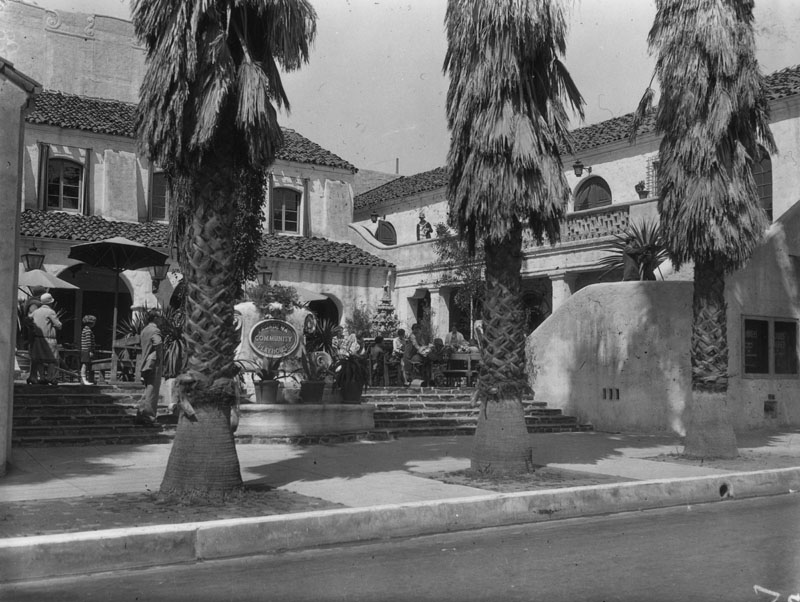 |
|
| (1935)* - Exterior view of the entry and court of the Pasadena Playhouse, designed by architect Elmer Grey in Spanish Colonial Revival style and built in 1924-1925. Location: 39 El Molino Ave, Pasadena. |
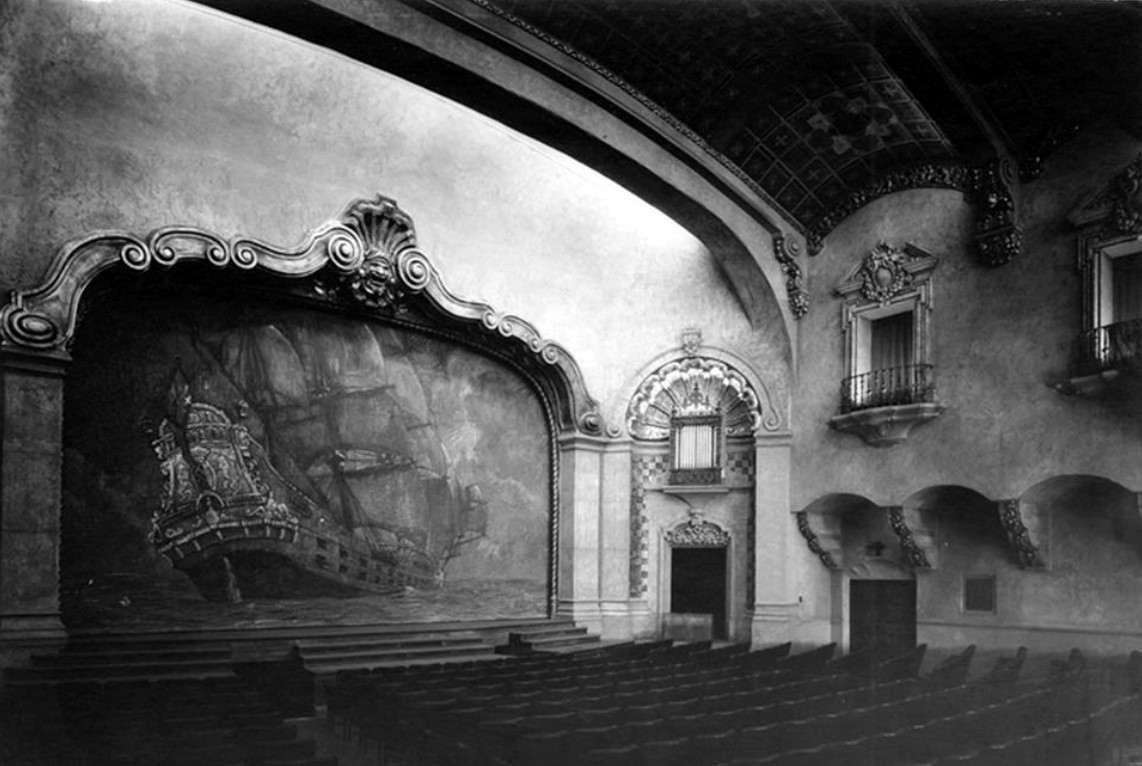 |
|
| (1930)^*# - Interior view of the Pasadena Playhouse Auditorium. Back then it was known as the Pasadena Community Theatre. |
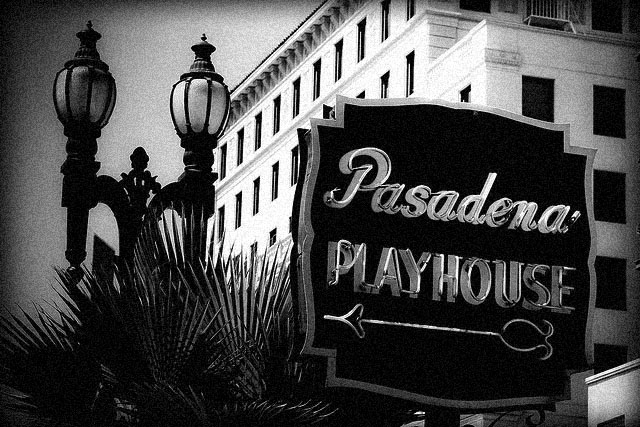 |
|
| (n.d.)^**^ - The historic Pasadena Playhouse theatre was built in 1925 in the heart of Pasadena. This sign is on Colorado Boulevard just north of the theatre. Click HERE to see more Early Views of the Pasadena Playhouse. |
NO. 894 - S.S. CATALINA Commonly referred to as the Great White Steamer, the ship was specially built by William Wrigley to serve his Catalina Island as a passenger ferry. She was christened on May 23, 1924. During World War II, she was requisitioned for use as a troop carrier, but in 1946 she resumed her voyages to Avalon. |
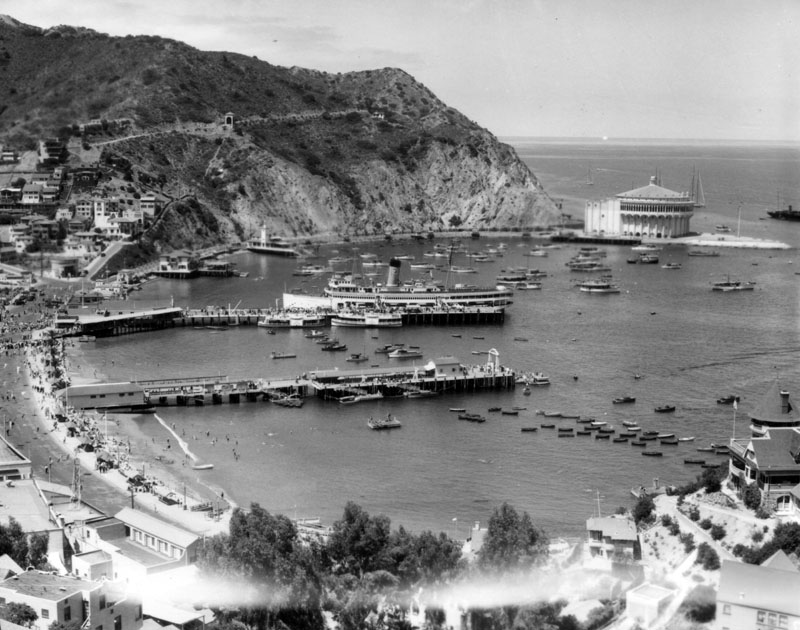 |
|
| (1920s)* - View of Avalon Bay across Crescent Bay, on Santa Catalina Island as seen from a mountain top. Small houses as well as various tourist-oriented businesses and office buildings appear close to the shoreline, with several larger apartment complexes nestled in the hills farther away. The Catalina Casino, surrounded by the sea on three sides, is visible at the edge of the bay on the right along with several boats along with the S.S. Catalina, "The Great White Steamer". |
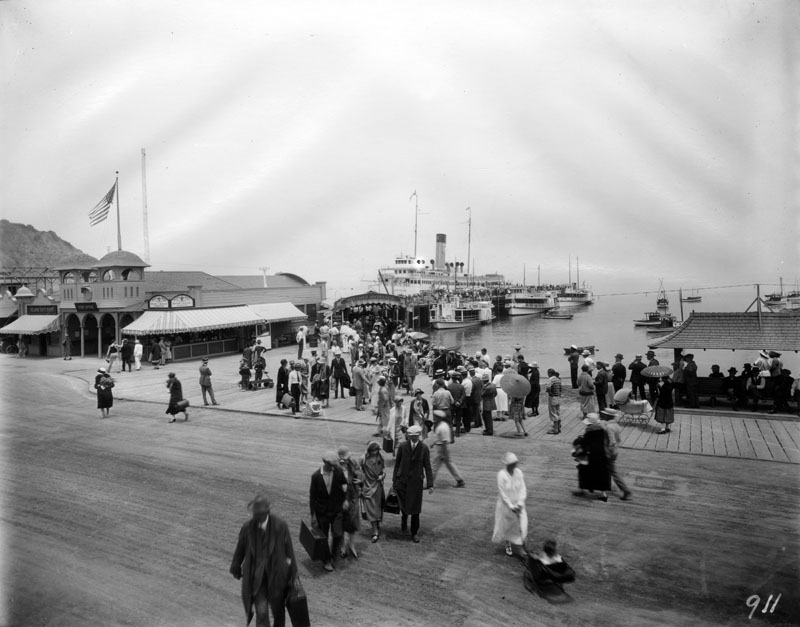 |
|
| (1920s) - View of the dock, or ferry slip, which is full of passengers that appear to be unloading out of the S.S. Catalina, nicknamed "The Great White Steamer". Dozens of people wait for these travelers, making a pathway for them to walk through. The Post Office and Island Gift Shop can be seen on the left, and several small boats are visible to the right of the wharf. Location: Original location: Port of Los Angeles, Catalina Terminal, Berth 96. New location: Ensenada Harbor Ensenada, Mexico. |
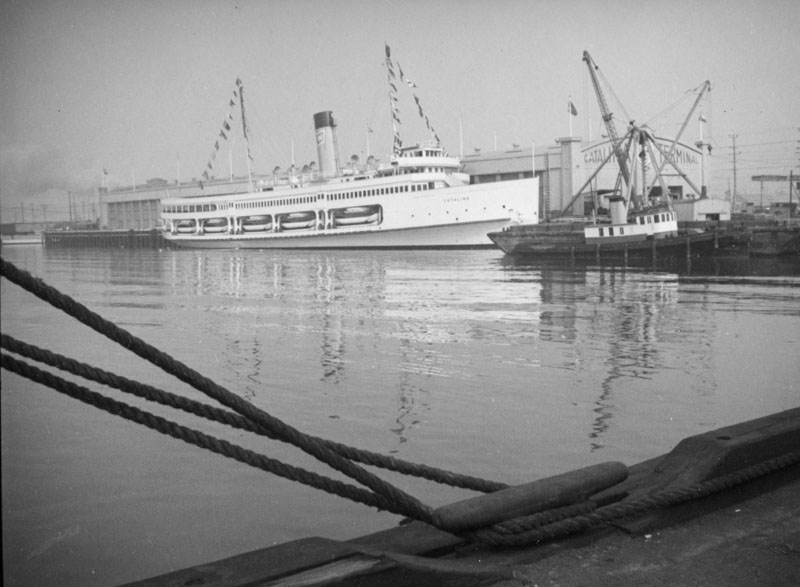 |
|
| (ca. 1938)* - View of the S.S. Catalina docked at the Los Angeles Harbor. |
Click HERE to see more in Early Views of Catalina |
NO. 911 - CHATSWORTH CALERA SITE The Chatsworth Calera is one of the few surviving representative structures of the early 19th century lime industry. This kiln marked the introduction to California of the European industrial process for vitrifying limestone building blocks which were used in the construction of the missions. |
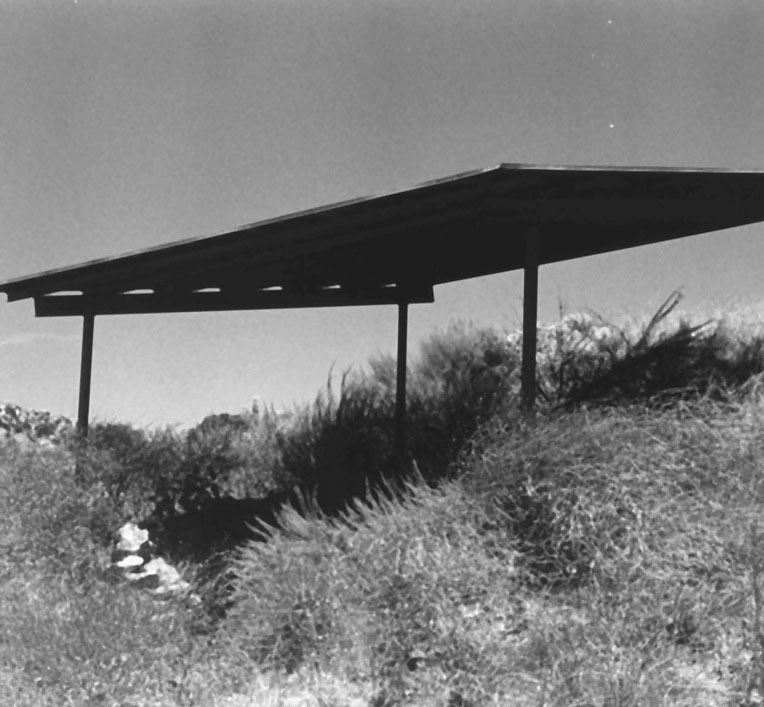 |
|
| (n.d.)**# - Chatsworth Reservoir Kiln Site, Valley Circle, Chatsworth. Location: From State Hwy 27 and Plummer, go W 2.7 mi to the intersection of Woolsey Canyon Rd and Valley Circle Blvd, site is 500 feet NE of intersection, Chatsworth. |
NO. 912 - GLENDORA BOUGAINVILLEA Planted in 1901 by the R. H. Hamlins, early citrus growers, the Glendora bougainvillea is the largest growth of this exotic plant in the United States. The parent stock was brought to California by a whaling ship about 1870. The vines are one of the best remaining illustrations of the image of California as a paradise that was spread by early 20th-century promoters. |
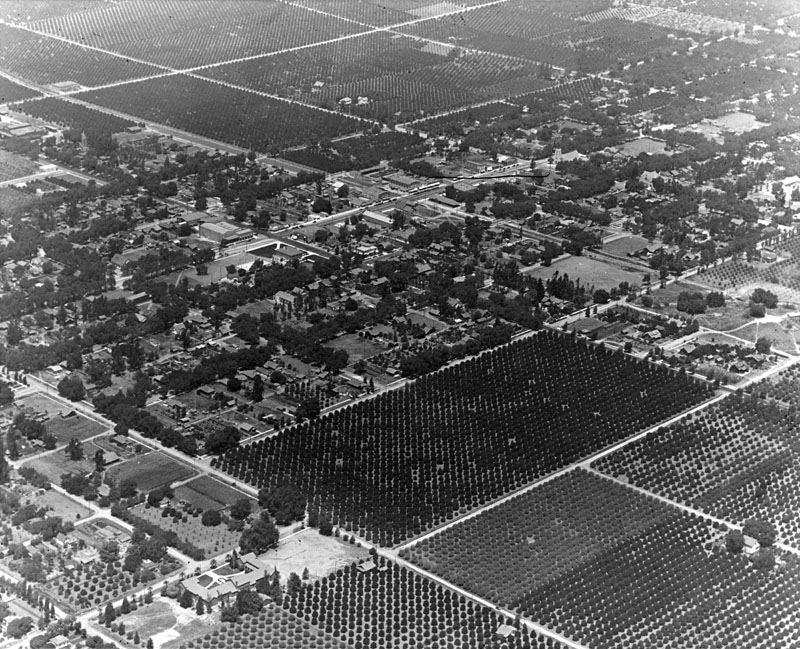 |
|
| (1924)* - Aerial view of Glendora, with Michigan Ave. (now Glendora Ave.) toward the top of the photo. Orchards dominate most of the area. At the time this photograph was taken, Glendora had already begun to have that "developed" appearance. The surge of prosperity had started 20 years earlier when plenty of water was found in the lands below the mouth of San Dimas Canyon. With that, the area really mushroomed. Location: 400 block of E Bennet Ave at Minnesota Ave, Glendora. |
NO. 919 - ST. FRANCIS DAM DISASTER SITE The 185-foot concrete St. Francis Dam, part of the Los Angeles aqueduct system, stood a mile and a half north of this spot. On March 12, 1928, just before midnight, it collapsed and sent over twelve billion gallons of water roaring down the valley of the Santa Clara River. Over 450 lives were lost in this, one of California's greatest disasters. |
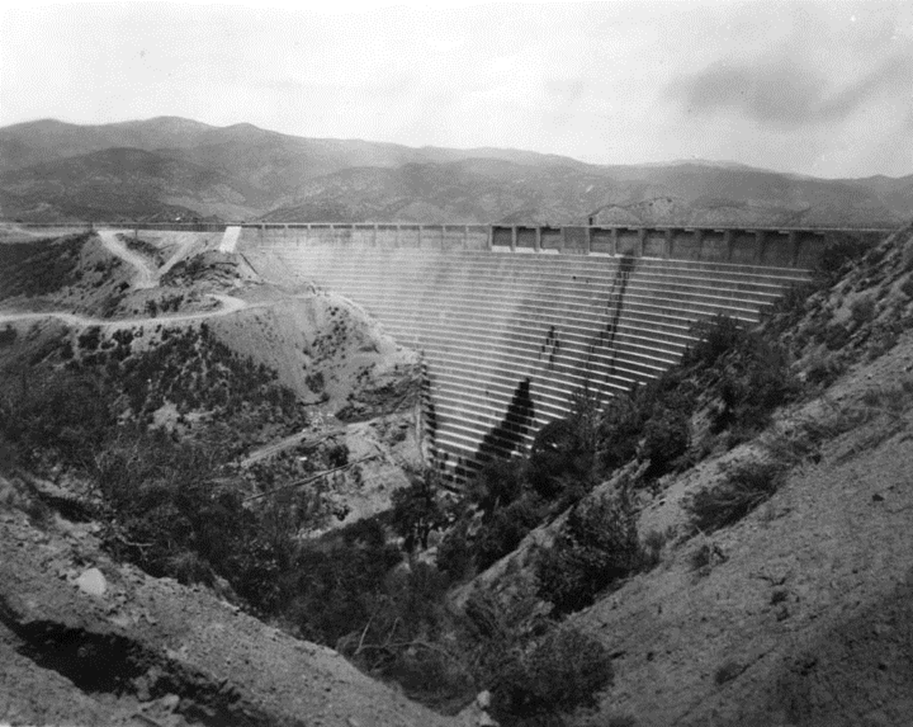 |
|
| (1928)** - St. Francis Dam before failure. This pre-failure photograph shows the exterior of the dam and surrounding countryside. Some water stains can be seen on the wall. This was taken just before the break. |
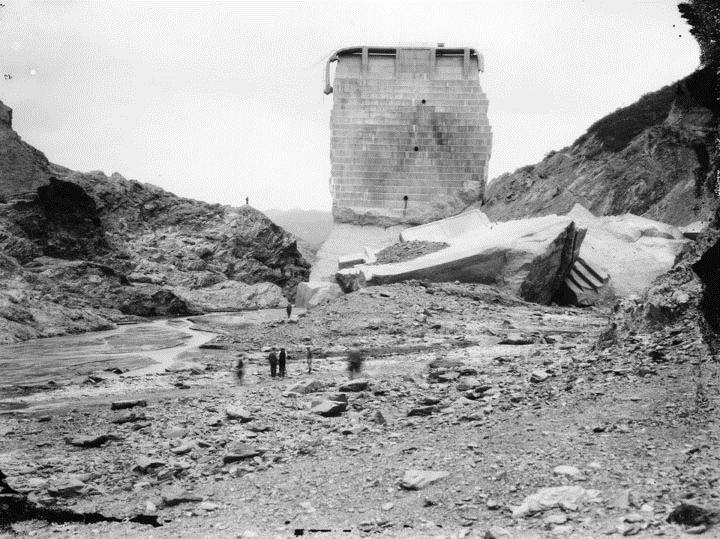 |
|
| (1928)* Failed St. Francis Dam Photo showing several men looking very small as they stand in the area below the failed dam. One large chunk of dam remains standing while another lays on the ground below it. Location: San Francisquito Power Plant No. 2, 32300 N.San Francisquito Canyon Rd, 9.2 miles north of Saugus. |
Click HERE to see more in St. Francis Dam Disaster |
NO. 920 - CASA DE SAN PEDRO The first known commercial structure on the shore of San Pedro Bay was built here in 1823 by the trading firm of McCulloch and Hartnell to store cattle hides from the San Gabriel and San Fernando missions. Richard Henry Dana described this adobe hide house in Two Years Before the Mast. Thus began the development of the Port of Los Angeles. |
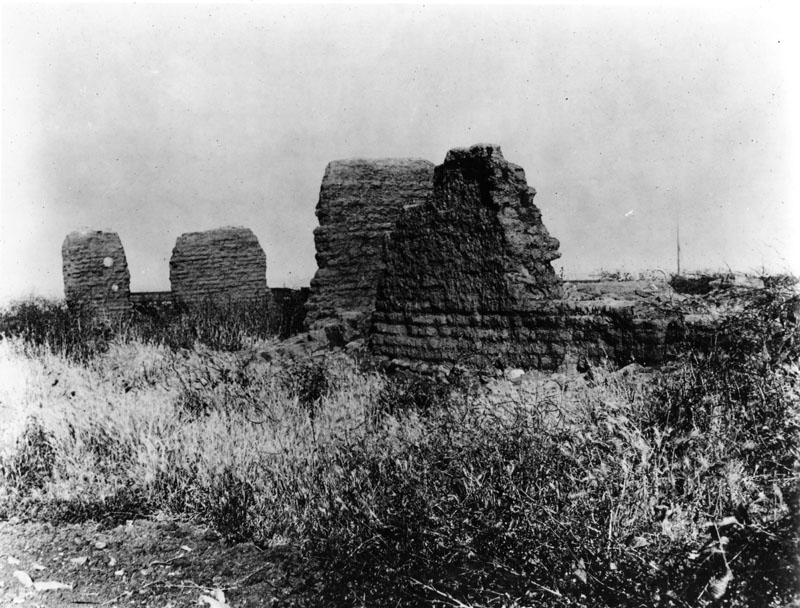 |
|
| (1900)* - In 1829 the Hide House was sold to Mission San Gabriel and five years later it was acquired by Abel Stearns and became known as Casa de San Pedro. Ruins of the Hide House, Casa de San Pedro, stood on the military reserve (Fort MacArthur). Location: Middle Reservation, Fort MacArthur, 2400 block of Pacific Ave, E side of parade field, 300 feet S of intersection of Meyler and Quartermaster Rds, San Pedro. |
NO. 933 - SITE OF LLANO DEL RIO COOPERATIVE COLONY This was the site of the most important non-religious Utopian experiment in western American history. Its founder, Job Harriman, was Eugene Debs' running mate in the presidential election of 1900. In subsequent years, Harriman became an influential socialist leader and in 1911 was almost elected mayor of Los Angeles. At its height in 1916, the colony contained a thousand members and was a flourishing communitarian experiment dedicated to the principal of cooperation rather than competition. |
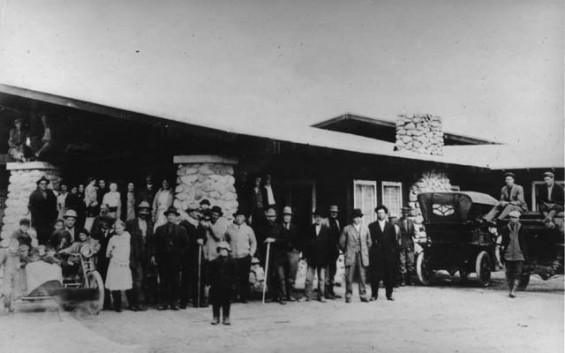 |
|
| (1915)* - Meeting hall of the Utopian Llano Del Rio Cooperative. Location: On State Hwy 138 (P.M. 64.1), Llano |
NO. 934 - TEMPORARY DETENTION CAMPS FOR JAPANESE AMERICANS-SANTA ANITA ASSEMBLY CENTER AND POMONA ASSEMBLY CENTER The temporary detention camps (also known as 'assembly centers') represent the first phase of the mass incarceration of 97,785 Californians of Japanese ancestry during World War II. Pursuant to Executive Order 9066 signed by President Franklin D. Roosevelt on February 19, 1942, thirteen makeshift detention facilities were constructed at various California racetracks, fairgrounds, and labor camps. These facilities were intended to confine Japanese Americans until more permanent concentration camps, such as those at Manzanar and Tule Lake in California, could be built in isolated areas of the country. Beginning on March 30, 1942, all native-born Americans and long-time legal residents of Japanese ancestry living in California were ordered to surrender themselves for detention. |
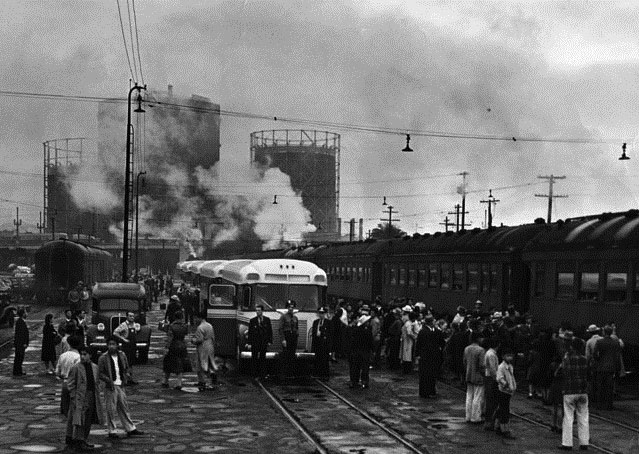 |
|
| (1942)* - View showing Japanese men, women and children boarding trains and buses as they started their journey at the old Santa Fe station to Internment staging centers and/or camps including the one at Santa Anita Racetrack Park. |
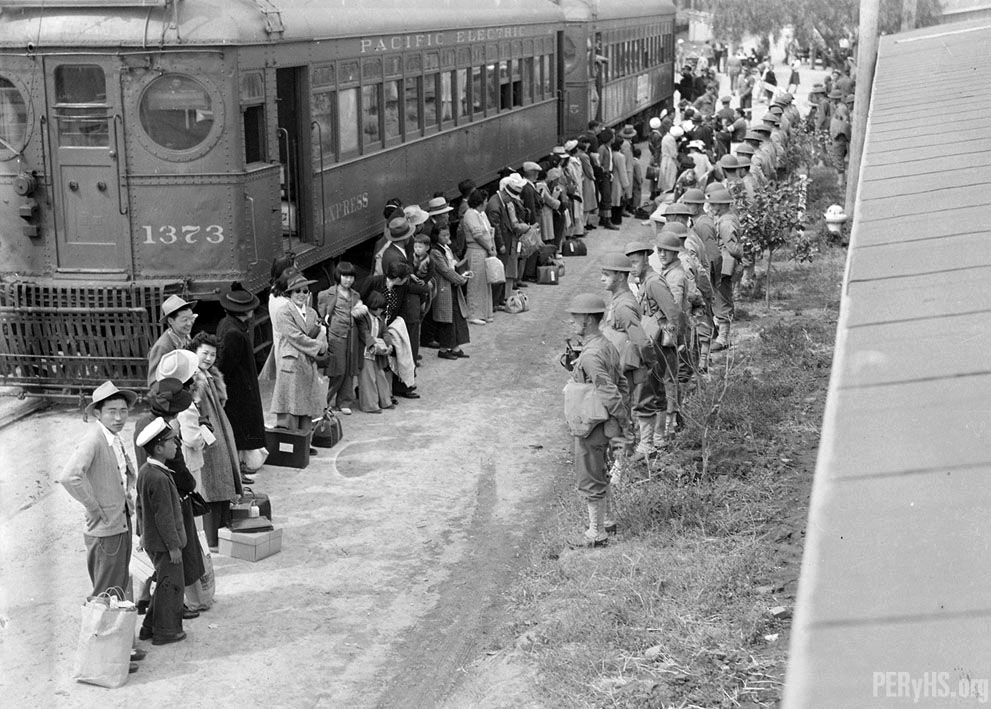 |
|
| (ca. 1942)^*# - Japanese Americans arrive at the Internment staging center at the Santa Anita Racetrack Park. |
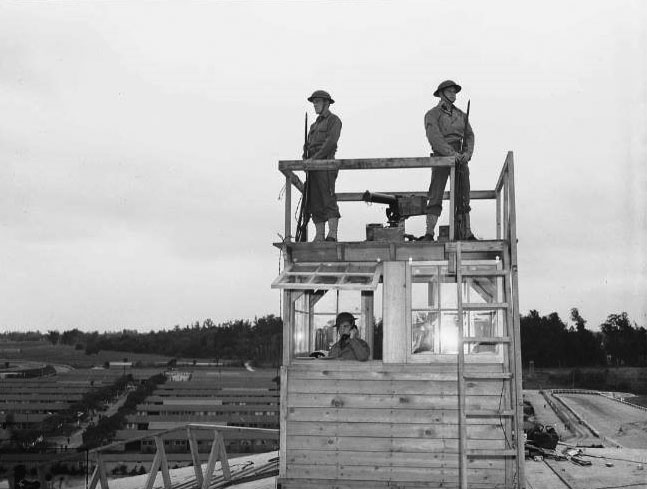 |
|
| (1942)^x^ – View showing a Japanese Internment guard tower at the Santa Anita Racetrack. Photo date: April 6, 1942. |
* * * * * |
NO. 939 - Twentieth Century Folk Art Environments (Thematic)-OLD TRAPPER'S LODGE Old Trapper's Lodge is one of California's remarkable Twentieth Century Folk Art Environments. It represents the life work of John Ehn (1897-1981), a self-taught artist who wished to pass on a sense of the Old West, derived from personal experiences, myths, and tall tales. From 1951 to 1981, using his family as models, and incorporating memorabilia, the 'Old Trapper' followed his dreams and visions to create the Lodge and its 'Boot Hill.'
|
NO. 947 - REFORM SCHOOL FOR JUVENILE OFFENDERS (FRED C. NELLES SCHOOL) The March 11, 1889 Act of the California Legislature authorized the establishment of a school for juvenile offenders. Dedication and laying of cornerstone was done by Governor R. W. Waterman on February 12, 1890. Officially opened as 'Whittier State School' for boys and girls on July 1, 1891. Girls were transferred in 1916 and only boys have been in residence since that time. Renamed 'Fred C. Nelles School for Boys' in 1941 ('For Boys' was dropped around 1970). This school has been in continuous operation serving the needs of juvenile offenders since 1891. |
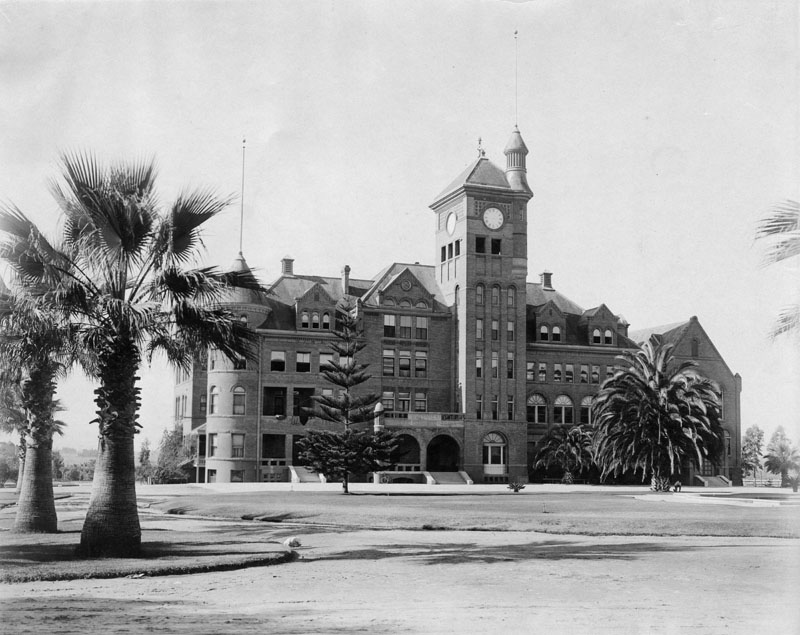 |
|
| (1905)* - Exterior view of Whittier State School, later renamed the Nelles School for Boys. In 1941 the school was renamed the Fred C. Nelles School in honor of the man who served as the facility's superintendent from 1912 to 1927. In 1942 the school became part of the Youth Authority. In 2004, the CYA (California Youth Authority) closed the Fred C. Nelles Youth Correctional Facility in Whittier. This was its oldest facility spanning more than 100 years. The last ward left the facility on May 27, 2004. The CYA, the largest youthful offender agency in the nation, was created by law in 1941, but it wasn't until 1943 that the agency began to operate "reform schools" such as the Fred C. Nelles School for Boys, among others. Location: Department of the Youth Authority entrance, 11850 E Whittier Blvd, Whittier. |
NO. 960 - LOS ANGELES MEMORIAL COLISEUM This stadium was originally completed in 1923. It was partially redesigned and enlarged for the 1932 Olympic Games. Both designs were by architects John and Donald B. Parkinson. The coliseum has witnessed many important sports, political, and historical events. When the games of the XXIIIrd Olympiad began here on July 28, 1984, the coliseum became the first stadium in the world to host the Olympic Games twice. |
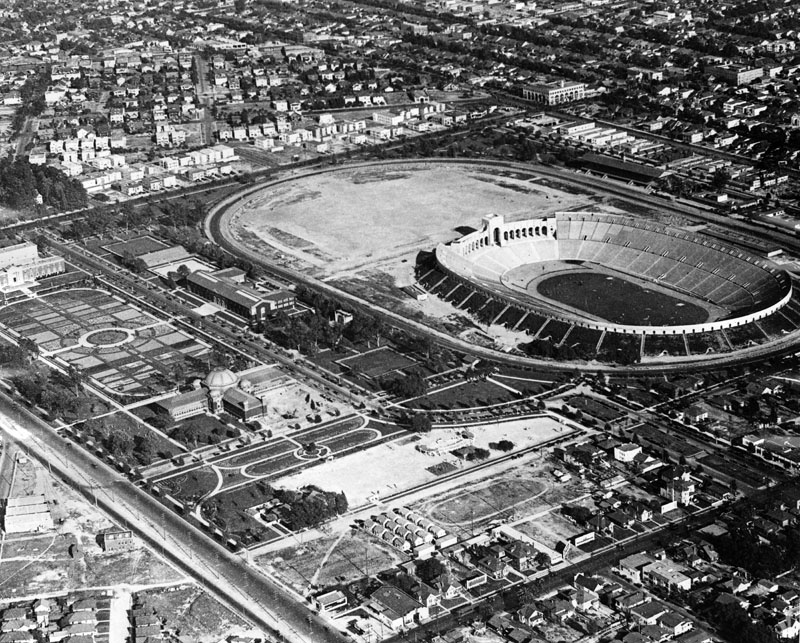 |
|
| (1922)* - The Coliseum, shown above still under construction, was commissioned in 1921 as a memorial to veterans of World War I (rededicated to veterans of all wars in 1968). The official ground breaking ceremony took place on December 21, 1921 with work being completed in just over 16 months, on May 1, 1923.*^ |
Click HERE to see more Early Views showing the Construction of the Los Angeles Memorial Coliseum |
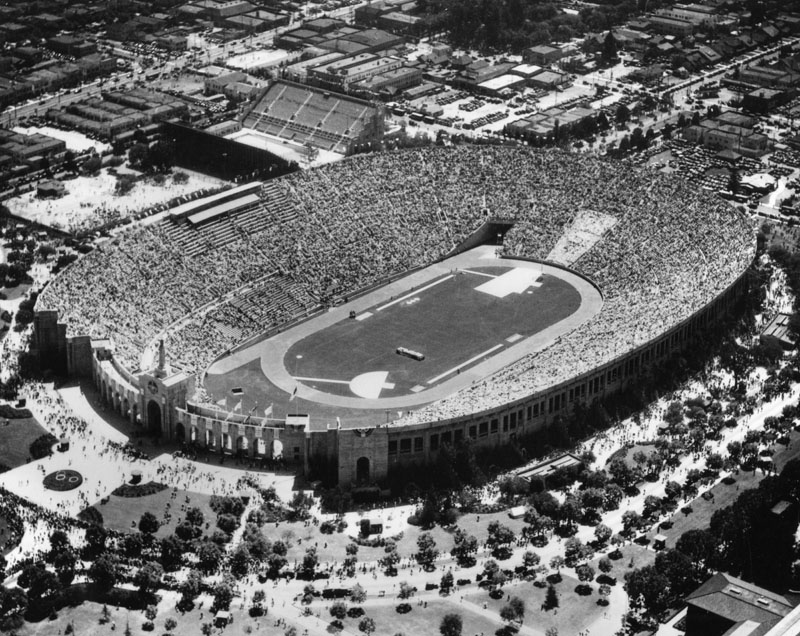 |
|
| (1932)* - Crowds have filled the Olympic Stadium (the Los Angeles Memorial Coliseum) for the 1932 Olympic Games; the Los Angeles Swimming Stadium, another Olympic venue, can be seen in the upper left. Location: South end of University of Southern California, 3911 S Figueroa, Los Angeles. Click HERE to see more in Early Views of USC. |
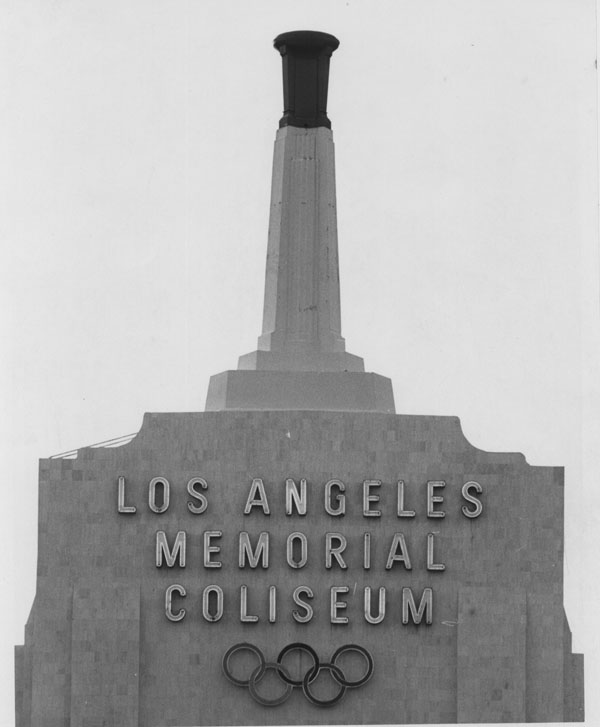 |
|
| (1984)* - Close-up view of the torch at the Los Angeles Memorial Coliseum during the 1984 Los Angeles Olympic Games. Los Angeles also hosted the 1932 Olympic Games. |
Click HERE to see more Early Views of the Los Angeles Memorial Coliseum during the Olympics |
NO. 961 - HAROLD LLOYD ESTATE (GREENACRES) Greenacres, one of the greatest estates of Hollywood's Golden Era, was built in 1929 for the internationally known silent screen comedian, Harold Lloyd. With its formal gardens, it is one of the finest Mediterranean/Italian Renaissance style residential complexes remaining in the state. The 44-room house was designed by Sumner Spaulding and the gardens planned by A. E. Hansen. The estate is patterned after the Villa Gamberaia near Florence, Italy. |
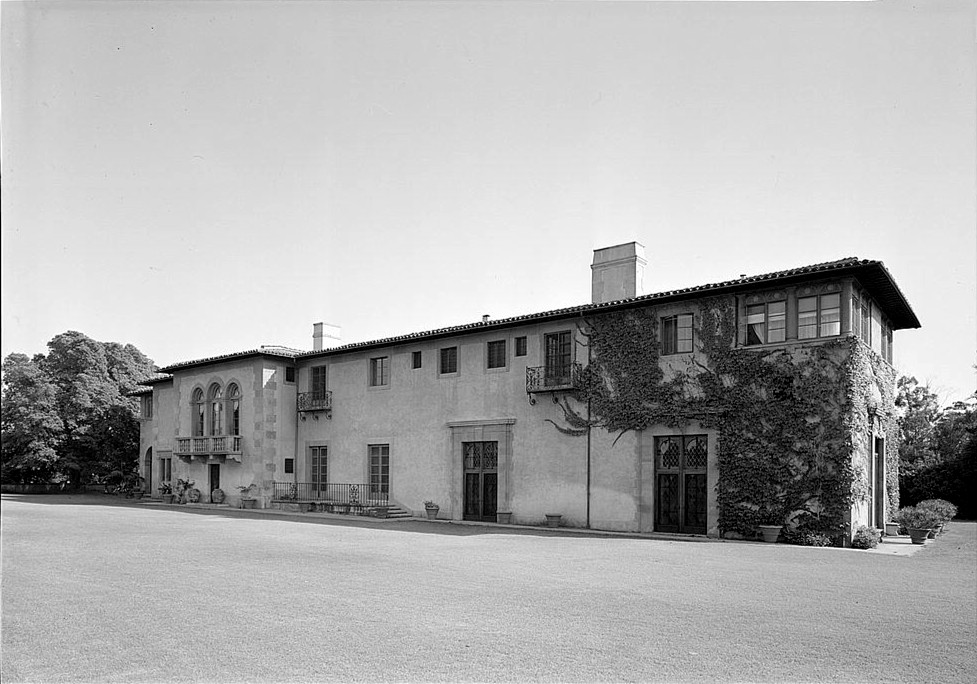 |
|
| (1974)*^ - Built in the latter 1920s by silent film star Harold Lloyd, it remained Lloyd's home until his death in 1971. The estate originally consisted of a 44-room mansion, golf course, outbuildings, and 900-foot (270 m) canoe run on 15 acres. Greenacres has been called "the most impressive movie star's estate ever created." After Lloyd died, the estate was subdivided into multiple lots, though the mansion remains and was added to the National Register of Historic Places in 1984. Location: 1740 Green Acres Place, Beverly Hills. |
NO. 963 - THE MOJAVE ROAD Long ago, Mohave Indians used a network of pathways to cross the Mojave Desert. In 1826, American trapper Jedediah Smith used their paths and became the first non-Indian to reach the California coast overland from mid-America. The paths were worked into a military wagon road in 1859. This "Mojave Road" remained a major link between Los Angeles and points east until a railway crossed the desert in 1885.
|
NO. 965 - POINT DUME On November 24, 1793, English explorer George Vancouver, commander of an expedition to determine the extent of settlement of the northwest coast of America, named this rocky promontory, Point Dume, after his Franciscan friend, Father Francisco Dumetz, at Mission San Buenaventura. Point Dume is the western terminus of Santa Monica Bay and has been an important landmark for navigators since Vancouver's voyage in 1793. |
.jpg) |
|
| (2011)^* - Point Dume, Malibu. Location: Point Dume State Beach, corner of Cliffside Dr and Birdview Ave, Malibu. |
NO. 966 - ADAMSON HOUSE AT MALIBU LAGOON STATE BEACH This Spanish Colonial Revival home contains the best surviving examples of decorative ceramic tile produced by Malibu Potteries. During its short existence from 1926 to 1932, Malibu Potteries made an outstanding contribution to ceramic art in California through its development and production of a wide range of artistic and colorful decorative tile. The home was built for Merritt Huntley Adamson and Rhoda Rindge Adamson, daughter of Frederick Hastings Rindge and May Knight Rindge, last owners of the Rancho Malibu Spanish grant. |
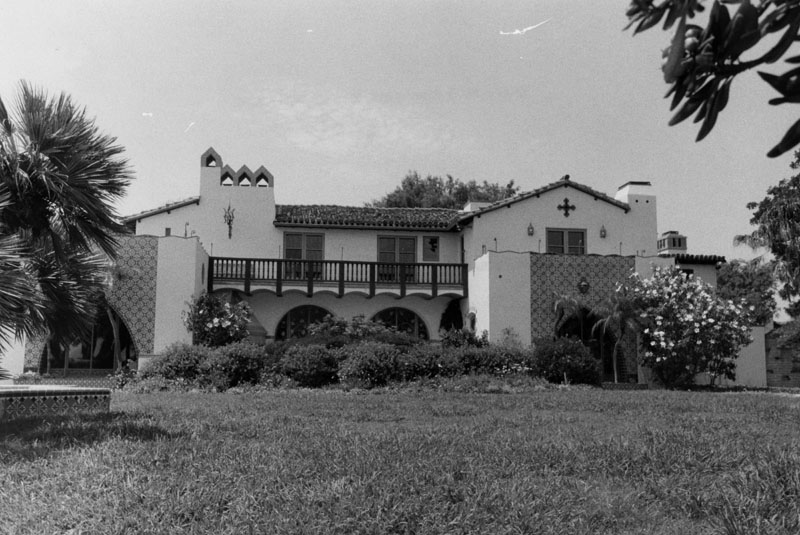 |
|
| (n.d.)* - Exterior view of the Spanish style Adamson House, which was designed by Stiles O. Clements in 1929 for Rhoda Rindge Adamson and her husband, Merritt Huntley Adamson. In 1968, the State purchased the property. In 1971, the president of Pepperdine University moved in, as part of an effort to maintain the house until it could be properly restored for the public access. The Malibu Lagoon Interpretive Association was formed in 1981, and in 1983 they carefully planned for the opening of the house as a museum. Location: 23200 Pacific Coast Hwy, Malibu. |
NO. 972 - NAVY AND MARINE CORPS RESERVE CENTER Designed as the largest enclosed structure without walls in the world by noted California architects Robert Clements and Associates, this Art Deco building, constructed between 1938 and 1941 by the WPA, is the largest and second-oldest Navy Reserve Center in the United Stages. It has served as the induction, separation, and training center for more than 100,000 sailors since World War II well as the filming site for countless motion pictures and television shows. |
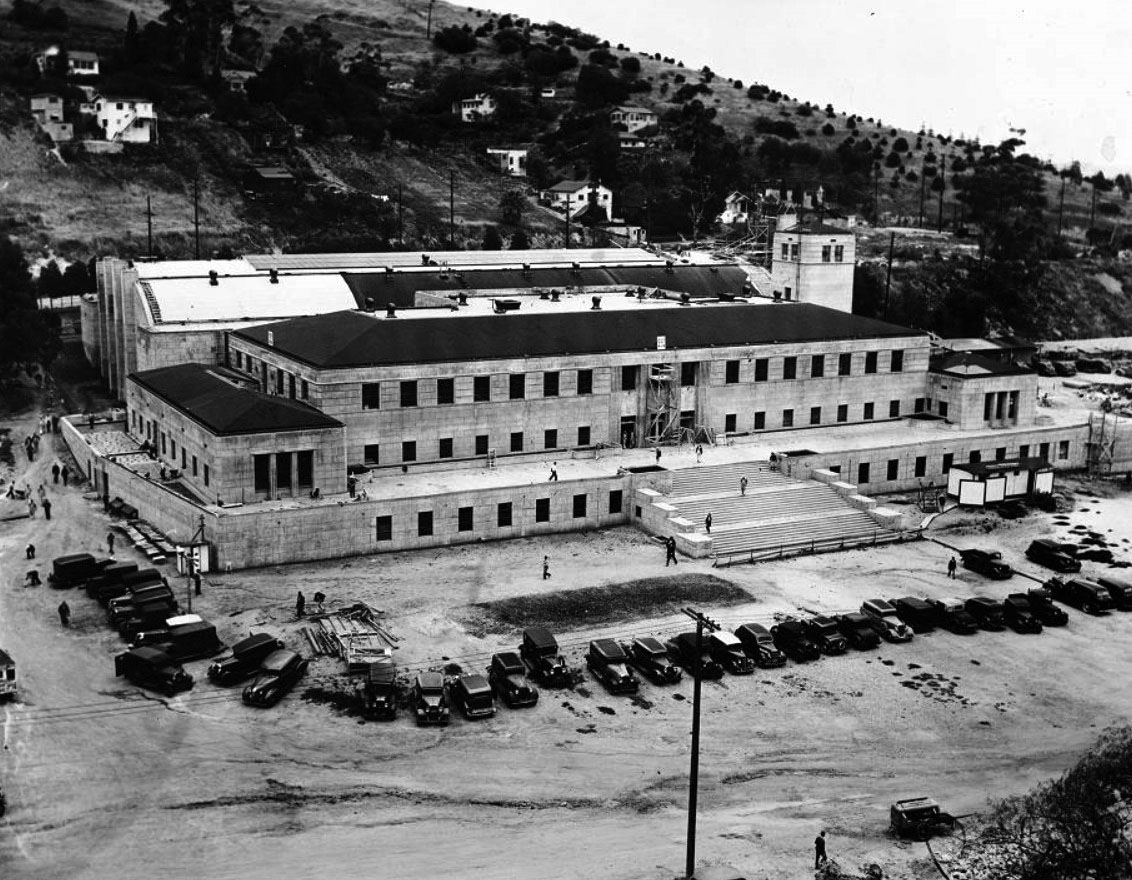 |
|
| (1940)^^ - View showing the Navy and Marine Corps Reserve Center under construction in Chavez Ravine. |
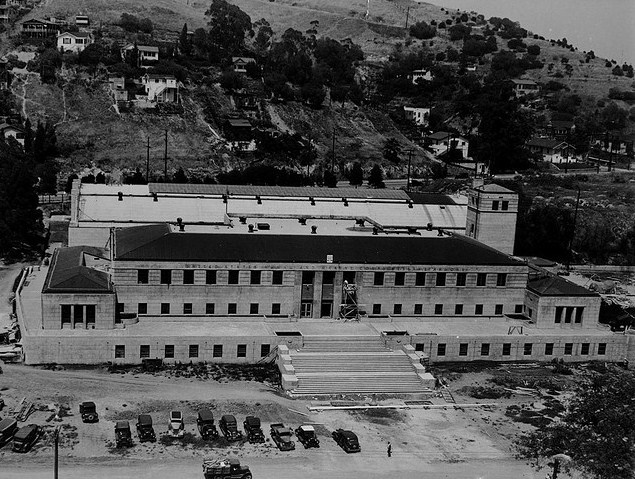 |
|
| (1941)^^ - Final construction stage of what was once the largest Navy Reserve Center in the U.S. |
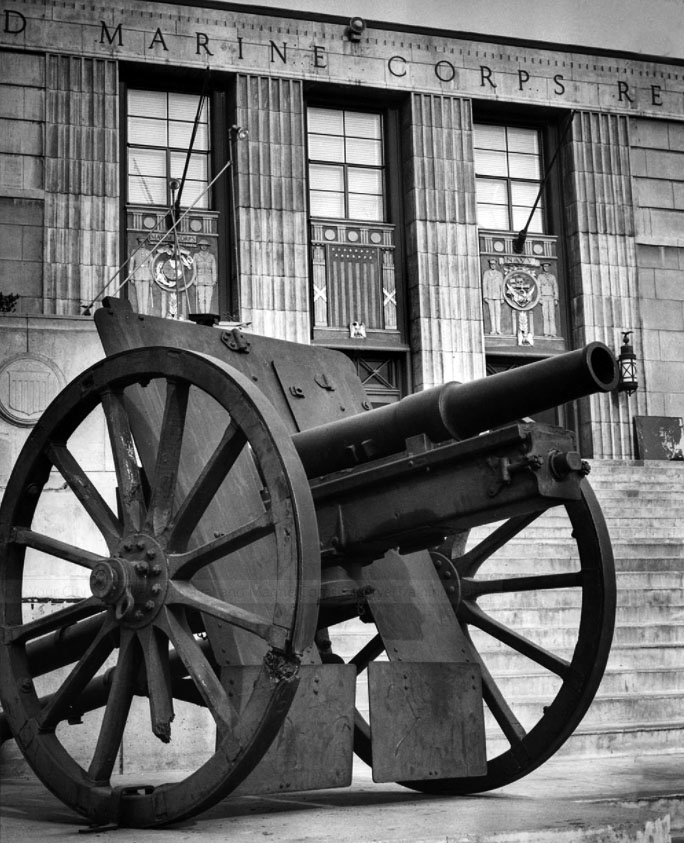 |
|
| (1955)#+ - A cannon sits in front of the entrance to the United States Naval and Marine Corps Reserve Training Center in Chavez Ravine. Location: 1700 Stadium Way, Los Angeles. |
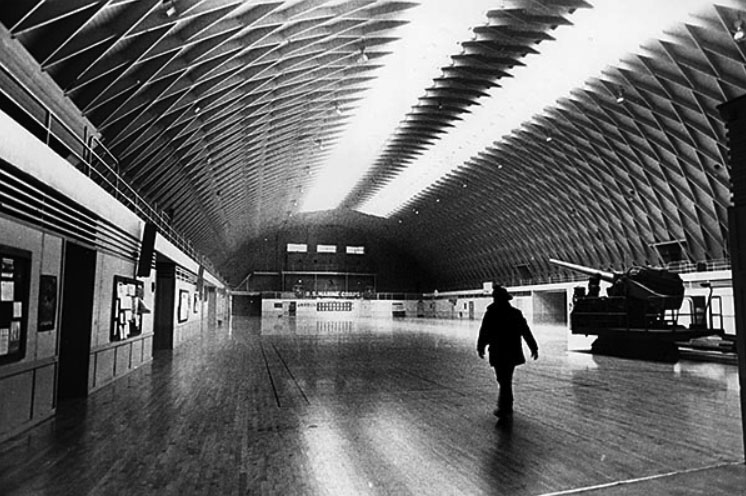 |
|
| (1980)#+ - A firefighter checks the auditorium of the United States Naval and Marine Corps Reserve Center in Chavez Ravine. |
Historical Notes On Feb. 27, 1980, a fire heavily damaged the center. Los Angeles firefighter Frank Hotchkin was killed when a portion of the roof collapsed. The building is now operated by the Los Angeles City Fire Department at the Frank Hotchkin Memorial Training Facility. #+ |
NO. 975 - EL MONTE-FIRST SOUTHERN CALIFORNIA SETTLEMENT BY IMMIGRANTS FROM UNITED STATES El Monte, on the bank of the San Gabriel River, played a significant part in California's early pioneer history. It was first an encampment on the Old Spanish Trail, an extension of the trail from Missouri to Santa Fe. By the 1850s, some began to call El Monte the 'End of the Santa Fe Trail.' Early in that decade a permanent settlement was established by immigrants from Texas, the first settlement in Southern California founded by citizens of the United States. |
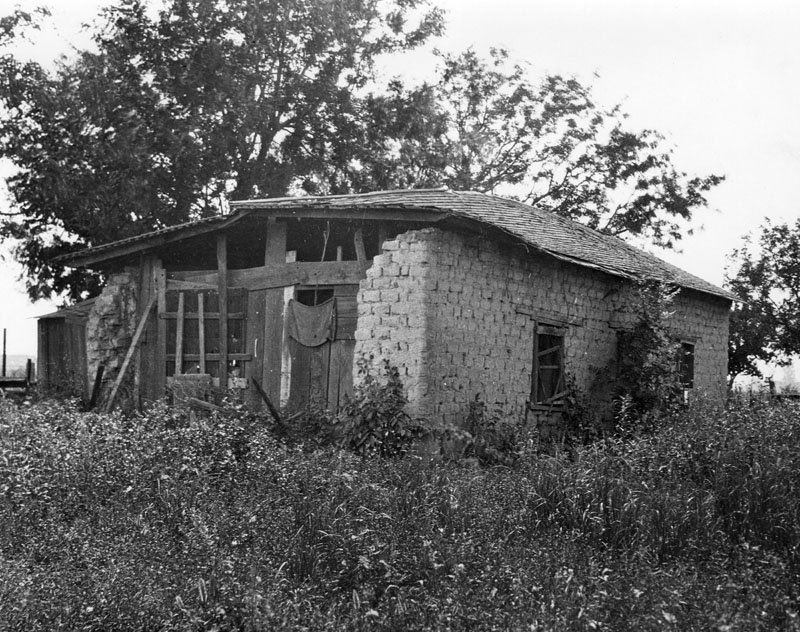 |
|
| (1922)* - This is the oldest house in El Monte. It was built by Mrs. Almira Hale and her son and daughter, Moses and Almira Hale. Mrs. Hale's husband had died while the family was crossing the plains and is buried near Mountain Meadows, Utah. This was in 1849. This house was built the same year. Mrs. Hale later married Nickie Smith. She, and her children homesteaded 160 acres here and had about 300 Indians on the ranch. Most of them went to the war in Owens Valley in 1865.Photo dated: June 25, 1922. El Monte is known as the first Southern Californian settlement established by immigrants from the U.S. It is called the "End of the Santa Fe Trail". Landmark Location: Santa Fe Trail Historical Park, Valley Blvd and Santa Anita Ave, El Monte. |
NO. 978 - RANCHO LOS CERRITOS HISTORIC SITE The 27,000-acre Rancho was once part of an 18th-century Spanish land grant to soldier Manuel Nieto. The Monterey-style adobe was constructed in 1844 and served the Temple and Bixby families as headquarters for large-scale cattle and sheep ranching operations in the 19th century. In the 1880s, the land was subdivided for farming and city development. |
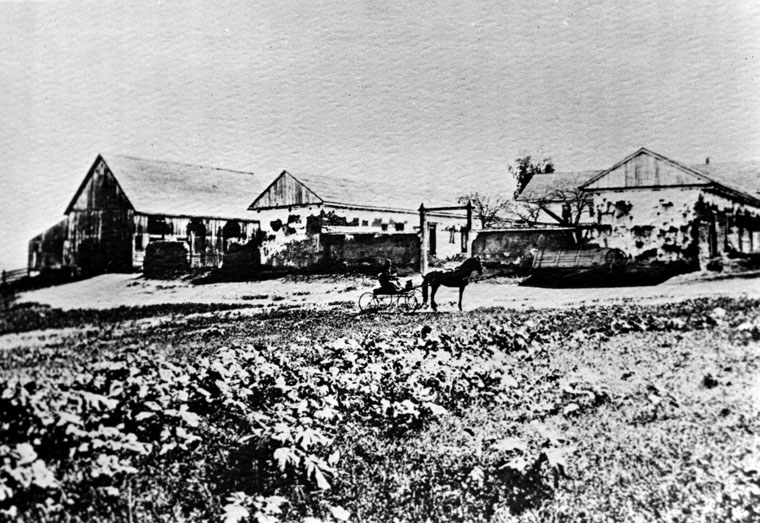 |
|
| (1890)* - View of Rancho Los Cerritos in Long Beach showing the original front entrance into the courtyard with view, and peaked roofs on the north and south wings of the buildings. |
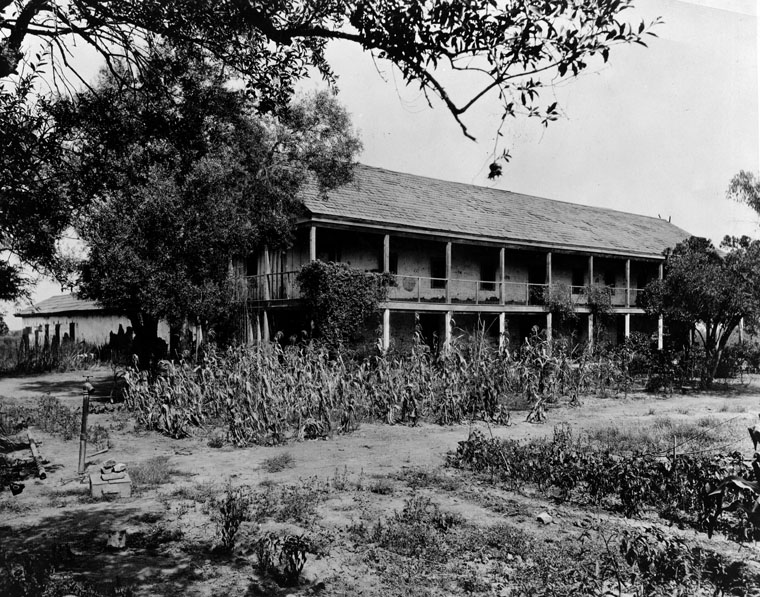 |
|
| (1931)* - Exterior view of the adobe house at Los Cerritos Rancho. This vast and beautiful rancho (site of park of Long Beach today) came into John Temple's possession thru his marriage to Doña Raphael Cota. Photo dated: September 19, 1931. Location: 4600 Virginia Rd, Long Beach. |
NO. 984 - CASA DE RANCHO SAN ANTONIO (HENRY GAGE MANSION) Contained within this building are the remaining portions of an adobe house built by Francisco Salvador Lugo and his son Antonio María Lugo. Francisco Lugo was a prominent early landholder and Antonio served as the Alcalde of Los Angeles. They completed the building by 1810. Henry Tifft Gage acquired the property in 1880 and lived here from 1883 until 1924. Gage served as the Governor of California from 1899 to 1903. |
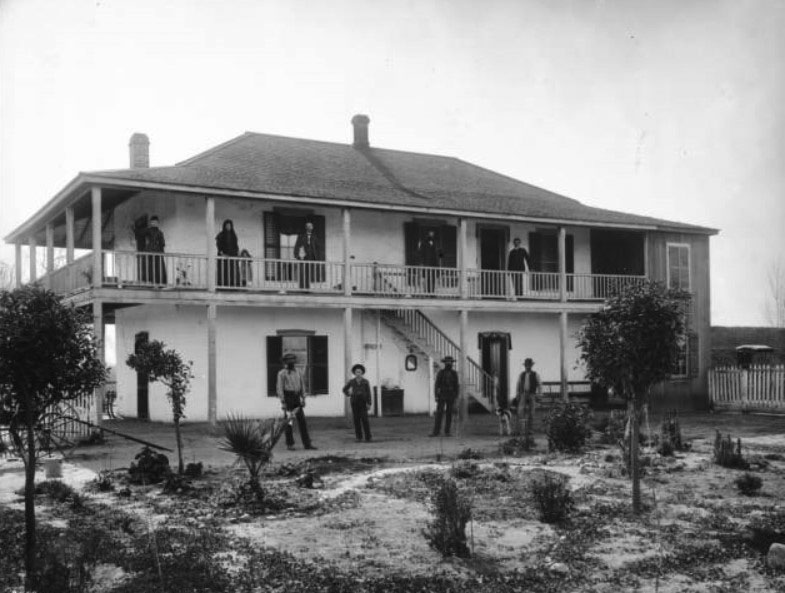 |
|
| (ca. 1892)^^ - View showing ten members of the Vincente Lugo family (includes two women and a small child) posing at the ranch house (Rancho San Antonio, Baker Avenue stores on Telegraph Road opposite Laguna School House), on the balcony and ground below. Pictured on the porch (left to right): Vicente Perez Lugo (sister), Victoria Avila Lugo (sister), Annie Lugo Smith (niece), A.E. McConnell, Vicente Lugo (older brother), Andres Lugo. Pictured below (left to right): Felipe Lugo, Toney Lugo (nephew), Pedro Lugo, Governor Argullo (not a family member), B.A. Lugo (brother) [identifications by Pedro Lugo, 15 July 1924]. |
Historical Notes Don Vicente Lugo retired to Rancho San Antonio in 1850, after having donated the family "town house" on the Los Angeles Plaza to Saint Vincent's College. The ranch house was built circa 1855. Avila Lugo lived on 35th Street near Maple Street. Andres Lugo lived in the first house north (of the ranch house).^^ Click HERE to see more in Early Views of the Los Angeles Plaza. |
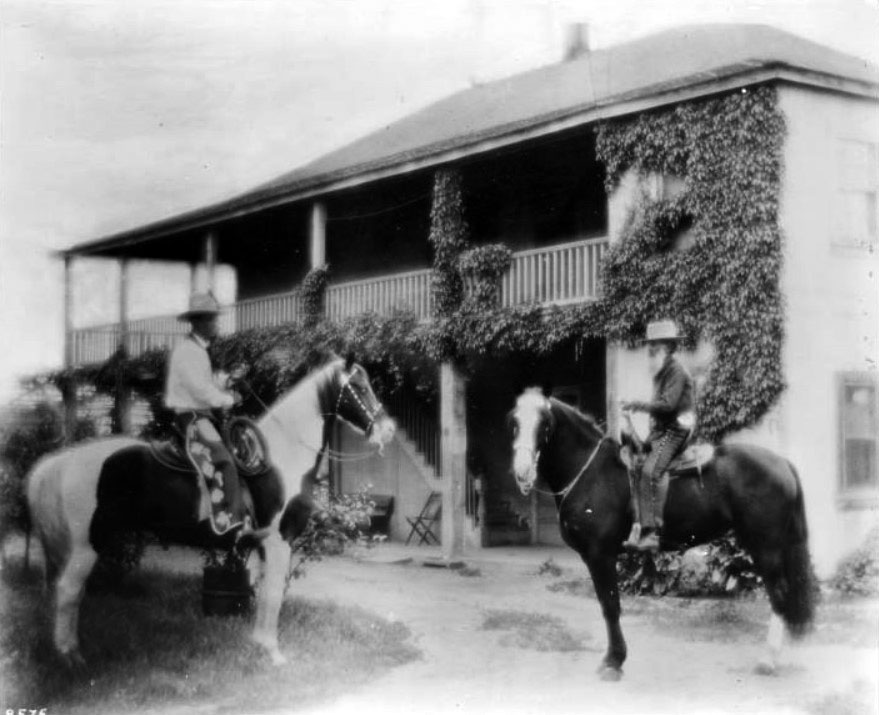 |
|
| (Early 1900s)^^ - View showing Don Pedro Lugo and friend who are both mounted on horses in front of the Lugo home. The men are wearing cowboy-like outfits. Vines partially cover the walls of the two-story home behind them. Location: 7000 E Gage, Bell Gardens. |
NO. 988 - PACIFIC ASIA MUSEUM (GRACE NICHOLSON'S TREASURE HOUSE OF ORIENTAL AND WESTERN ART) Grace Nicholson, a noted collector and authority on American Indian and Asian Art and artifacts, supervised the design of her combination gallery and museum which was completed in 1929. It has been called an outstanding example of 1920s revival architecture and is unique for its use of Chinese ornamentation. |
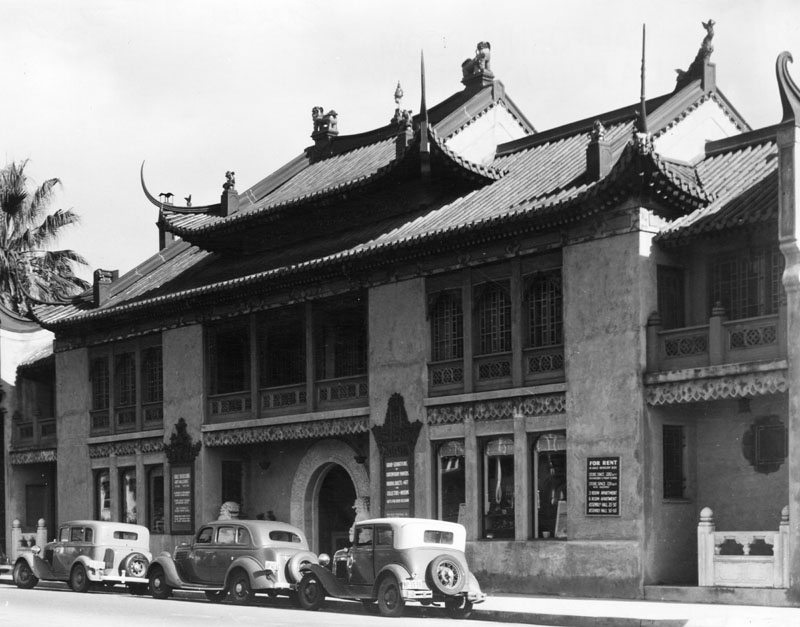 |
|
| (1939)* - Exterior view of the Grace Nicholson Bazaar and Art Gallery, now the Pacific-Asia Museum. Photo is dated July 26, 1939. Mrs. Nicholson was a dealer in Oriental art and books, and this was her shop and home. Later it became the Pasadena Art Institute. This photo shows that she rented apartments, store space and assembly halls in this building. Location: 46 North Los Robles Ave, Pasadena. |
NO. 990 - CHRISTMAS TREE LANE The 135 Deodar Cedar trees were planted in 1885 by the Woodbury Family, the founders of Altadena. First organized by F.C. Nash in 1920, the 'Mile of Christmas Trees' has been strung with 10,000 lights each holiday season through the efforts of volunteers and the Christmas Tree Lane Association. It is the oldest large-scale Christmas lighting spectacle in Southern California. |
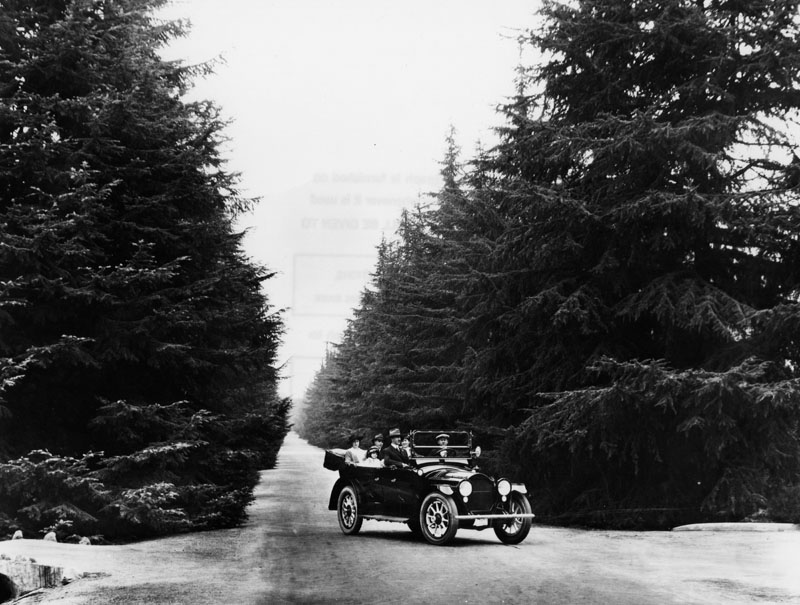 |
|
| (ca. 1928)* - Passengers in a car travel south on Santa Rosa Avenue, also known as Christmas Tree Lane in Altadena. The nickname was given to the street when the tradition of lighting the large deodar cedars with lights at Christmas time was started. Location: Santa Rosa Ave, both sides of street from Woodbury Rd to Altadena Dr, Altadena. |
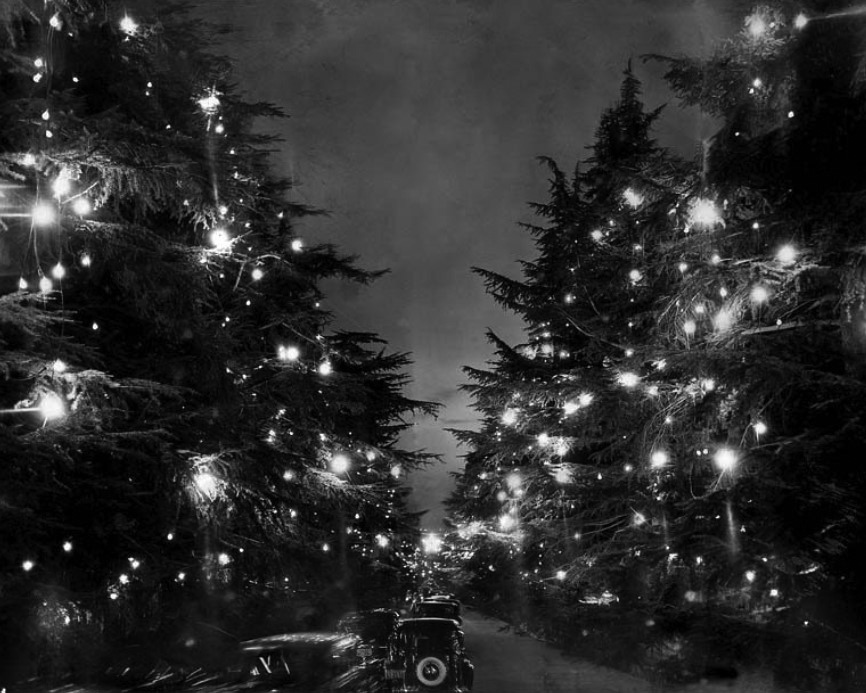 |
|
| (1938)#+ – View showing a line of cars driving up Christmas Tree Lane in Altadena. |
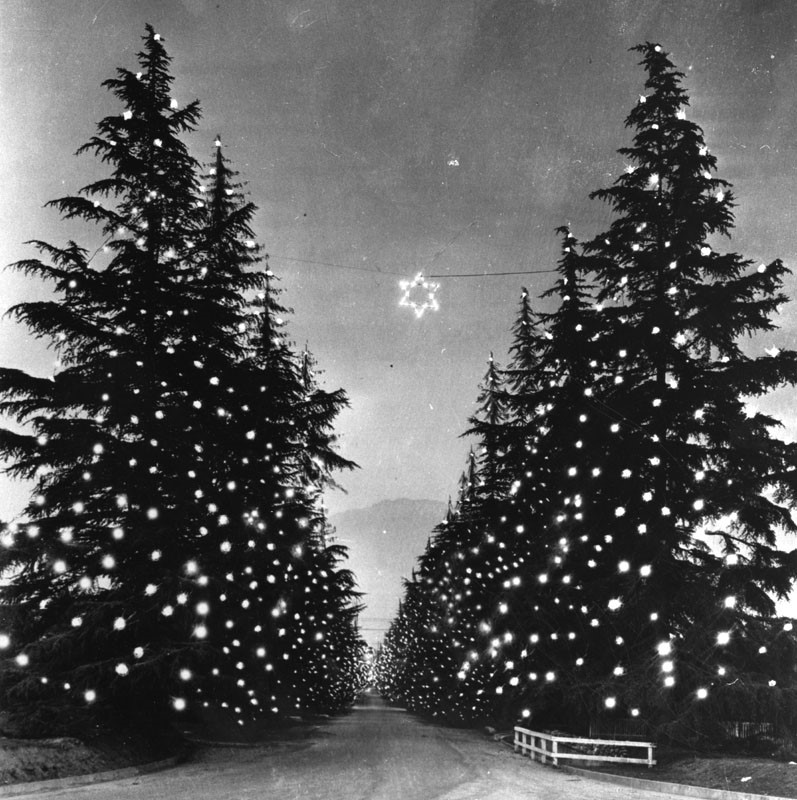 |
|
| (ca. 1947)* – Christmas Tree Lane (Santa Rosa Avenue) in Altadena, looking north from Woodbury Road. |
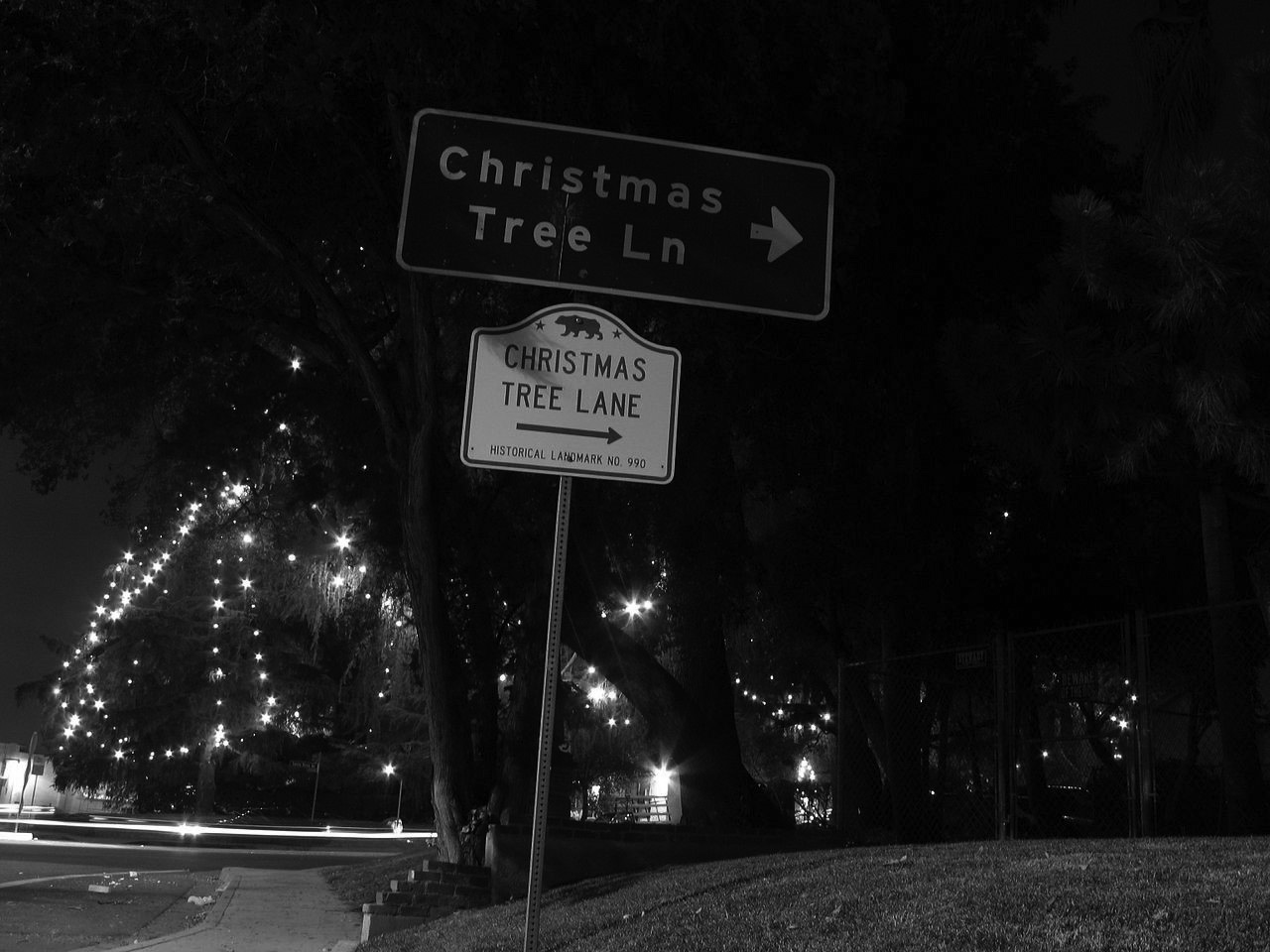 |
|
| (2006)*^ - Road and historical landmark sign for Christmas Tree Lane on Woodbury Road. Located on Woodbury near the junction of Santa Rosa Avenue, Altadena |
NO. 993 - WATTS TOWERS OF SIMON RODIA The Watts Towers are perhaps the nation's best known work of folk art sculpture. Using simple hand tools, cast off materials (glass, shell, pottery pieces and broken tile) Italian immigrant Simon Rodia spent 30 years building a tribute to his adopted country and a monument to the spirit of individuals who make their dreams tangible. Rodia's Towers inspired many to rally and preserve his work and protect it for the future. |
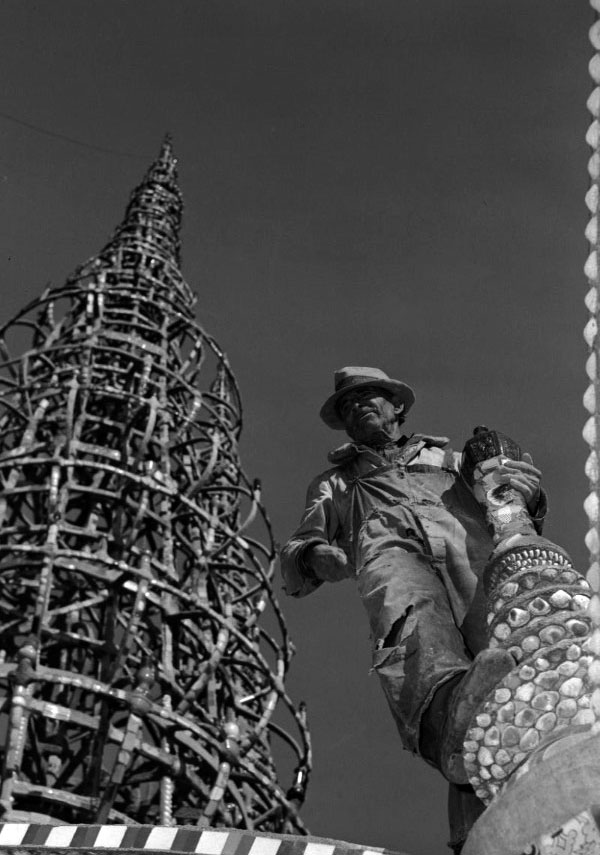 |
|
| (1953)#*^ – View of Simon Rodia standing high on his Watts Towers. |
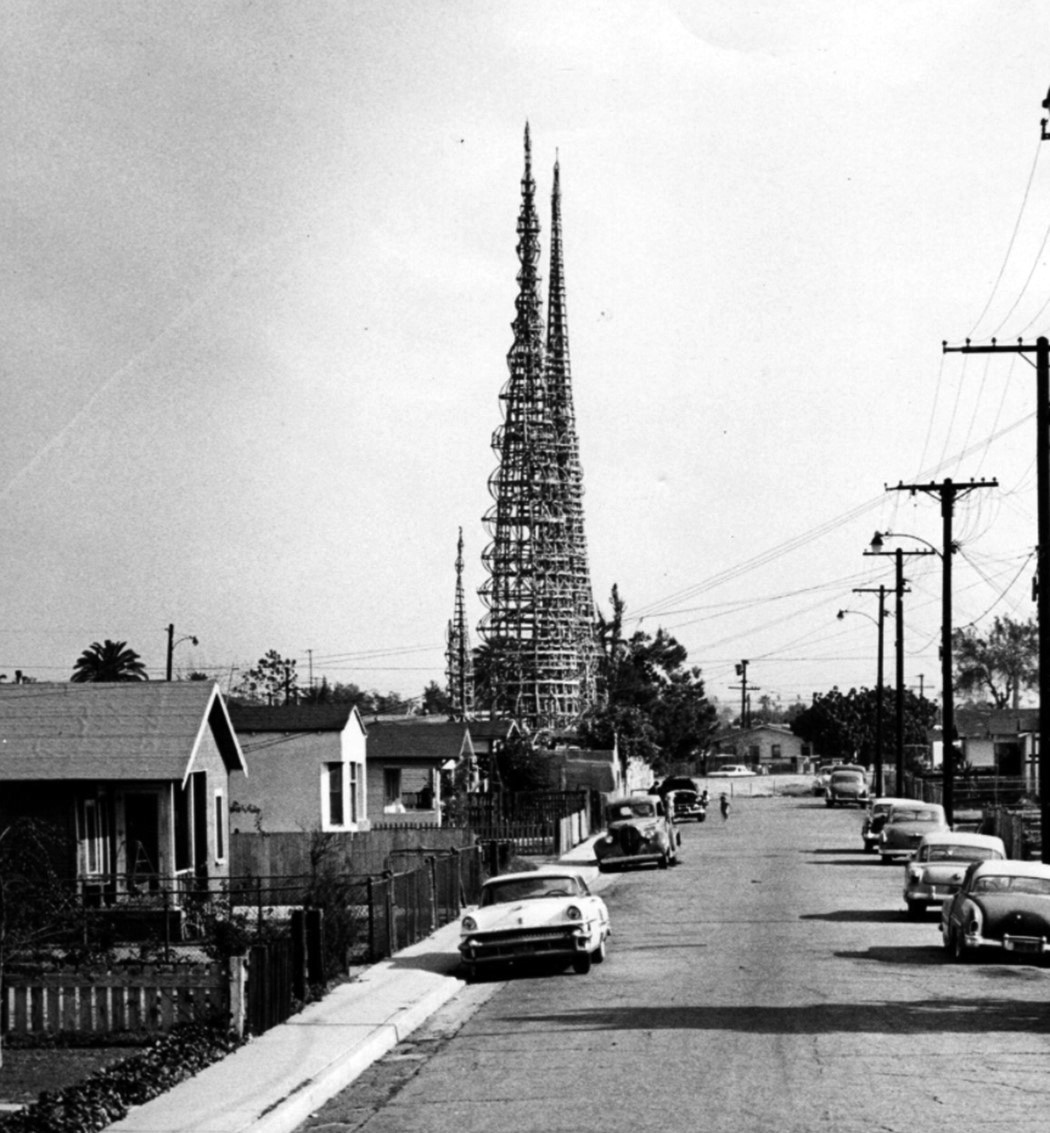 |
|
| (1960)* - The Watts Towers as seen from the Pacific Electric Red Car route, now the Metro Blue Line. |
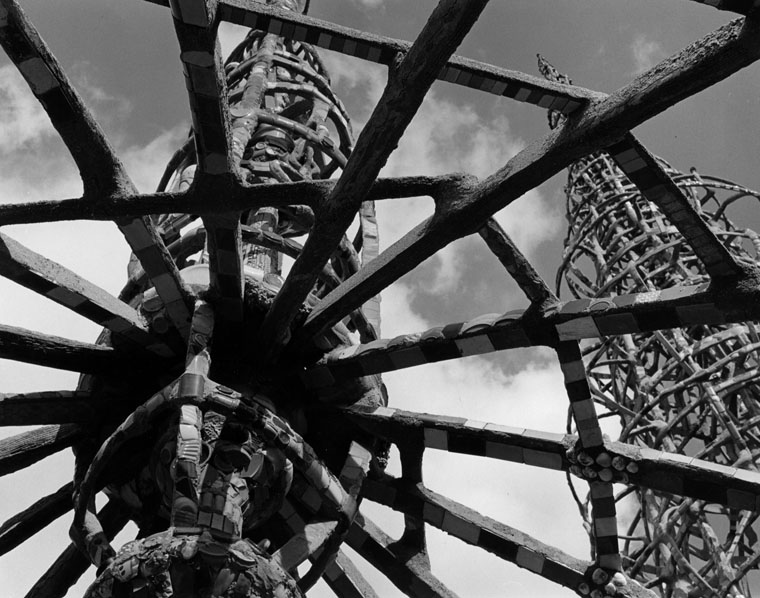 |
|
| (1964)* - Close-up view from the inside of one of the towers looking up. Location: 1765 East 107th St, Los Angeles. |
NO. 997 - TUNA CLUB OF AVALON The Tuna Club of Avalon marks the birthplace of modern big game sportfishing in 1898. Led by Dr. Charles Frederick Holder, the club's founding members adopted the rules of conduct stressing conservationist ethics and sporting behavior. Today, their work remains the basis for the sport's internationally accepted principles. |
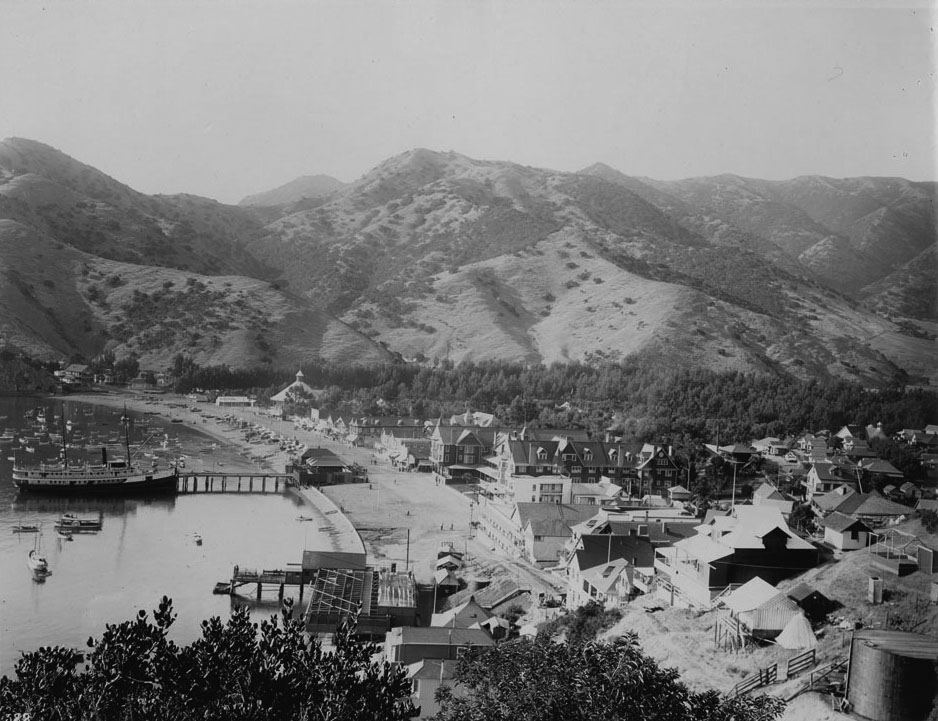 |
|
| (1908)^^ - View of the Tuna Club under construction on the shore of Avalon Harbor. The club can be seen in the foreground at center and is missing its roof. The harbor can be seen at left and is very calm. A large ship is docked at a wooden pier at left, while many small sailing vessels can be seen moored near the shore. The city of Avalon is at right and is composed of many small wooden buildings. A dense forest can be seen at the base of a steep hill in the background. |
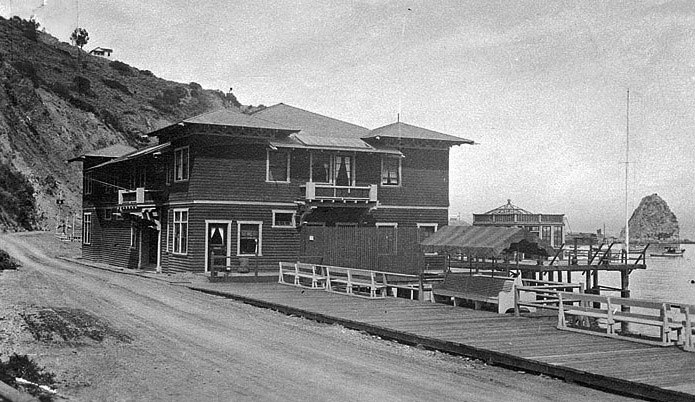 |
|
| (1928)^*# - Ground view showing the Tuna Club. In the background can be seen the 2nd Catalina Casino under construction adjacent to ‘Little Sugarloaf’ rock formation. |
Historical Notes Early members of the Avalon Tuna Club included Zane Grey, Bing Crosby, Charlie Chaplin, Stan Laurel, Hal Roach, Cecil B. De Mille, Theodore Roosevelt, Herbert Hoover, George S. Patton and Winston Churchill.*^ |
 |
|
| (ca. 1929)* - View of Avalon Bay across Crescent Bay, on Santa Catalina Island as seen from a mountain top. The Catalina Casino, surrounded by the sea on three sides, is visible at the edge of the bay. The S.S. Catalina is docked at the pier, with the Tuna Club just beyond it. Note that 'Little Sugarloaf' adjacent to the casino is no longer there (see previous photo). |
Historical Notes In March, 1929, Little Sugarloaf was blasted away to give what is now called Casino Point, the look that it offers today.**#* |
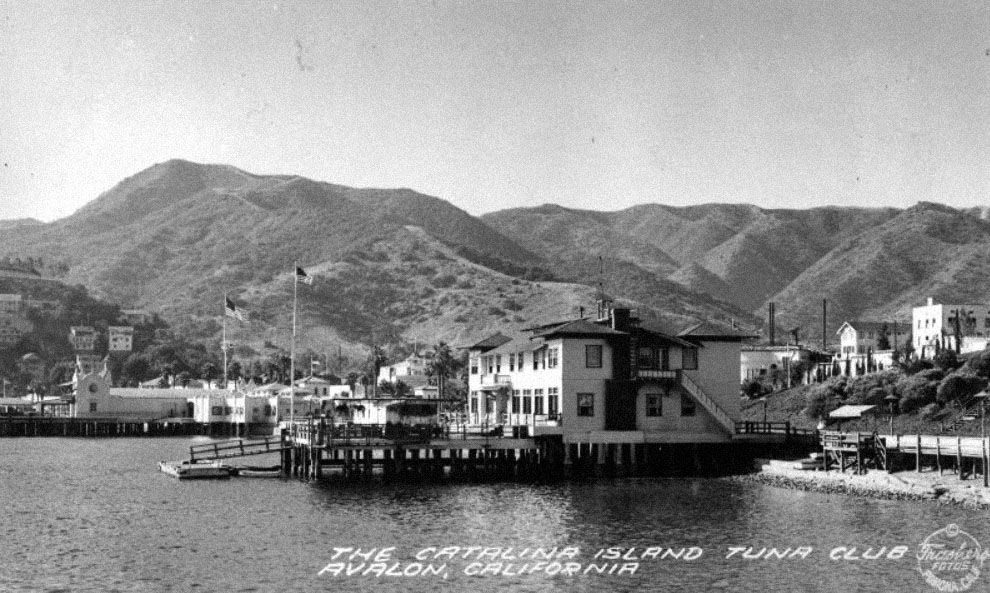 |
|
| (1938)#*^ – Postcard view of the Catalina Island Tuna Club, Avalon. |
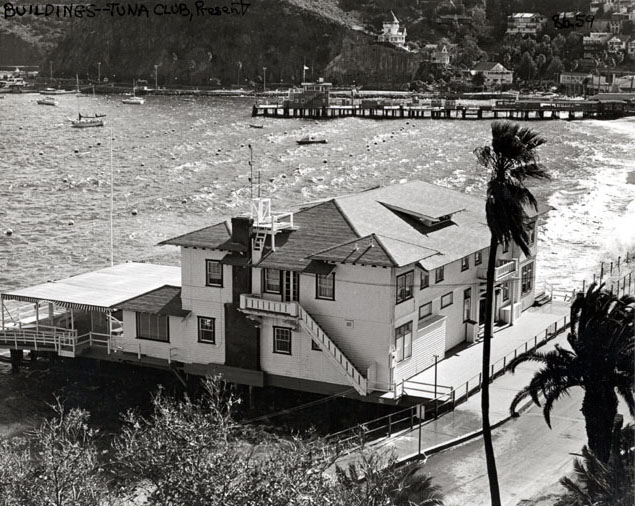 |
|
| (1984)#** - View of the Tuna Club and Avalon Bay. Location: 100 St. Catherine Way, Avalon. |
Click HERE to see more of Catalina in "Early Views of Catalina" |
NO. 1006 - BEALE'S CUT STAGECOACH PASS Beale's Cut is the only physical and cultural feature of its kind in the entire Los Angeles Basin. At the time of its construction in 1862, the actual creation and maintenance of the Cut was considered a significant technological and physical feat consisting of breaching the former impassable geographic barrier of the San Gabriel and Santa Susana Mountain ranges. General Edward F. Beale is attributed with the construction of a toll road across the mountains. Beale's Cut was also used as a favorite film-making location by pioneer film maker, David Wark Griffith, and others. |
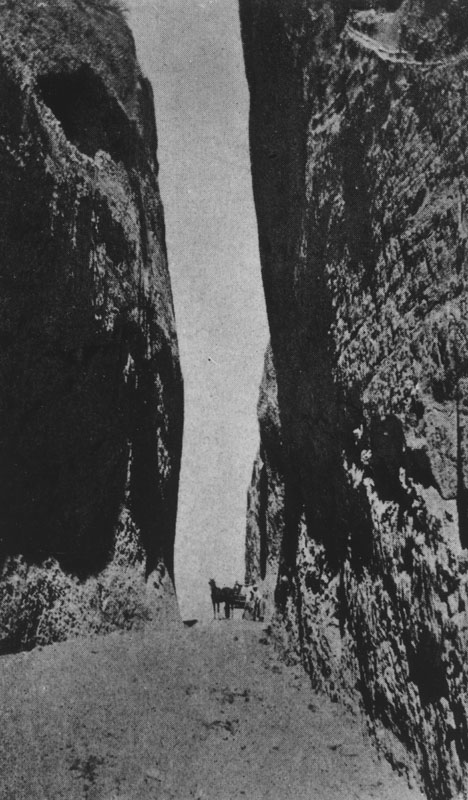 |
|
| (1870s)* - A horse and wagon is seen in Beale's Cut in the early days. It was an early access road cut by General Edward Fitzgerald Beale, a landowner and surveyor, who in 1863 made the 90 feet cut to get coaches through. Located in the Santa Clarita Valley in Los Angeles County, it is visible from the Sierra Highway, not far from the intersection of The Old Road and Sierra Highway, just after the first bridge under the Antelope Valley Freeway (State Route 14). The slot-like roadway appeared in many silent western movies. |
.jpg) |
|
| (ca. 1875)* - Freighting strings belonging to Remi Nadeau are captured here in Soledad Canyon. During the 1870's, Nadeau and his men hauled silver-lead bullion from the Soledad and Cerro Gordo mines to Los Angeles via Beale's Cut. Note the design of the wagons, tall and narrow. This enabled them to fit through the canyon passes such as Beale’s Cut, the only passable road cut through the San Gabriel and Santa Susana Mountain ranges. |
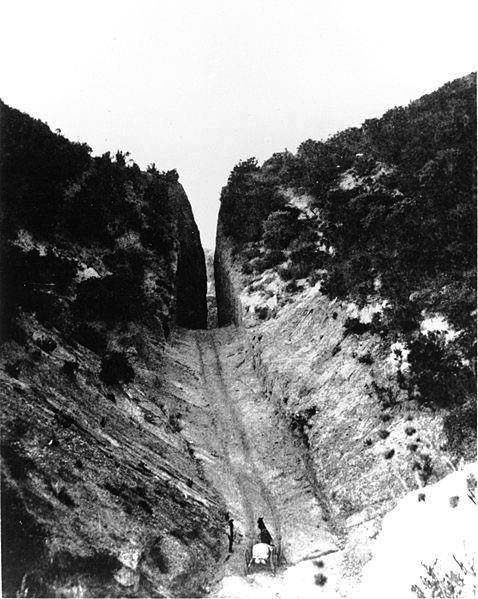 |
(n.d.)^** - View of a horse-drawn carriage making its way up toward Beale's cut. Note the grooves in the bedrock from all the years of traffic. Although the cut still remains, it is now only 30 feet deep, as it suffered a partial collapse.
|
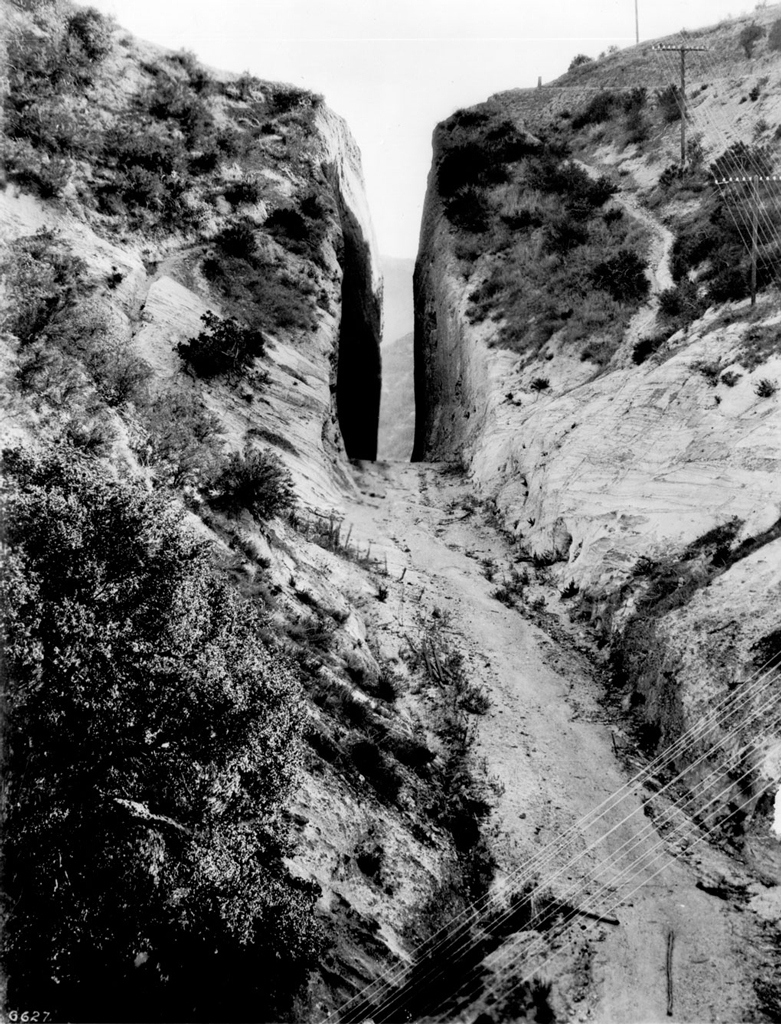 |
|
| (Early 1900s)^^ - Beale's Cut in the early 1900s. Location: Intersection of Sierra Hwy and Clampitt Rd, Santa Clarita. |
Click HERE to see more in Early Views of the San Fernando Valley |
NO. 1011 - FRANK LLOYD WRIGHT TEXTILE BLOCK HOUSES (THEMATIC), ENNIS HOUSE This house was designed by Frank Lloyd Wright and built in 1924 for Charles and Mabel Ennis. It is one of four textile block houses registered as Landmark No. 1011. |
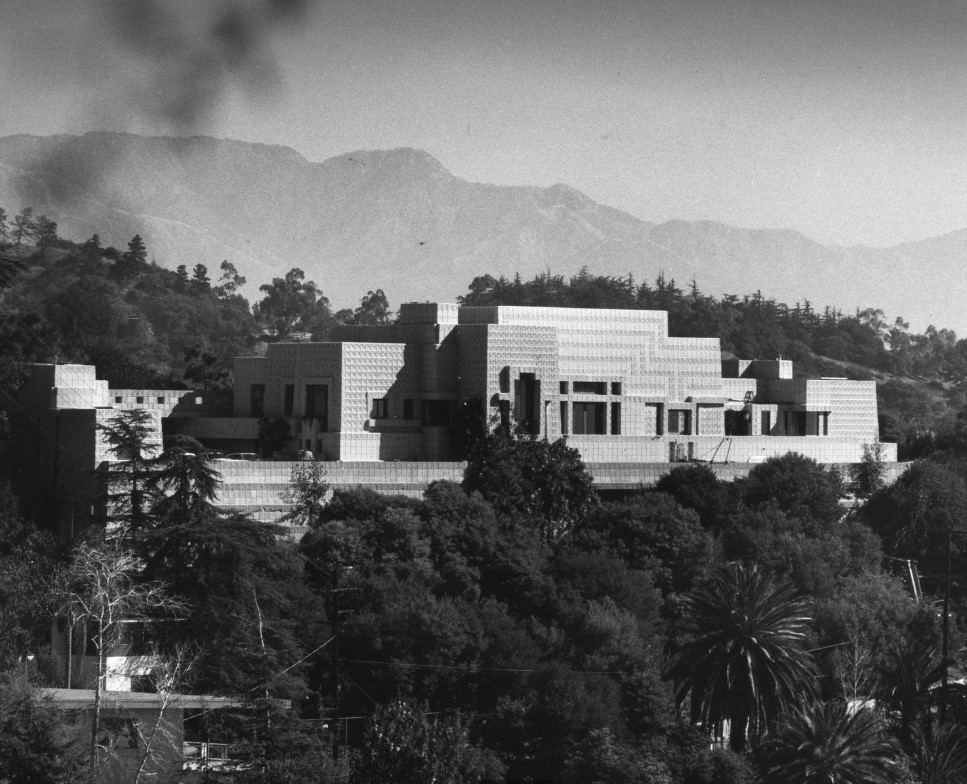 |
|
| (1953)^#^ - Exterior view of the Ennis House located at 2607 Glendower Avenue in Los Feliz, one of Frank Lloyd Wright's textile block houses built in 1924. Photo by Julius Schulman. |
Historical Notes The landmark Mayan Revival home was originally designed by Frank Lloyd Wright in 1923, and construction was handled by his son, Frank Lloyd. After costs soared, Wright left the project under unhappy conditions, and the home was completed without him in 1924.^*^# |
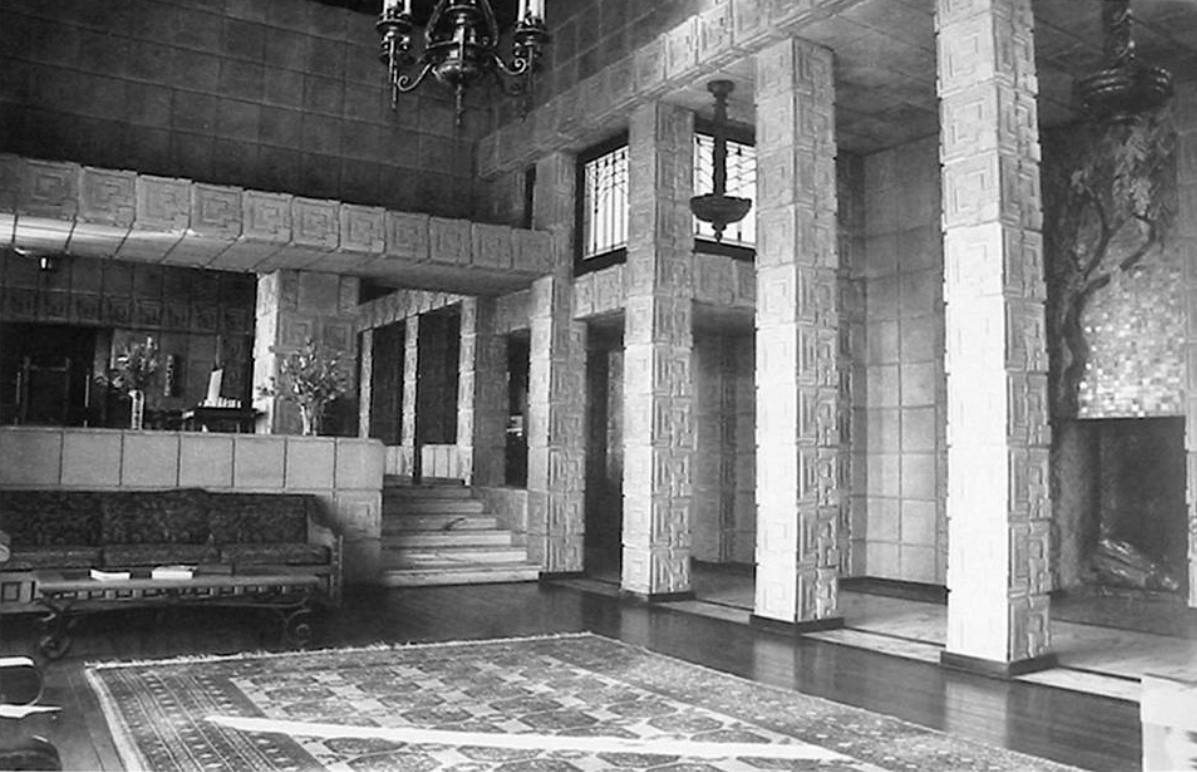 |
|
| (1926)^*^# – Interior view of the Ennis House, located at 2607 Glendower Avenue. |
 |
|
| (1980)* - Interior view of Ennis-Brown house showing vertical interiors with 16-inch concrete-block columns done in Maya Revival style. Architect: Frank Lloyd Wright. |
* * * * * |
NO. 1011 - FRANK LLOYD WRIGHT TEXTILE BLOCK HOUSE (THEMATIC), FREEMAN HOUSE The Samuel and Harriet Freeman House, designed by Frank Lloyd Wright and built in 1924, is one of four residences that were designed to be affordable and modular constructed using the cheap building material of concrete. These houses were constructed from a textile block system of handmade concrete tiles held in a matrix of steel bars, anchored and protected by a concrete mixture, and stacked without grout. |
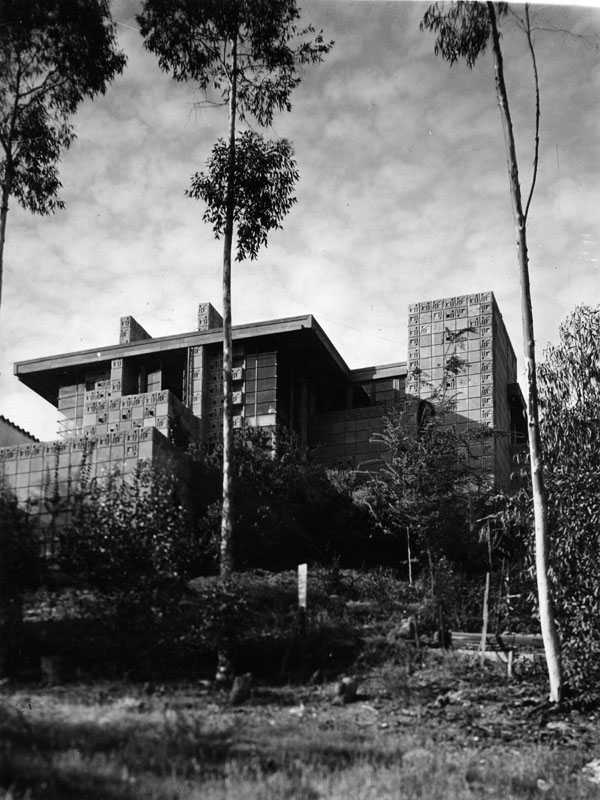 |
|
| (1928)* - Exterior view of Freeman House, a textile block house located at 1962 Glencoe Way, in Los Angeles. Home built in 1924. Architect: Frank Lloyd Wright. The free-standing furniture and built-in was designed by Schindler in 1927. |
* * * * * |
NO. 1014 - LONG BEACH MARINE STADIUM Created in 1932 for the rowing events of the Xth Olympiad, the Stadium was the first manmade rowing course in the United States. Its width allowed four teams to race abreast, eliminating additional heats and allowing oarsmen to enter the finals at the peak of their form. Later it served as the venue for the 1968 and 1976 United States men's Olympic rowing trials and the 1984 United States women's Olympic rowing trials. The site remains an important training and competitive center for rowers, including our National and Olympic teams. |
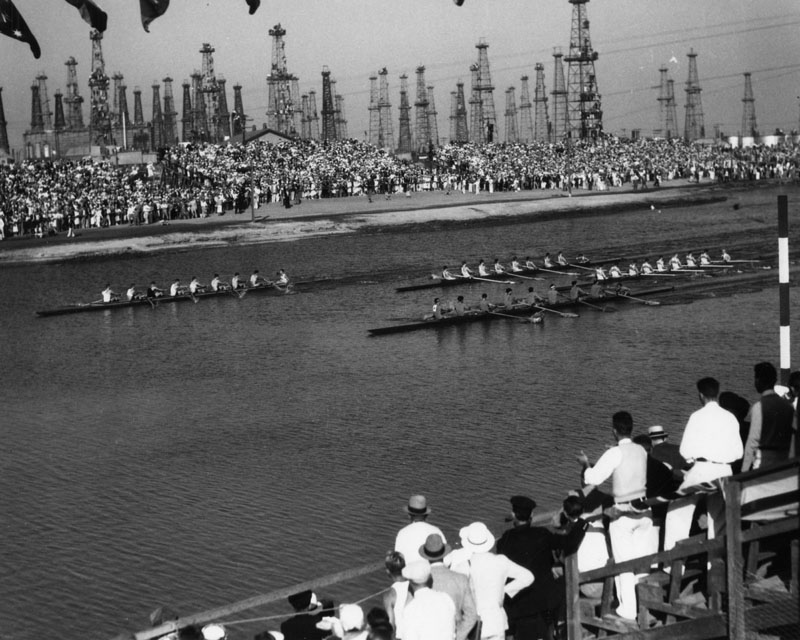 |
|
| (1932)* - Spectators attentively watch as four rowing teams with coxswains compete in the 8 oar rowing event at the Long Beach Marine Stadium during the 1932 Olympic Games. The area's oil richness is revealed by the numerous derricks present behind the stadium. Location: Pete Archer Rowing Center, End of Boathouse Lane, Nieto Ave & Appian Way, Long Beach. |
NO. 1018 - MANHATTAN BEACH STATE PIER Designed by City Engineer A.L. Harris, this pier was constructed by the City of Manhattan Beach during the years 1917-1920. The roundhouse building was added a year later. Harris' innovative design featured a rounded end to the pier, which helped it withstand the pounding of the Pacific. Although the roundhouse was reconstructed in 1989, the pier itself survives as Southern California's oldest remaining example of early reinforced concrete pier construction. |
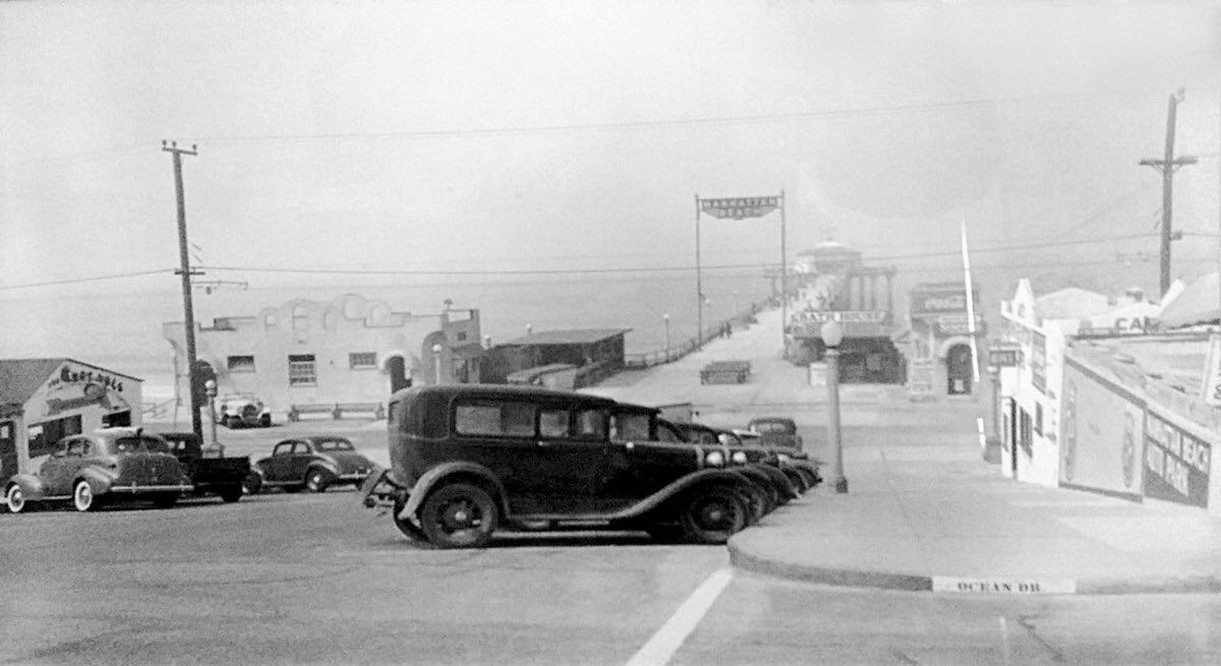 |
|
| (1940)* - Manhattan Beach Boulevard and Ocean Drive, with Manhattan Beach Pier in the background. |
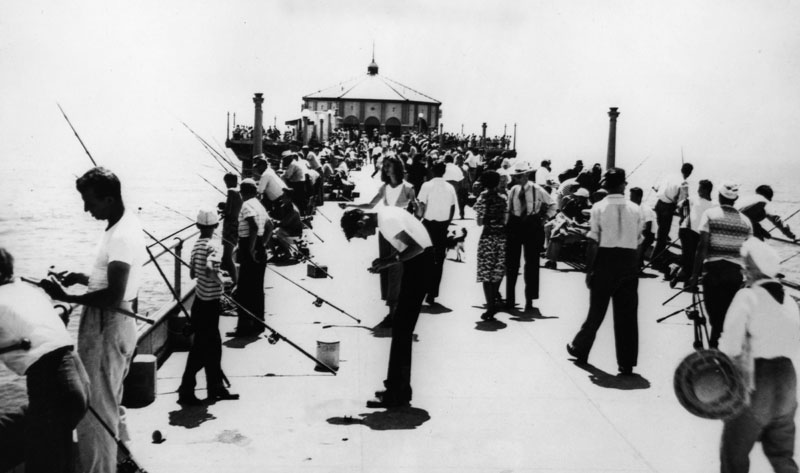 |
|
| (n.d.)* - Fishing from the Municipal Pier, Manhattan Beach, California. Location: West of Manhattan Beach Blvd, Manhattan Beach. |
NO. 1021 - LIBERTY HILL SITE In 1923 the Marine Transport Workers Industrial Union 510, a branch of the Industrial Workers of the World (IWW), called a strike that immobilized 90 ships here in San Pedro. The union protested low wages, bad working conditions, and the imprisonment of union activists under California's Criminal Syndicalism Law. Denied access to public property, strikers and their supporters rallied here at this site they called "Liberty Hill." Writer Upton Sinclair was arrested for reading from the Bill of Rights to a large gathering. The strike failed but laid a foundation for success in the 1930s. The Syndicalism Law was ruled unconstitutional in 1968.
|
NO. 1038 - Hay Tree The Hay Tree is an old, 50 foot high camphor tree standing in the middle of a grassy area in downtown Paramount. The tree is a rare remnant of the city’s once thriving dairy and hay industry. The towns of Hynes and Clearwater, which later incorporated to become Paramount, were in the middle of Los Angeles County’s extensive region of dairy farms that thrived during the first half of the twentieth century. Hynes-Clearwater was the “Hay Capital” of the world from about 1930 to about 1960. There are no other properties in Paramount that are linked to the hay industry except for this tree. |
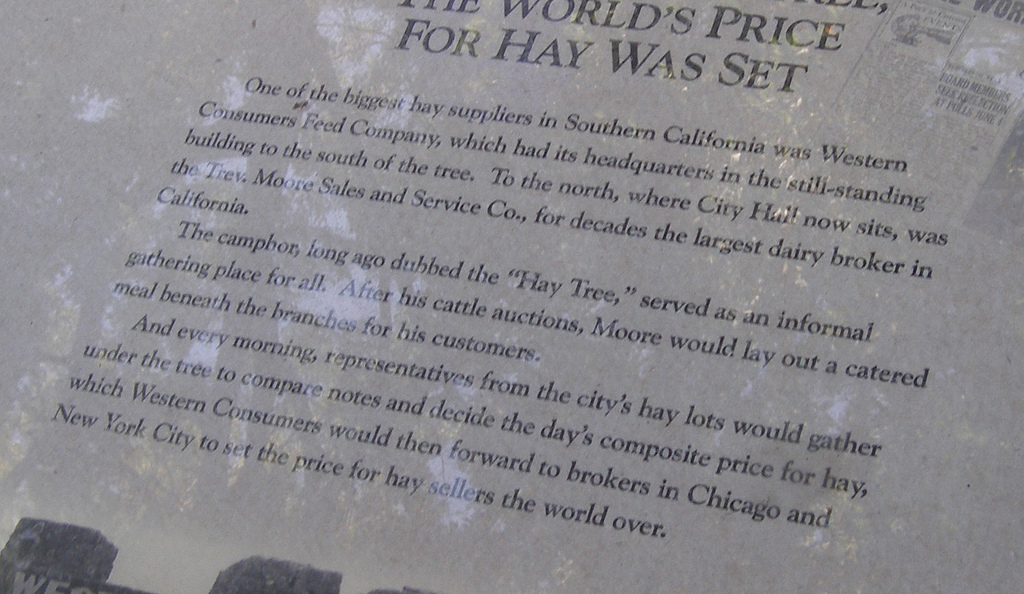 |
|
| (2007)^* - Paramount Hay Tree Plaque. Location: 16475 Paramount Blvd., Paramount. |
NO. 1041 - Site of the Childhood Home of the Beach Boys It was here that the childhood home of Brian, Dennis, and Carl Wilson developed their unique musical skills. During Labor Day weekend 1961, they, their cousin Mike Love, and a friend Al Jardine, gathered here to record a tape of their breakthrough song “Surfin’.” This marked the birth of the rock group known worldwide as the Beach Boys, and the beginning of an historic musical legacy. The music of the Beach Boys broadcast to the world an image of California as a place of sun, surf, and romance. |
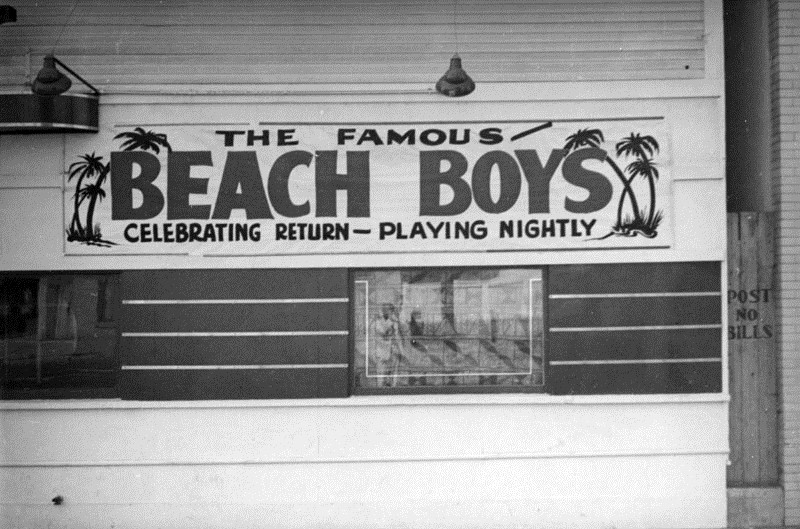 |
|
| (n.d.)* - A sign on a Streamline Moderne nightclub reads "The famous Beach Boys celebrating return - playing nightly." |
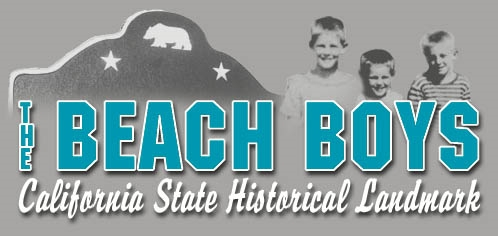 |
|
| Location: The Wilsons' California house, Hawthorne, where the Wilson brothers grew up and the group began, was demolished in 1986 to make way for Interstate 105, the Century Freeway. A Beach Boys Historic Landmark (California Landmark #1041 at 3701 West 119th Street), dedicated on May 20, 2005, marks the location.*^*^ |
* * * * * |
Please Support Our CauseWater and Power Associates, Inc. is a non-profit, public service organization dedicated to preserving historical records and photos. Your generosity allows us to continue to disseminate knowledge of the rich and diverse multicultural history of the greater Los Angeles area; to serve as a resource of historical information; and to assist in the preservation of the city's historic records.
|
More Historical Early Views
Newest Additions
Early LA Buildings and City Views
History of Water and Electricity in Los Angeles
* * * * * |
References and Credits
^ California Historic Landmark Listing (Los Angeles)
* LA Public Library Image Archive
**DWP - LA Public Library Image Archiv
^#Oviatt Library Digital Archives
#^San Fernando Valley History Digital Library - CSUN Oviatt
#+LA Times Framework: Christmas Tree Lane
^*Flikr: Hay Tree Plaque - L. Avacado; Point Dume - Mr. Tofu 1017
^**San Fernando Valley Relics - Facebook.com: Beale's Cut
^*#California State Library Image Archive
^^*Redondo Beach Patch: Our Own Great Salt Lake
*#*SCVHistory.com: The Story of Mentryville
^#^Flickr.com: Michael Ryerson
*#^LAPL-El Pueblo de Los Angeles Historical Monument Photo Archive
**#Mentalfloss.com: A Utopian Ghost Town in the California Desert
*^#Los Angeles Visionaries Association: El Ranchito
*^*Awesome Stories.com: Power Plant - Pomona, First in California
**^USDA - Angeles National Forest Chilao Visitor Center
**#San Fernando Valley Landmarks: Valley Relics-flickr.com
^*#Noirish Los Angeles - forum.skyscraperpage.com; Japanese Internment; Tuna Club
#*^Calisphere: University of California Image Archive
#**LA County Library Image Archive
*^*^Pinterest.com: Bertrand Lacheze
^x^Facebook.com: Photos of Los Angeles
^xx^Dominguez Hills Digital Archive
^*^#Facebook.com - Bizarre Los Angeles
^*#*Huntington Palisades - A Brief History
**#*Creating a Landmark: the Historic Casino Point
^##*Inthecanyon.com: History of Santa Monica Canyon
^^#^Facebook.com - Great Photos from Los Angeles' Past: D.W. Griffith Ranch Historical Marker No. 716
#^*^Facebook.com: West San Fernando Valley Then And Now
#*^#Google Maps and Street Views
*^*^*Los Encinos State Historic Park: historicparks.org
*^^ The Historical Marker Database: Western Hotel; Dominguez Ranch House; Portuguese Bend Whaling Station; Rancho San Franciscio
*^ Wikipedia: Beach Boys; University of Southern California; LA Memorial Coliseum; Harold Lloyd Estate; Lummis House; Arcadia, California; Rancho San Francisco; Gaspar de Portolà; George Stoneman; D. W. Griffith; Yiorgos Caralambo; Pio Pico; Campo de Cahuenga; Signal Hill; Los Encinos State Historic Park; 1910 L.A. International Air Meet at Dominguez Hills; Tuna Club of Avalon
< Back
Menu
- Home
- Mission
- Museum
- Major Efforts
- Recent Newsletters
- Historical Op Ed Pieces
- Board Officers and Directors
- Mulholland/McCarthy Service Awards
- Positions on Owens Valley and the City of Los Angeles Issues
- Legislative Positions on
Water Issues
- Legislative Positions on
Energy Issues
- Membership
- Contact Us
- Search Index